A FRICTIO NLESS FUTURE FOR RETAIL?
How



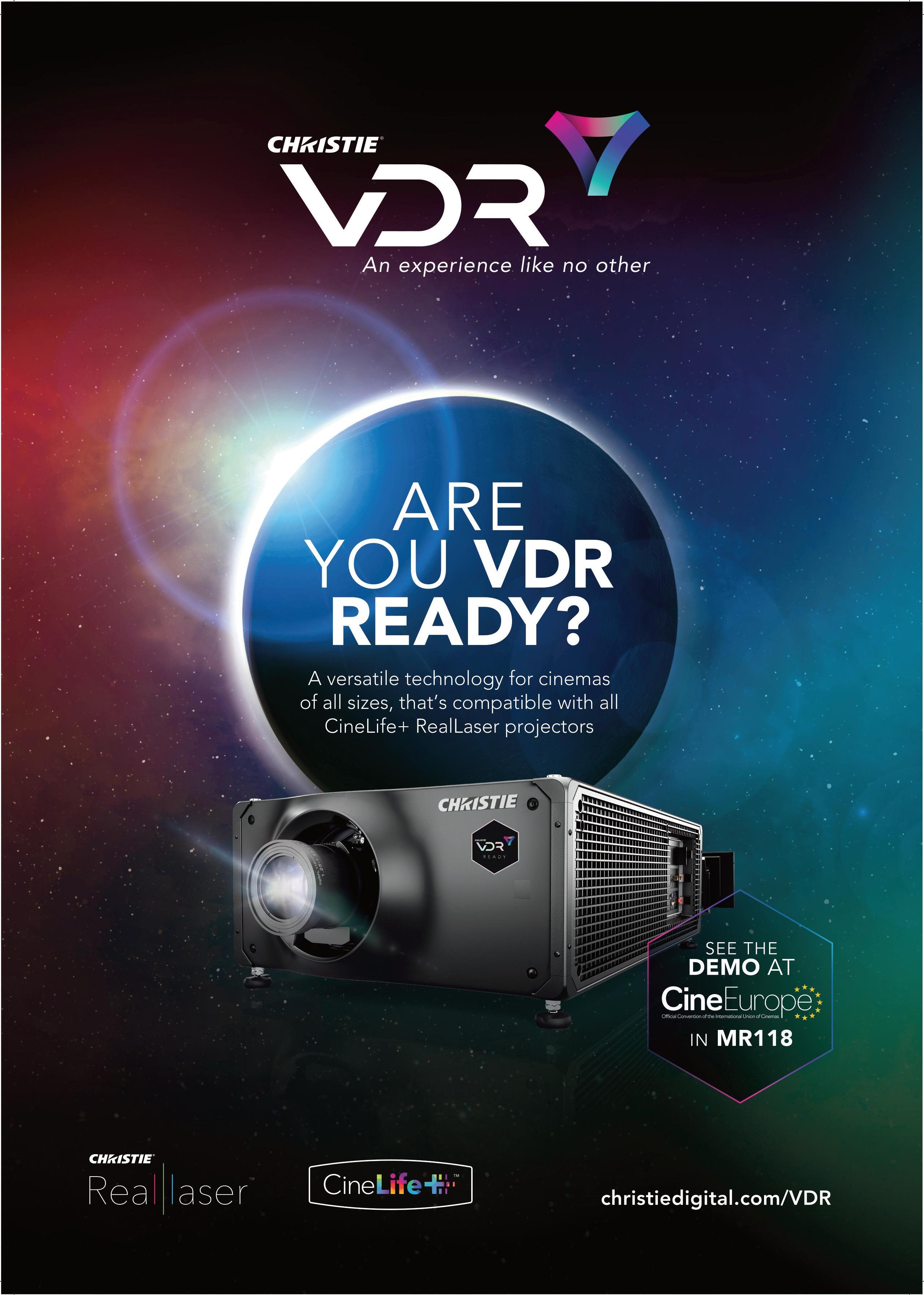
E D'S NOTE
RICHARD MITCHELL, PRESIDENT, CINEMA TECHNOLOGY COMMUNITY.
What a difference a couple of months has made. Whilst there was a sense of optimism at CinemaCon, the disappointing poor first quarter in terms of box office revenue hung over Las Vegas and meant that discussions were more focused around the near term challenges rather than mid to long term strategy.
A week later, the box office explosion of The Minecraft Movie changed the narrative surpassing many people’s expectations and in the process more than doubling the cumulative gross for the Domestic US market versus 2024. Since then, the mood of the industry seems to have changed dramatically with a number of major releases on the horizon set to really start the comeback. It appears that for the first time in a long time, the industry, is looking forward and positive harmoniously…long may it continue!
And with that sense of positivity, the industry will descend upon Barcelona for CineEurope where the discussions will hopefully now focus around planned investments designed to improve the moviegoing experience, with a strong lean on technology.
As always, this edition of the publication is our favourite, where we get to look back at recent industry trends and events, some topical issues (such as the Trump Tariffs) and hopefully provide our readers and members with a broad depth of articles focused around technology and business opportunities.
In this edition we’ve continued our focus on innovation covering topics such as laser projection
It appears that for the first time in a long time, the industry, is looking forward and positive harmoniously… long may it continue!

including a Q&A regarding Christie’s VDR solution that hopefully answers a number of key questions, the postproduction process, and the pursuit of an All Digital B-Chain. We’ve also looked at innovation in cinema exhibition by visiting the original Oma Cinema in Cannes (France) and Movie Houses in Northern Ireland to showcase innovation in Europe. With the noise continuing to grow, we’ve taken a first look at the future of retail, both through the eyes of Amazon’s Just Walk Out Technologies and at a real-world example of a completely frictionless solution deployed at scale in California. There’s also a range of articles around Sustainability, AI and Post Production.
We hope that this edition provides the perfect accompaniment for those visiting Cine Europe helping you to maximise your visit and add value to your discussions.
As always, the CTC team will be at CineEurope in force, so make sure you look out for our team sporting their CTC pin badges or you can set up a meeting by emailing cineeurope@cinema-technology.com. And as always, if you know of any interesting stories for future editions, do get in touch with our Commissioning Editor, Peter Knight, and we’d be delighted to cover them: peter.knight@cinema-technology.com.
CINEMA TECHNOLOGY


CTC PRESIDENT: RICHARD MITCHELL richard.mitchell@cinema-technology.com
ART DIRECTOR: DEAN CHILLMAID dean.chillmaid@cinema-technology.com
COMMISSIONING EDITOR: PETER KNIGHT peter.knight@cinema-technology.com
ADVERTISING: SANDIE CAFFELLE sandie.caffelle@ cinema-technology.com
SUBSCRIPTIONS:

CINEMA TECHNOLOGY CONTENTS

AMC THEATRES UNVEILS ITS FIRST XL AT AMC AUDITORIUMS
Continuing Its ongoing commitment to elevate the moviegoing experience through the AMC Go plan. 15
BARCO DEBUTS NEW SMART CINEMA AMPLIFIER AND INTEGRATED MEDIA SERVER
New technologies unveiled at CinemaCon 2025 designed to work seamlessly with Barco Series 4 projectors.

KEY FEATURES
EVERYBODY'S TALKING ABOUT CINEMA
Comscore's Lucy Jones looks at the year to date for European cinema and the opportunities that lie ahead. 24
TARIFFS, TRADE WARS, TAX, TECH...AND TALKS
David Hancock of Omdia takes a look at the impact President Trump's trade war and tariffs will have on the movie industry. 28
AI IN ACTION
A look at how cinema exhibitors around the world are utilising AI to drive better cinema-going experiences and business outcomes.
30
IS FRICTIONLESS RETAIL COMING TO CINEMA?
Amazon explains why their Just Walk Out technology could be a genuine game changer for cinema retail. 32
NO QUEUES, NO LINES. NO CASHIERS.
How the Intuit Dome, the home of the LA Clippers has used technology to create a totally frictionless retail solution that retains the personal element. 39
POST PRODUCTION: PART TWO
In this second part, Andy Quested looks at compatibility and how object-based methodolgies can improve the workflow.
44
FROM VISION TO REALITY - A NEW CINEMATIC EXPERIENCE
Peter Knight travels to Cannes to visit the original Oma Cinema site to discover how this unique design concept is enticing audiences. 50
LASER PROJECTION: PART THREE
In this latest installment, Peter Wilson talks to representatives from exhibition and post-production about their early experiences with RGB projection.
EVERYTHING YOU NEED TO KNOW ABOUT CHRISTIE VDR
CTM talks to Ben Wagner at Christie to learn more about Christie's predominantly software-based solution to improve image quality.
IN SEARCH OF THE ALL-DIGITAL B-CHAIN
Mark Mayfield of Meyer Sound makes the case for an All-Digital B-Chain and why it might help improve audio quality.
SPOTLIGHT ON MOVIE HOUSE CINEMAS (NORTHERN IRELAND)
Sandie Caffelle talks to founder Michael McAdam about his unique cinemas and the challenges of running family entertainment centres.




CTC UPDATE
WORDS: RICHARD MITCHELL, PRESIDENT, CTC
The Return of CTC Training Courses
Since the last publication, the team has been incredibly busy working on new initiatives designed to help share knowledge with our near-1000 strong global membership base. Our “Things You Need To Know” series was well received and we have had requests for further episodes and for these to be localised. We continue to restate that education remains at the heart of what CTC does and having promised to provide a revised version of our presentation excellence training course in early summer, we’re delighted to announce that this first course will be held in London on 24th June at the “Cinema In The Power Station”. The course content has been revised and updated to include requests we’ve received from partners, members and exhibitors and covers areas such as Picture and Sound Perfection, Event Cinema, KDMs and TMS operation. Tickets are priced at just £75 and can be booked by visiting www.cinema-technology.com/ training. Beyond this initial date, we intend to take this course across the UK and are investigating locations in Europe to help our global members benefit from the team’s expertise.
An Eye On Technology
Over the past two years, CTC through this publication has diverted much focus in to the use of Artificial Intelligence within all parts of the sector and the way it’s transforming the workflows and
CTC EXECUTIVE TEAM
RICHARD MITCHELL (PRESIDENT), GRAHAM LODGE (VICE PRESIDENT), JOSEPH BOUTROS, MIKE BRADBURY, SANDIE CAFFELLE, CHRIS CONNETT, MARK KENDALL, PETER KNIGHT, ADAM MACDONALD, SAUL MAHONEY, JENNIFER MORGAN, ANDRE MORT, MARKUS OVERATH, LOYS PHILIBERT, DAVID POPE, TONI PURVIS, ULF QVICKLUND, SIMON TANDY, KRISTINA WARNER, PAUL WILLMOTT.
processes of the industry. We recently released a white paper focused specifically on the exhibition sector showcasing a number of use cases for AI and how it’s driving better movie-going experiences. A summary of this document is presented in the magazine and the full white paper is available to CTC members through the QR code found on page 29.
The Voices of Cinema
After a very short hiatus, the podcast team reunited ahead of CineEurope for another episode of In The Pub with Mike Bradbury with special guest Rob Younger (Parkway Cinemas) where they discussed a number of interesting topics including the resurgence of film-based projection. The team will be back together at CineEurope so look out for another fascinating and fun episode in July!
As we head in to the second half of the year, CTC will switch it’s focus to supporting local events culminating with the Norwegian Cinema Conference this year in Kristiansand in early November but rest assured we’ll be delivering a wide array of content to keep you learning.

CTC ADVISORY COUNCIL
MARK CHRISTIANSEN (PARAMOUNT PICTURES), BRIAN CLAYPOOL, JOHN DOWSLAND, THERESA ENGLISH (TK ARCHITECTS), MARK DE QUERVAIN (INDY CINEMA GROUP), JAN RASMUSSEN (NORDISK FILM), DOMINIC SIMMONS (BFI), ALICE TENTORI (DIGIMA), JULIA VINOKUROVA (REALD).
CTC is delighted to announce the return of its highly successful projection and presentation course. Following feedback from exhibitors and partners, this course has been updated to include areas of interest including TMS operation.
Aimed at cinema managers and operators, this course which is delivered by industry experts, aims to provide hints and tips on how to improve and maintain the overall experience for movie goers and ensure that they receive the best possible presentation of a movie.
AREAS COVERED INCLUDE
Picture and Sound Perfection
Testing and Test Materials
Measuring Screen Brightness
Understanding File Naming Convention
Keys and padlocks
Understanding KDMs
Accessibility
Theatre Management Systems
Event Cinema
Satellite Reception
WHEN: 24TH JUNE 2025
WHERE: CINEMA IN THE POWER STATION, LONDON TIME:
09:30 - 15:00
COST: £75 PER PERSON
IMIS VIEW
WORDS: DAVID POPE, PRESIDENT, IMIS
President’s Perspective
Let’s make 2025 a year of bold ideas and boundarypushing creativity. I can’t wait to see what we’ll build together.
As we move through 2025, I’ve been struck by the energy and creativity shining through our IMIS community. Our recent Student Showcase was a real highlight — a day full of fresh ideas and inspiring voices from emerging talents and industry icons alike. It was a powerful reminder of what we can achieve when we come together.
Looking ahead, I’m excited about our new partnership with Soho Media Club and the events we have in store, including our special Autumn session on Metamerism — a must for anyone passionate about the art and science of moving images.
Let’s make 2025 a year of bold ideas and boundary-pushing creativity. I can’t wait to see what we’ll build together.
A Huge Success!
A big thank you to everyone who joined us for the IMIS Student & Member Showcase 2025 on 29 May at the Odeon Tottenham Court Road— what a fantastic event!
The day was made even more special by a series of inspiring on-stage interviews: Fatima Salaria, Basma Khalifa, and Chris Munro shared invaluable insights about their creative journeys, career challenges, and the future of the industry.

These lively conversations, expertly hosted by Omar Mehtab, sparked some powerful reflections and new ideas among our audience.
We were blown away by the talent, passion, and fresh ideas shared by the next generation of moving image creators.
The event not only celebrated achievements of students from IMIS accredited universities -
Bournemouth and Roehampton but also sparked inspiring conversations between emerging voices and seasoned industry professionals.
Stay tuned — highlights and projects will be featured soon on movingimagesociety.net!
New Partnership: IMIS and Soho Media Club
We’re thrilled to announce a new partnership between IMIS and Soho Media Club, the vibrant network connecting creative talent across the UK media scene.
Together, we’ll be developing joint events and initiatives designed to spark fresh collaborations and support the next wave of media innovators.
This partnership marks an exciting step in our commitment to building stronger bridges across creative communities. Watch this space for announcements!
Mark you calendars: Exploring Metamerism – Autumn 2025
IMIS will be hosting an exclusive event this autumn focused on Metamerism — a critical topic at the intersection of colour science, display technology, and content creation.
As the industry continues to evolve with new display formats and visual standards, understanding metamerism has never been more important. This event will bring together leading experts, technologists, and creatives to unpack the implications and explore solutions.
Details coming soon — mark your calendars for this must-attend technical deep dive!

CT NEWS RE E L
UP-TO-DATE ROUND-UP OF THE GLOBAL INDUSTRY
Arts Alliance Media Unveils a Bold New Look to Producer with Dark Mode and Tablet-Ready Interface
ARTS ALLIANCE MEDIA (AAM), a global leader in digital cinema software and support services, recently launched Producer’s most progressive visual update since deployment to reinforce its position as the world’s leading Enterprise Theatre Management System (TMS).
First introduced to market in 2017, Producer is a powerful circuit management platform that enables exhibitors to seamlessly schedule and manage content across all sites within their network from a single, centralised dashboard.
Reflecting AAM’s commitment to delivering a premium, user-focused software experience, Producer users can now switch between the classic light mode and a brand-new dark mode interface, designed to reduce eye strain and enhance usability in low-light environments. In addition, Producer’s familiar dark blue accents have been refreshed to a brighter, more vibrant shade of blue. This modernised colour palette not only provides a cleaner, more contemporary aesthetic but also enhances interface clarity, improving overall usability.
The update also brings full responsive support for tablet devices, allowing users to manage circuits and content on the move. Whether in the office, on-site, or in transit, Producer now offers greater flexibility and convenience than ever before.
“We remain committed to evolving Producer

in line with the needs of modern exhibitors,” explained Alan Bowen, CEO of Arts Alliance Media. “With this latest update, we’ve combined meaningful UX enhancements with the unmatched functionality our users rely on, further reinforcing Producer as a powerful, future-ready solution.”
By leveraging the site-level data of Screenwriter, AAM’s flagship Theatre Management System (TMS) which is installed locally at each cinema, Producer empowers exhibitors to achieve significant time savings and operational efficiencies. By centralising workflows
from Head Office or their flagship location, exhibitors can reduce the administrative burden at site-level while enabling staff to be reassigned to more valuable, customer-facing roles.
Stephany Villegas, Product Manager of Producer, added, “This update marks the next step in Producer’s evolution. In addition to a suite of visual enhancements, we’ve focused on delivering a more responsive and accessible interface, improving performance across devices while maintaining the depth of functionality that sets Producer apart.”
AMC Theatres Unveils Its First XL at AMC Auditoriums
Continuing Its Ongoing Commitment to Elevate the Moviegoing Experience Through the AMC Go Plan CINEMA PROJECTION AND PRESENTATION FUNDAME
AMC THEATRES (NYSE:AMC), announced that it has opened the Company’s first two XL at AMC auditoriums, both in the Kansas City market. The Extra-Large Format (XLF) experience is officially branded and available to AMC guests for the first time ever at AMC DINE-IN Studio 28 in Olathe, Kan., and AMC DINE-IN Prairiefire 17 in Overland Park, Kan.
This “XLF” experience features a wall-to-wall screen of at least 40 feet wide and 4K Laser projection, powered by Barco.
Moviegoers can expect to see the biggest blockbusters on XL at AMC screens, in 2D and 3D formats. The XL at AMC experience will also allow more large-screen programming flexibility at AMC when multiple blockbusters are playing in theatres that also contain a Premium Large Format (PLF) screen.
This new XL at AMC initiative is designed to
make it easier for guests to identify the largest nonPLF auditorium in theatres that have screens at least 40 feet wide.
Every XL at AMC auditorium receives a branded entry, and easy-to-identify branding on the AMC website and mobile app.
The XL at AMC auditorium is the latest innovation under the AMC Go Plan, the company’s forward-looking strategy to invest in and reimagine the theatrical experience for guests nationwide. From more and better PLF experiences, to luxury seating and cutting-edge laser projection, to dynamic new food and beverage offerings, AMC is focused on delivering unmatched comfort, quality, and immersion.
AMC expects to unveil up to 50 XL at AMC locations by the end of 2025.
Adam Aron, Chairman and CEO of AMC Theatres, commented on the launch:
FORTHCOMING ONE-DAY TRAINING COURSE
24TH JUNE 2025 - THE CINEMA IN THE POWER STATION, LONDON REGISTRATION: 09:30 COURSE ENDS: 15:00
CTC is delighted to announce the return of its highly successful projection and presentation course Following feedback from exhibitors and partners, this course has been updated to include areas of interest including TMS operation
Aimed at cinema managers and operators, this course which is delivered by industry experts, aims to provide hints and tips on how to improve and maintain the overall experience for movie goers and ensure that they receive the best possible presentation of a movie
Areas covered include:-
• Picture and Sound Perfection
• Testing and Test M aterials
• Measuring Screen Brightness
• Understanding File Naming Convention
• Keys and padlocks
• Understanding KDMs
• Accessibility
• Theatre M anagement Systems
• Event Cinema
• S atellite Reception
Refreshments and Lunch Included
Book your place online by visiting:
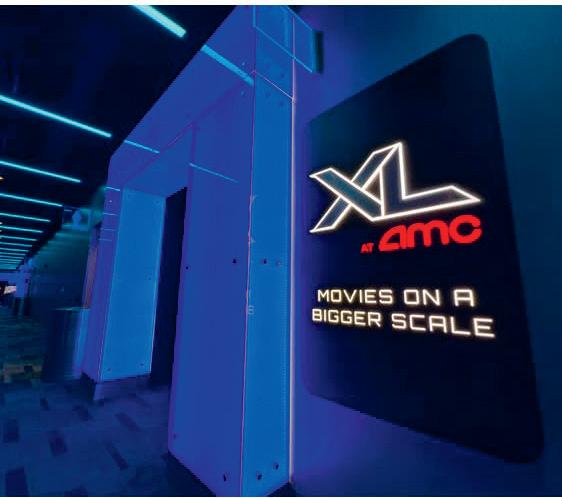
“XL at AMC is the next evolution in ensuring our guests know where they can find the largest screens at our theatres. We are excited to open our first XL auditoriums right here in our home state of Kansas, as we execute on the AMC Go Plan and reaffirm our commitment to redefining what it means to go to the movies.”


TOHO Cinemas and IMAX Expand Partnership With Six New IMAX With Laser Locations Across Japan
Post CinemaCon, TOHO CINEMAS AND IMAX CORPORATION announced an agreement to expand their partnership with six new IMAX With Laser systems across Japan. Under the agreement, IMAX will bring two new locations to TOHO Cinemas in Tokyo, while furthering its strategic expansion into key suburban areas, including Utsunomiya, Nisshin, Toyama and Motosu. The Tokyo locations, Utsunomiya, and Nisshin are set to open by the end of 2025, while the Toyama and Motosu locations are slated for the first half of 2026.
Included in the agreement is one existing backlog location previously signed with TOHO Cinemas

that will be upgraded to IMAX with Laser. Additionally, under the terms of this agreement,
IMAX will add a second system to TOHO Cinemas Hibiya, replacing an existing premium large format theater — the first location outside of North America to house two IMAX systems in the same complex.
Inclusive of this agreement, TOHO Cinemas is now IMAX’s largest exhibition partner in Japan, with the duo operating nine locations together across the country and seven more systems contracted to open by the end of 2026. The partnership has been a successful one; in 2024, TOHO Cinemas operated three of the four highest-grossing IMAX locations in
Japan. TOHO Co., Ltd. (TYO: 9602) and IMAX also enjoy a robust film partnership; the highly anticipated sequel to TOHO’s “Demon Slayer”, the highest grossing Japanese-language title ever for IMAX, will debut in July of this year, preceded by a rerelease of the original in May.
“In Japan, we are currently producing a large number of Japanese films and animation to be seen in the IMAX format. We have been looking for a long time to bring this premier visual experience to as huge an audience as possible, and we are pleased to have signed the agreement to install six new IMAX theaters,” said Takayuki Ikeda, CEO of TOHO


Cinemas. ”Especially, we are proud that TOHO CINEMAS Hibiya has been approved to install two IMAX theaters, which is almost unheard of in the world. We will continue to deliver the best cinema experience to movie fans throughout Japan. We look forward to your continued support.”
“TOHO Group is a global entertainment powerhouse — with world-class cinemas and the largest film studio in Japan — and we continue to grow our partnership with the company in a way that fuels both our network and box office growth,” said Rich Gelfond, CEO of IMAX. “We are on pace deliver more signings for IMAX systems in Japan this year than ever, and securing the further commitment of an excellent strategic partner such as TOHO Cinemas underscores our strength in this vital The six new TOHO Cinemas locations in Japan will be equipped with IMAX with Laser, IMAX’s most advanced experience. Immersive by design, IMAX with Laser has been developed from the ground-up to deliver crystal clear, lifelike images and precision audio for a moviegoing experience unlike anything else. It is set apart by a groundbreaking 4k laser projection system that features a new optical engine, custom designed lenses, and a suite of proprietary technology that delivers brighter images with increased resolution, deeper contrast, and the widest range of colors exclusively to IMAX systems.













































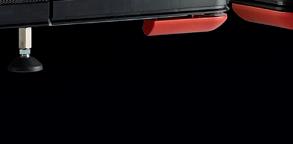


































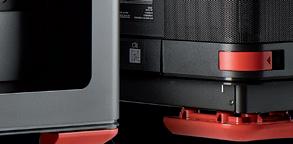





















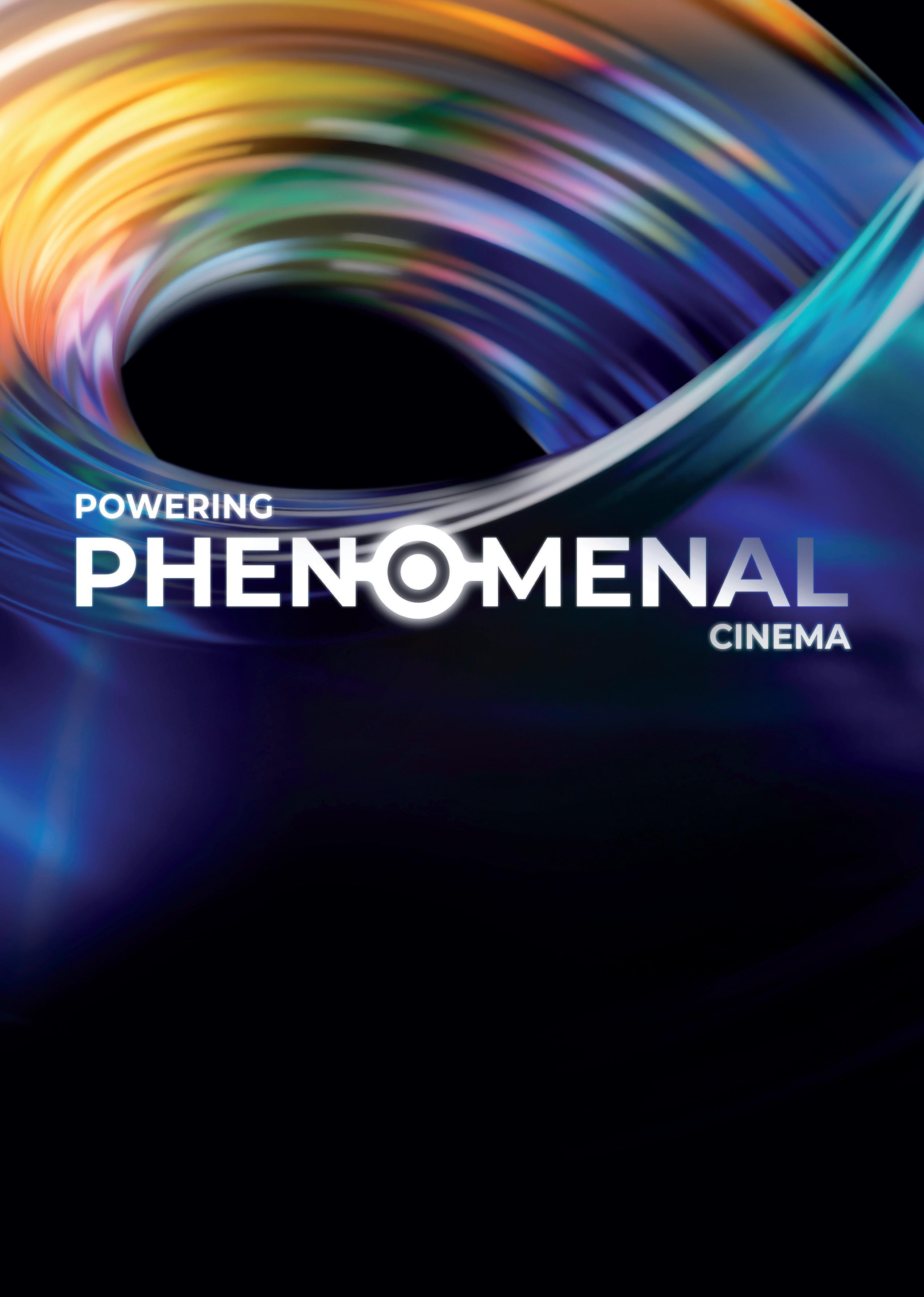
really enjoy each new territory. Each one is so different, they work differently, films release differently. So it’s always exciting for me to learn something new.
really enjoy each new territory. Each one is so different, they work differently, films release differently. So it’s always exciting for me to learn something new.
My main expansion into the role has been to take on some bigger picture business, hopefully relieving some stress from my boss.
My main expansion into the role has been to take on some bigger picture business, hopefully relieving some stress from my boss.
CT: How have your previous experiences prepared you for your new role?
I’ll end on two pieces of advice I was given when I started, and I love to share them as I believe they are so invaluable.
I’ll end on two pieces of advice I was given when I started, and I love to share them as I believe they are so invaluable.
Qube Wire to become the World’s largest electronic content delivery network to cinemas
Kaleidescape Introduces the New Strato M Movie Player
CT: How have your previous experiences prepared you for your new role?
I think because I’ve been so lucky to have had a varied career. From being on the studio side to growing in the tech side. I feel i understand the pain points that my customers face. Because I faced them.
I think because I’ve been so lucky to have had a varied career. From being on the studio side to growing in the tech side. I feel i understand the pain points that my customers face. Because I faced them.
KALEIDESCAPE, maker of what it describes as “the ultimate movie platform”, announced Strato M, a new entry-level movie player for residential, marine, and commercial theatre systems. Offered at half the price of Kaleidescape’s previous lowest-cost system, Strato M provides reference 2K video output, with better than Blu-ray quality. Like all Kaleidescape movie players, Strato M supports lossless audio.
CT: As the newest member of the CTC board, what are you looking forward to most?
CT: As the newest member of the CTC board, what are you looking forward to most?
Oh my gosh, the community. Sharing knowledge between this group of incredible people across the globe. Looking for better ways to work together that can help anyone. I hope I can bring something valuable to the table.
QUBE WIRE CINEMA, A LEADING PROVIDER of end-to-end digital cinema technology solutions, has signed a definitive agreement to acquire a 100% stake in MetaMedia (MMT Tech, Inc). MetaMedia is North America’s largest cloud-based content delivery platform to cinemas. With this acquisition, Qube Wire becomes the world’s largest cinema electronic delivery network with over 5,000 cinemas connected across 51 countries. In the United States, the merged network will provide coverage to 9 of the top 10 largest cinema chains. Qube will continue to execute MetaMedia’s existing deployment plans and service its customer agreements.
Oh my gosh, the community. Sharing knowledge between this group of incredible people across the globe. Looking for better ways to work together that can help anyone. I hope I can bring something valuable to the table.
“The acquisition of MetaMedia is a huge move for Qube’s North American operations,” said Harsh Rohatgi, CEO of Qube Cinema. “MetaMedia’s
“Strato M opens up the Kaleidescape experience to a broader range of movie enthusiasts,” said Tayloe Stansbury, chairman & CEO of Kaleidescape. “And in larger systems, Strato M is great for secondary rooms, while reserving the flagship Strato V for main viewing areas.” Strato M works on its own or as part of a larger Kaleidescape system. As a standalone system, Strato M provides a single playback zone that holds a halfdozen movies on an internal solid-state drive –
“...Sharing knowledge between this group of incredible people across the globe. Looking for better ways to work together that can help anyone. I hope I can bring something valuable to the table.“
“...Sharing knowledge between this group of incredible people across the globe. Looking for better ways to work together that can help anyone. I hope I can bring something valuable to the table.“
CT: What’s your favourite aspect of working in the cinema industry?
CT: What’s your favourite aspect of working in the cinema industry?
innovative network has consistently delivered faster, more cost-effective solutions for content delivery, saving millions compared to traditional methods. At Qube, we’ve leveraged this technology to bring Indian feature films to North American cinemas with speed and precision, expanding the size and number of Indian releases by 3x in the last five years. With the addition of MetaMedia, our combined strengths will set a new standard in cinema content delivery for many more distributors and create unparalleled value for the global movie industry.”
downloading a movie in about ten minutes over gigabit Ethernet. It features a streamlined interface, optimized for navigating a small movie library, offering automatic offloading of watched movies 48 hours after playback to make room for more movies. Purchased movies can be re-downloaded at any time.
The cinemas of course! I love to visit my favourite places in town. I love to escape into a film, melt away any stress. It’s the best fun, even when I watch a horror. If you’ve ever sat next to me during a horror, you’ll know how ridiculous I am.
Pick your battles… don’t die on your sword. A few years into my role at Warner Bros, I had just started taking over trailer negotiations. During a back-and-forth with one of my exhibitor friends over placement for a release that barely had any admissions, he said, “Pick your battles.” I understood immediately, and it resonated with me.
Pick your battles… don’t die on your sword. A few years into my role at Warner Bros, I had just started taking over trailer negotiations. During a back-and-forth with one of my exhibitor friends over placement for a release that barely had any admissions, he said, “Pick your battles.” I understood immediately, and it resonated with me.

The cinemas of course! I love to visit my favourite places in town. I love to escape into a film, melt away any stress. It’s the best fun, even when I watch a horror. If you’ve ever sat next to me during a horror, you’ll know how ridiculous I am.
Strato M can also be grouped with?Terra Prime movie servers to increase movie storage. This returns Strato M’s interface to the full Kaleidescape user experience. Strato V, Strato C, and Strato M movie players can all be grouped together with one or more Terra movie servers, to fit your entertainment needs.
CT: What advice would you give to someone considering a career in this field?
CT: What advice would you give to someone considering a career in this field?
For nearly four decades, Qube Cinema has been a trailblazer in the global filmmaking and exhibition industries. Qube is one of a handful of companies in the world that has developed a DCI-certified digital cinema server. With a team of about 1,000 employees
Strato M supports lossless multi-channel and spatial object-based audio, including Dolby Atmos and DTS:X. Strato M supports reference 2K video, with
I’ve kept this in mind in everything I do ever since.
I’ve kept this in mind in everything I do ever since.
Don’t burn any bridges. This industry is still quite small, and we all rely on the relationships we build. You never know what will happen, so it’s never worth burning those bridges down.
Don’t burn any bridges. This industry is still quite small, and we all rely on the relationships we build. You never know what will happen, so it’s never worth burning those bridges down.
Ultimately, the connections you make and the experiences you gain can lead to incredible opportunities, so definitely embrace every moment and every interaction!
who are passionate about the domain, Qube continues to revolutionize cinema exhibition and distribution with cutting-edge, reliable, and costeffective solutions. With technology to service the world’s greatest content creators and exhibitors, Qube continues to introduce innovations to the cinema ecosystem that are reshaping the cinematic experience for audiences worldwide. Qube Wire has been growing consistently since launching as a global cloud-based distribution platform in early 2017. Today, Qube Wire powers the supply chain for many major content distributors, including all the major Hollywood studios. Qube Wire also delivers over 95% of all the Indian movies released around the world. With its regional partnerships and automated hard drive duplication hubs, Qube Wire provides
higher bit rates and bit depths than Blu-ray, including Dolby Vision, HDR10, BT.2020, and 4:2:2 chroma. Kaleidescape Strato M provides access to the Kaleidescape movie store, the world’s only digital movie collection with lossless audio and full reference video quality. The movie store offers thousands of 4K and HD titles for purchase or rent, including movies, TV series, and concerts. Kaleidescape movies are downloaded, not streamed, so there is never buffering or loss in quality.
Ultimately, the connections you make and the experiences you gain can lead to incredible opportunities, so definitely embrace every moment and every interaction!


Showtime Analytics Announce Agreement With Balkans Largest Chain Blitz-CineStar
VOX Cinemas brings the world’s most innovative IMAX® experience to Mall of the Emirates
Showtime Analytics Announce Agreement With Balkans Largest
SHOWTIME ANALYTICS RECENTLY ANNOUNCED AN agreement with CineStar, to provide them with a real time operational data and digital marketing platform across their 28 sites.
Blitz-CineStar, founded in 2003, is the leading cinema operator in Croatia and the region, spanning Croatia, Bosnia and Herzegovina, Serbia and Kosovo.
Featuring 182 state-of-the-art halls, including IMAX, 4DX, Screen X and Gold Class, CineStar sets the standard for cutting-edge technology and premium cinema experiences. Recognised for innovation and quality, it has earned numerous awards, including “Best Cinema in Europe” by UNIC in 2019, and continues to deliver exceptional entertainment to over 4.5 million visitors annually.
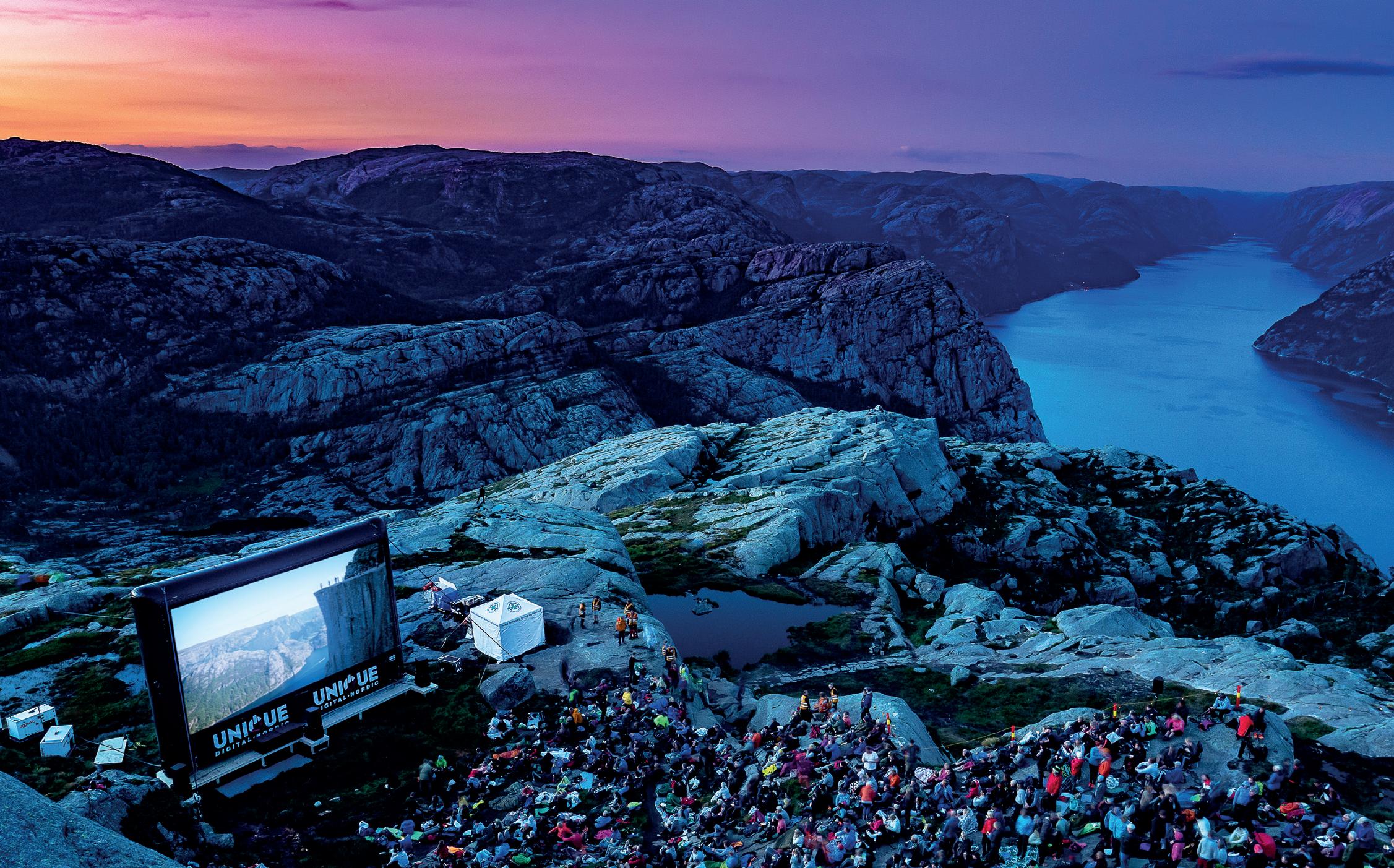
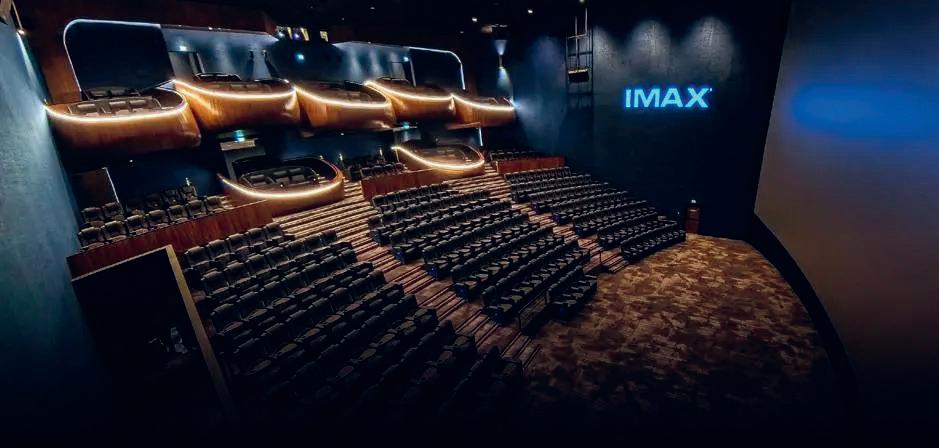
the world at Mall of the Emirates. Ten years on, we’re redefining the cinema experience once again to offer our guests something so exceptional, they’ll want to leave their sofa and experience the magic of cinema like never before. We’re proud to offer what we believe is the best IMAX screen in the world. But this is just the beginning. We’re committed to enhancing every aspect of our flagship cinema, with the next phase focusing on the Kids Cinema and social areas. Our ongoing transformation at Mall of the Emirates is meticulously designed to serve our guests, while enhancing this world-class entertainment destination.”
cinema operator in Croatia and the region, spanning Croatia, Bosnia and Herzegovina, Serbia and Kosovo. Featuring 182 state-of-the-art halls, including IMAX, 4DX, Screen X and Gold Class, CineStar sets the standard for cutting-edge technology and premium cinema experiences. Recognised for innovation and quality, it has earned numerous awards, including “Best Cinema in Europe” by UNIC in 2019, and continues to deliver exceptional entertainment to over 4.5 million visitors annually.
VOX CINEMAS, owned and operated by Majid Al Futtaim, has officially launched the world’s most innovative IMAX experience, marking a key milestone in its transformation to offer the most immersive and luxurious cinema experience. The new IMAX theatre features the unique Ōma Cinema® premium pod seating, a patented design, which is part of VOX Cinemas’ phased upgrades alongside Premier and THEATRE offerings.
With their commitment to delivering an unparalleled theatre experience to their customer base, Blitz-CineStar wanted to use their first-party data to help them understand how their business was performing across the metrics that mattered to them, and use this data to drive customer engagement and loyalty. They reached out to Showtime Analytics to evaluate how their cloud platform could help them do this.
IMAX sets a new standard in cinema technology with a 4K Laser Projection System. Featuring IMAX’s proprietary optical engine, delivering heightened resolution, sharper and brighter images, and deeper contrast, it ensures vivid, life-like visuals that immerse audiences in every frame. Next-Generation IMAX Precision Sound provide striking clarity, depth, and evenly distributed audio, for the ultimate auditory experience.
By migrating from their existing email marketing tool and integrating their customer data to Showtime Engage, it will allow them to bring individual customer behaviors, touch points and purchase activity together to create a single view of their identifiable movie-goers. Having all this information about their different customers and their shared behaviours, it will give them the ability to create and send targeted, personalised digital campaigns to different segments, driving customer engagement and loyalty. With the closed loop integration with their POS this will allow them to track conversions and revenue uplift from each campaign, putting them in better control of where to focus their marketing efforts.
With their commitment to delivering an unparalleled theatre experience to their customer base, Blitz-CineStar wanted to use their first-party data to help them understand how their business was performing across the metrics that mattered to them, and use this data to drive customer engagement and loyalty. They reached out to Showtime Analytics to evaluate how their cloud platform could help them do this.
The custom-built IMAX auditorium features stadium seating, ensuring clear vantage points from every seat, alongside specialized screens designed to maximize brightness and clarity. Films screened in IMAX are digitally remastered using IMAX DMR® technology, enhancing visuals and sound frame-by-frame for an unparalleled cinematic experience.
By migrating from their existing email marketing tool and integrating their customer data to Showtime Engage, it will allow them to bring individual customer behaviors, touch points and purchase activity together to create a single view of their identifiable movie-goers. Having all this information about their different customers and their shared behaviours, it will give them the ability to create and send targeted, personalised digital campaigns to different segments, driving customer engagement and loyalty. With the closed loop integration with their POS this will allow them to track conversions and revenue uplift from each campaign, putting them in better control of where to focus their marketing efforts.
Mrs Jadranka Islamovic, CEO CineStar Cinemas said of the partnership:
Mrs Jadranka Islamovic, CEO CineStar Cinemas said of the partnership:
“As the best and largest cinema in our region with more than 22 years of operation, CineStar has become a synonym for cinema in our territory. We have a duty to provide each of our visitors with the best value for money through superior service and satisfaction, and to always provide the best and largest selection of films, in technologically superior halls and the most comfortable seats, the always constant quality of CineStar Cinemas. The values on which we base our long-term success are quality, service, trust, innovation and understanding of the needs of our visitors. We hope that with Showtime Analytics, we will now understand our visitors even better, all to improve our relationships with customers, their loyalty and ultimately increase visits.”
Further elevating the innovation are seven exclusive pods within the IMAX auditorium. Designed by Ōma Cinema® and developed under the vision of renowned French architect Pierre Chican, these premium ‘THEATRE pods’ combine luxury with cutting-edge cinema technology, offering an unparalleled high-end experience in the IMAX space. Drawing inspiration from the elegance and atmosphere of traditional theatres, the proprietary Ōma seating layout features a series of tiered balconies, bringing audiences closer to the screen in a vertical arrangement for a more intimate viewing experience. Each pod accommodates five guests and can be reserved individually or for a group.
“World-class, flagship locations like The Mall of Emirates in Dubai showcase the strength of IMAX’s fast-growing presence in the Middle East and our commitment to delivering the best possible moviegoing experience to audiences across the region,” said Rich Gelfond, CEO of IMAX. “IMAX is excited to deepen its partnership with Vox Cinemas and reintroduce The Mall of Emirates on the verge of a very promising blockbuster season, and amidst one of our best years ever at the global box office.”
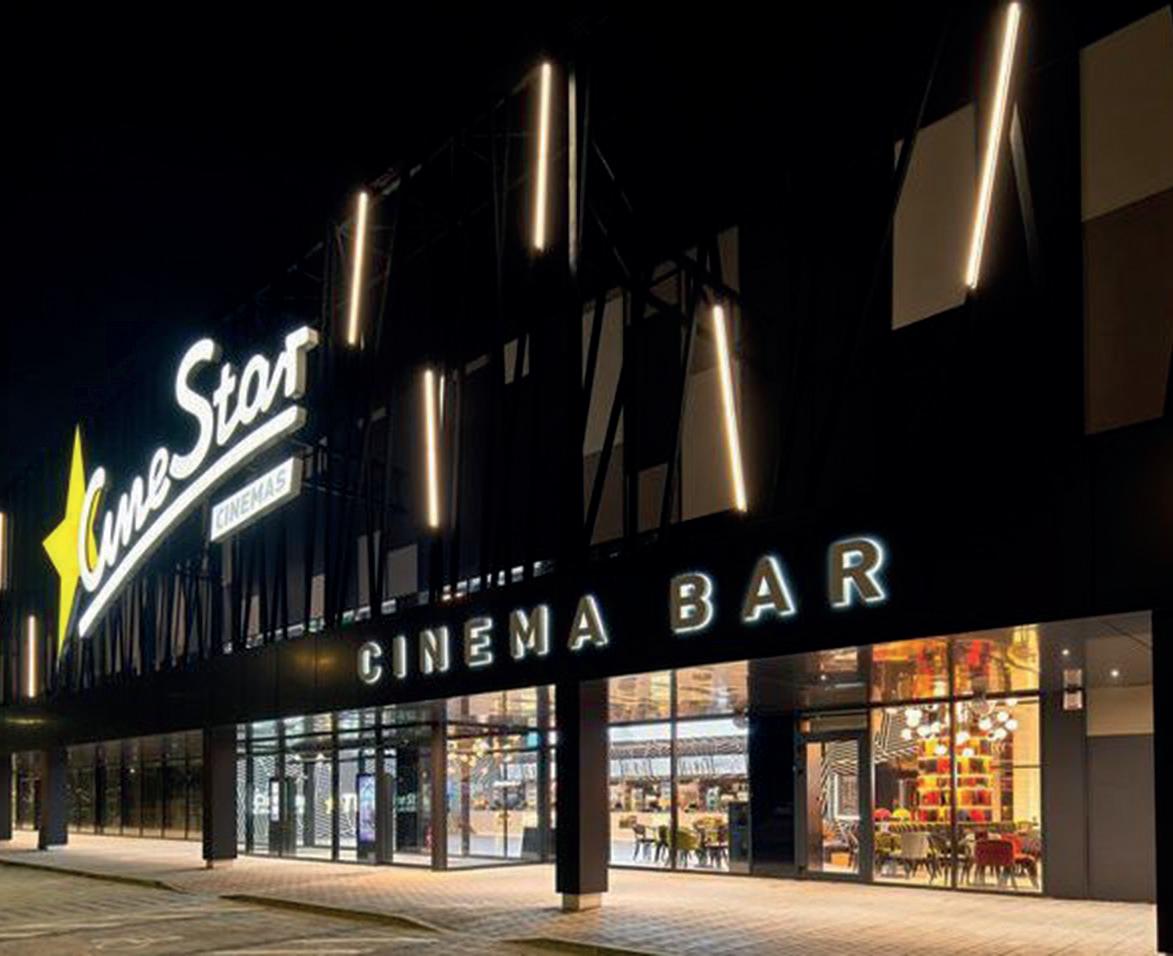

Inside the pods, guests are treated to VOX’s renowned luxury cinema concept ‘THEATRE,’ which includes reclining seats, pillows, blankets, and full waiter service. Guests can enjoy a specially curated menu from the THEATRE experience, delivered straight to their seats—offered for the first time ever inside an IMAX auditorium. The pods also include access to the exclusive THEATRE Lounge, where guests can relax before or after their screening.
Ignace Lahoud, Chief Executive Officer, Majid Al Futtaim Entertainment, said: “In 2015, VOX Cinemas launched what was considered the best cinema in
“As the best and largest cinema in our region with more than 22 years of operation, CineStar has become a synonym for cinema in our territory. We have a duty to provide each of our visitors with the best value for money through superior service and satisfaction, and to always provide the best and largest selection of films, in technologically superior halls and the most comfortable seats, the always constant quality of CineStar Cinemas. The values on which we base our long-term success are quality, service, trust, innovation and understanding of the needs of our visitors. We hope that with Showtime Analytics, we will now understand our visitors even better, all to improve our relationships with customers, their loyalty and ultimately increase visits.”
www.cinema-technology.com


Barco Debuts New Smart Cinema Amplifier and Integrated Media Server with Audio Processing at CinemaCon 2025
Barco, the global leader in laser cinema technology, debuted two new solutions at CinemaCon 2025 , expanding the Barco Cinema portfolio with enhanced audio capabilities and faster, more efficient operations. The Barco mFusion ICMP-XS integrated audio and media server and Barco Smart Amplifier are designed to work seamlessly with the award-winning Barco Series 4 projection family to enable unified technology management, powerful content processing and playback, and rich surround sound.
With this announcement, BARCO offers exhibitors a complete cinema presentation solution that simplifies the delivery of exceptional theatrical experiences. Building on the success of its predecessor, the Barco Alchemy, Barco mFusion combines state-of-the-art audio processing and live content streaming capabilities with a next-generation media server. Barco mFusion is thoughtfully designed to meet the high-volume needs of today’s cinemas with speeds up to 5x faster for simultaneous content ingest, play,
5.1/7.1 configurations and immersive audio rendering delivers crystal-clear dialogue and powerful bass. Featuring a new, evolutionary interface that evolved from the Barco Series 4 platform, the mFusion integrates seamlessly for maximum workflow efficiency and simplified operations.Barco’s new integrated Smart Amplifier delivers robust, dynamic sound for an audio experience that compliments the dazzling laser-powered presentation on screen. Combining power and efficiency, the Smart Amplifier
sharing a common control interface with mFusion ICMP-XS and Series 4 projectors, allowing effortless installation and hot swappable functionality for uninterrupted operations. ”We are honored that cinemas worldwide have chosen Laser by Barco and Barco Series 4 for their move to laser projection.” said Gerwin Damberg, EVP, Barco Cinema. “Barco’s focus on innovation drives us to develop new solutions that enhance our technology offerings to add value our customers and improve the cinema

NEW UK & INTERNATIONAL REPRESENTATIVES FOR LEADING CINEMA PROJECTOR MANUFACTURERS
Sharp and Barco recently announced the appointment of new representatives to serve the UK and international markets.
Adam MacDonald joined Sharp in April 2025 having previously held roles with GDC Technology, Sony, RealD, MasterImage. Commenting on the appointment, Jens Kayser, Head of Cinema Solution Sales for EMEA said: “ We are thrilled to welcome Adam MacDonald to our Cinema Solutions team at Sharp/NEC! With his extensive background in the cinema industry and his strong network across the UK and international markets, Adam will be a key driver in steering our success in the UK, Ireland and Scandinavia. His passion for Visual Excellence and commitment to delivering a top-tier customer experience perfectly align with our values. As we continue to lead the way in Projection Technology and
cinema solutions, we’re excited about what lies ahead”


Toni Purvis joined Barco as Territory Manager for the UK and Ireland in February 2025 having previously held roles across the sector from exhibition through to distribution. With a career spanning almost two decades, Toni has an extensive knowledge of the cinema space having previously held positions with Usheru, Amblin Partners, Mister Smith Entertainment, Entertainment One and Odeon Cinemas Group. Toni is also a Director of Cinema Technology Community and a regular voice on CTC’s podcast.

GREEN SHOOTS
WORDS: TIM POTTER, FOUNDER, TRIGAGE.
Reduce and Recycle
Ithink we can all agree that the global political conversation has shifted a fair bit in recent months—President Trump’s return to the world stage has certainly stirred the pot—but despite the headlines elsewhere, we can’t afford to take our foot off the gas when it comes to the environment.
As I write this, it’s officially the hottest start to May the UK has ever recorded, and energy prices remain painfully high in several territories.
So no, now is not the time to get complacent and it’s been said many times before: sustainability isn’t just good for the planet—it’s good for business. That’s why this Green Shoots, revisits two of the classic 3Rs: Reduce and Recycle (the third being Reuse). Let’s take a look at some of the latest activity across our industry.
Recycle: A Second Life for Xenon
Although laser projectors are gaining ground, they still only make up around 20% of projectors in use. That means a huge number of cinemas are still relying on xenon lamps.
So what’s the industry doing to reduce the impact of old lamps?
Lighting Technologies International (LTI) has launched a recycling programme for xenon lamps, aimed at tackling both safety concerns and environmental waste. Their proprietary system, developed at their Baldwin Park facility in California, allows for the secure disposal and recycling of xenon lamps—including the recovery of glass, tungsten, and xenon gas. Crucially, this helps prevent the risk of these pressurised components ending up in landfill.
The process is seamless for US customers— prepaid return labels are included in lamp boxes— and LTI has also made it straightforward for international customers to participate by simply contacting them to arrange returns. No hoops to jump through and no catches it seems and all major xenon lamp brands are accepted. LTI informed me that tens of thousands of lamps are expected to be recycled annually through this scheme. If that’s the case, that’s a big step forward for reducing emissions and promoting a more circular economy. If you want to take part, reach out to Eric Simonian (USA) at eric.simonian@ltilighting.com or Jana Daberkow (EMEA) at jana.daberkow@ ltilighting.com
Reduce: Smarter Displays
On the subject of reduce, let’s turn to energy use. UK Digital Signage company Saturn Visual Solutions has come up with an elegant answer for digital signage. They have been working on a system that dims or switches off displays in corridors and foyers when no one’s around— automatically linked to POS schedules and
The work also preserves the grandeur of the building - a reminder that sustainability doesn't mean sacrificing atmosphere.
controlled via a bit of clever code. It’s a simple idea that means you’re not wasting energy lighting up hallways for the sake of it.
Reduce, Rethink and Retrofit: Broadway Prestwick
At a recent UKCA event in Scotland, Heriot-Watt University shared their work on what might become the UK’s first Passive House cinema: The Broadway in Prestwick. Built in the 1930s and full of inefficient heating systems, the building is currently undergoing a radical transformation—from open gas fires and coal boilers (really!) to ground/airsource heat pumps, high-grade insulation, heat recovery ventilation, and solar PV.
The team’s calculations are staggering: implementing Passive House principles could reduce the cinema’s annual heating bill from £55,700 to just £4,740. Yes, that’s more than 12 times cheaper.
But we are talking about open gas fired and boilers. The work also preserves the grandeur of the building—a reminder that sustainability doesn’t mean sacrificing atmosphere. I’m sure we’ll cover this project in more detail in a future issue, but it’s definitely one to keep an eye on.
And the last wise word of green reasoning... So as I said yes, the political winds may be shifting, but in our industry the green agenda is still very much alive and with good reason. Going green makes sense from an environmental, economic and operationally standpoint.
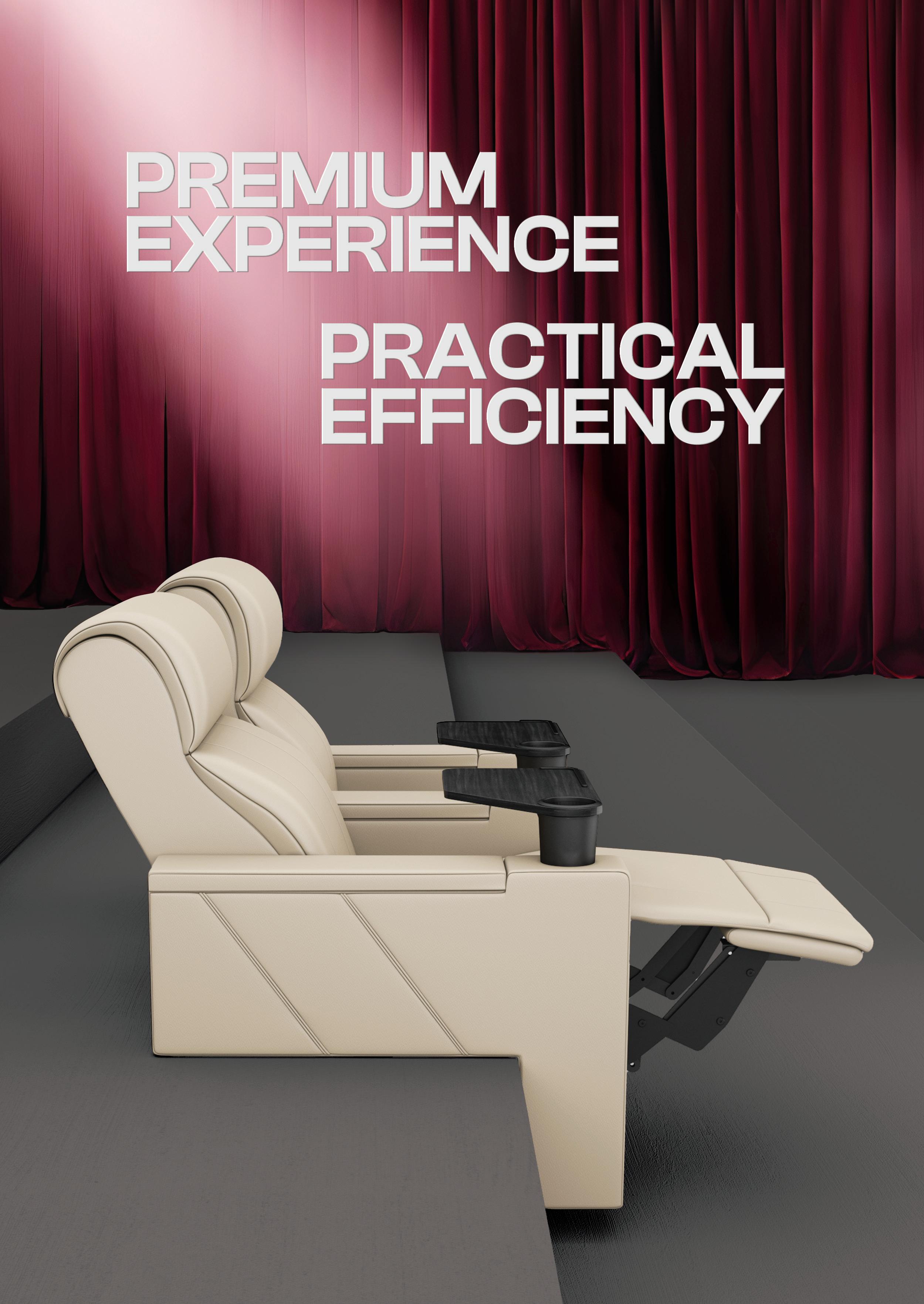
EVERYBODY'S TALKING ABOUT CINEMA
Last year’s mood of cautious optimism among European cinema operators and distributors is now developing into simply optimism, full stop. The stabilisation of the supply pipeline of US and local releases, and the strong appeal of the popular franchises and characters returning over the course of this year, is allowing more momentum to build.
WORDS: LUCY JONES, EXECUTIVE DIRECTOR, COMSCORE MOVIES.
Audiences are repeatedly showing their enthusiasm for the communal out-ofhome experience – and for sharing this enthusiasm through word of mouth or social media. When over a quarter of viewers at A Minecraft Movie say they heard about it on TikTok, it shows how films are connecting with specific audiences who want to be part of the big conversation. Results for the first part of the year have fuelled this mood of optimism. Building on the diverse slate and very strong finish to 2024, the first four months of 2025 again show that audiences want to be part of the cultural conversation. Whether this is teens posting their reactions at A Minecraft Movie, female friends sharing an emotional connection during Bridget Jones: Mad About The Boy or families cheering Paddington’s adventures in Peru, the box office continues to prove that these shared experiences are motivating audiences to rekindle their cinemagoing habit.
European ticket sales have again topped €2 billion by the end of April, passing €2.064 billion this year. This is 3.3% ahead of the same period in 2024. A Minecraft Movie is the top release of the year so far with over €223 million of its global total coming from Europe, mirroring the success of Dune: Part Two last year (€220 million in the equivalent period).
As in 2024, rather than relying on a small handful of super-blockbusters to drive ticket sales as we saw in the three years post-pandemic, European box office in 2025 has again been powered by a wide range of titles. Looking at the number of films it took to pass the €1 billion milestone in the first four months of each year, in 2023, €1 billion was delivered
from only the top nine films (with Avatar: The Way Of Water and The Super Mario Bros. Movie contributing almost half a billion combined). In 2024, eighteen films contributed to the box office billion, and in 2025 it took sixteen titles to pass this milestone, from Minecraft to Conclave. Offering different audiences a healthy diversity of choice is paying dividends.
Three of the big five Western European territories – UK & Ireland, Italy and Spain – have all recorded significant growth above the equivalent 2024 period. UK & Ireland leads with a 13% gain, driven by global juggernaut A Minecraft Movie and
local heroine Bridget Jones: Mad About The Boy. Nine titles contributed over £10 million each by the end of April, soon to be joined by Sinners which will also pass this milestone in May following a powerful response from audiences, scoring the highest PostTrak rating of the year’s releases to date (a full five stars out of five across all age/gender quadrants). In Italy, local comedy Follemente tops the chart with €17.4m ahead of Minecraft’s €11.3m. The territory is 10% ahead of last year’s strong start. Three of Italy’s Top 5 films are local comedies, with 40% of overall box office coming from local productions. In contrast, Spain’s
TOP 5 WESTERN EUROPEAN TERRITORIES
– JANUARY TO APRIL 2025:
TOP EUROPEAN
FILMS
AT THE EUROPE BOX OFFICE
JANUARY TO APRIL 2025:
successful start to the year – 9% up on 2024 – has been driven by US family titles A Minecraft Movie and Christmas release Mufasa: The Lion King. To date, 16% of sales have come from local Spanish productions, topped by Wolfgang (Extraordinario) ranking at No.7 in the four-month chart. It has been a slower start to the year for France and Germany, although in both cases by a much smaller deficit than seen in 2024 vs 2023. France is down just 3% year-on-year, with another local hit leading the chart: comedy God Save The Tuche has recorded almost 3m admissions already. Mufasa and Minecraft are also in the French Top 3, as in Spain. Germany follows suit with both of these family titles leading the chart, and local drama sequel Wunderschöner rounding out the Top 3. Overall Germany has the largest deficit of the main Western Europe territories, running 6% behind 2024, but this is a significant improvement over last year’s -15% at the same point. Forecasts for the full year of 2025 indicate that only one release from the January to April period will appear in the annual Top 10s for France and Germany, with greater success coming through the summer and Q4.
The Power of Local Productions
European productions (including co-productions with US studios) contribute significantly to this diversity. Six of the Top 20 European films have travelled to over 30 European territories, with other films achieving their position through great success at home. Sweden/US collaboration A Minecraft Movie tops the all-films chart in Europe, and also leads among local productions. It has played in almost all European territories and achieved over €223 million already in April. Other titles may not have travelled so widely at this point in their release journey but still rank highly from a few territories, led by France’s God Save The Tuche (the top film not in the English language) and Italy’s Follemente. Half of the films in the European Top 20 are French productions/co-productions making France the most successful production
territory in this period, with a mix of French and English language releases plus dialogue-free award-winning animation Straume (Flow).
A Positive Forecast
In March, driven by the stronger than predicted Q1, forecasters Gower Street Analytics raised their fullyear 2025 global box office estimate from $33 billion to $34.1 billion, which would represent a 13% increase year-on-year. The vast majority of this gain is driven by China, following the phenomenal success of animated sequel Ne Zha 2 which achieved over $2 billion in China and $57 million elsewhere. International markets (excluding China) are now expected to achieve around $200 million more than initially forecast before the year began, grossing 10% more than 2024 to hit $17 billion.
Summer 2025 will follow a more traditional pattern than 2024, kicking off with Marvel’s Thunderbolts*, Mission: Impossible – The Final Reckoning and Karate Kid: Legends bookending
May. Family titles look particularly strong with beloved characters returning for a steady stream of releases led by Lilo & Stitch in May, How To Train Your Dragon in June (alongside new original animation Elio), and both Smurfs and The Bad Guys 2 following in the July holidays. For older audiences, June/July also brings F1, Jurassic World Rebirth, Superman and The Fantastic Four: First Steps. The bunching of top titles seen in Q4 last year should be less pronounced at the close of 2025, with a more manageable number of releases in November/December appealing across different audiences. These are forecast to be led by Wicked: For Good, Zootopia 2 and Avatar: Fire And Ash. All five major Western European territories should end the year with at least one local production/coproduction in the Top 10 chart, including long-awaited sequels Bridget Jones: Mad About The Boy (UK/France/US) and Das Kanu des Manitu (Germany).
GLOBAL BOX OFFICE IN HISTORICAL EXCHANGE RATES:
TARIFFS, TAX, TRADE WARS,
TECH... & TALKS
WORDS:
DAVID HANCOCK, CHIEF ANALYST, MEDIA & ENTERTAINMENT, OMDIA
It has been an interesting few months in the global economy as President Trump’s tariff announcements upturned decades of widely and deeply-held belief that the best way for the world to function is with as free as trade as possible.
The initial round of tariffs back in early April (seems a long time ago now, doesn’t it) focused on goods, and while film and TV are classed as services not goods, there was no immediate direct impact on the circulation of films. However, film production is all about equipment: cameras, lenses, lenses, trucks, generators and so on. The most popular cameras for US filming are made by German manufacturer Arri, and if these are subject to tariffs upon import, that could push up production costs, on top of previous inflationary elements such as fuel costs and rising studio pricing. To counteract this, US equipment rental providers and studios may favour US-made equipment (eg. Red and Panavision) as they replace inventory, but this would reduce choice for filmmakers, not something most directors and their teams would accept.
A similar picture is true for the indie sector, where research by Y.M.Cinema magazine shows that 25 out of 37 feature films submitted to Sundance Film Festival in 2022 were also shot on Arri equipment, less than for major studios but still a clear majority. This underlines the point about replacement equipment not being a simple matter.
As for cinemas themselves, the only ones to suffer would be American. Cinemas need to be equipped, and cinemas are investing heavily in technology and elsewhere in the venue, everything from projectors, servers, and sound systems, to premium technologies such as immersive motion seating, laser projectors, LED cinema screens, actual screens, seats, point-of-sale (POS) systems, ventilation, and heating systems. Unpicking the supply chain behind this and identifying where
NORTH AMERICA: CHOICE OF PRINCIPAL CAMERA FOR TOP 30 MOVIES EXCL. ANIMATED TITLES
US PRODUCTIONS: SHOOT LOCATIONS OF TOP 40 MOVIES
these things are actually made, or discussing these issues with their technology partners, would be key for US cinema operators looking to invest in new equipment, and any tariffs imposed on nonUS equipment would increase prices at a time when exhibitors are still recovering financially from the pandemic.
China: A movie trade war in no-one’s interest
A few days after the tariffs announcement, which had targeted China particularly harshly and which had escalated quickly, China made it public that it would be reducing the number of Hollywood movies allowed into the country, although the phrasing was that cinemagoers would do this themselves as they turned away from US films as a response. The US has a significant trade surplus with China in the field of movies, standing at over $3bn gross between 2017 and 2019, but down to $1.2bn in 2024. The figure for net revenue flows (what leaves each country after exhibitors have had their cut) peaked at $835mn in 2017 and was very close to $300m in 2024 in favour of the US. The trade balance is so weighted towards the US because very few Chinese films are successful in the US. The Top 10 Chinese movies at the US box office only includes three films from the last 6 years.
Even though the Hollywood share of the market has declined in recent years, the major US movies still take around 20% of what will be the world’s largest box office market in 2025. The studios receive 25% of the gross revenues, unlike the rest of the world where the figure is closer to
half. The authorities had been pushing cinemagoing in their wider drive to increase spending, especially as cinema venues are often to be found in shopping malls. To help achieve this, there were subsidised tickets available between December 2024 and February 2025. The reduction of Hollywood was not in line with this effort, a sign of how seriously the government took this. However, in the event, the reality was more about a reduction than a ban, a recognition that China needs strong Hollywood on top of its own movies. In economic terms, it was not sensible to ban Hollywood films. Even though banning US films would hurt film studios to the tune of around $300m a year, the bigger picture is that Chinese cinemas need content to play and there are not enough home-grown films to sustain the number of screens, which would hurt its cinema sector.
Combating runaway production
We then heard from President Trump about proposed tariffs on films from outside the US, which woke the industry up. In this instance, it is quite hard to see what the US government can actually tariff. The film itself is a digital file, and the rights are often split many ways according to who has financed it or is owed a share of the profits. Is a US production shot in Romania not a US movie, even if the finance and creative team are American? On top of this, there is currently a moratorium on digital transmissions within the WTO until the agreement is up for renewal in 2026. This includes movie downloads and electronic transmissions, which is how many
movies are distributed. It became clearer that the target was really US productions shooting abroad.
Film productions have been moving out of the US for 25 years, known as runaway production, with an accelerated move in the past few years. This is due to high labour costs in US, and a burgeoning number of generous tax incentives systems around the world, driving US major studios and smaller producers to third-party countries. The world is a very global place for shooting and posting movies.
The term ‘runaway production’ was coined in the late 1990s, and competition between countries for production (and in some cases post-production, VFX and animation) spend has been fierce for several decades: for that is what it is – competition. The original focus was movies relocating to Canada from LA, but the phenomenon is much wider now. There are over 100 tax credit or incentive schemes around the world-federal, national and/or regional. The US makes less than 10% of the global output of movies, although the US also accounts for half of global film revenues in cinemas.
Omdia research shows that of the Top 50 movies at the US box office in 2024, ten were animated projects. Of the remaining 40, only 12 were shot fully in the US, a further 9 had a minority US shoot, involvement, and 19 were shot entirely outside the US, meaning 70% were shot mainly somewhere else. In budget terms, those movies shooting solely in the US accounted for only 21% of the cumulative $3.7bn budgets. Major global hubs for filmmaking outside of the US are the UK, Canada and to a lesser extent Australia. The UK
CHINA: MOVIE TRADE BALANCE IN US FAVOUR IN $MN
OF THE TOP 50 MOVIES AT THE US BOX OFFICE IN 2024, TEN WERE ANIMATED
DOMESTIC MOVIES ACCOUNTED FOR 20% OF THE MARKET IN 2015, RISING TO 63.5% IN 2024.
was involved in these projects in some way in 35% of cases, and Canada 13.4%.
Several countries, amongst them the UK, Canada, Australia, are now reliant on major US productions using their studio facilities and would struggle to fill those spaces without them. This will affect players like Pinewood Canada (the UK studio group that set up in Toronto Canada in 2009 and took full ownership of the site in 2023). Amazon took a long-term deal on five sound stages in Pinewood Canada in 2024. In addition, there are deals in place between major producers and studios for long-term leasing of sound stages, such as Disney’s ten-year deal with Pinewood Studios and Netflix with Shepperton Studios (UK). Any attempt to impose a tariff on non-US made movies would render these existing contracts liabilities if the result was some form of economic punishment on shooting outside the US.
Quickly on the heels of the tariffs on movies announcement came a leaked draft plan drawn up by actor Jon Voight to save the US film industry, and it seems fairly standard in many ways, taking a similar approach to many other countries where film is given a strategic role in the economy. It certainly wasn’t all about tariffs. Tax incentives are proposed (federal and state-level where none are in place), a cultural test is a commonly used mechanism, as are co-production treaties, subsidies for theatre owners and other companies in the film chain.
The ‘tariff’ that the President picked up is a proposed charge on productions that shoot abroad to the level of 120% of the money raised
through that particular tax credit scheme, a small part of the overall scheme. The plan applies to film and TV productions, including streaming. It could be that, if this penalty is implemented, other tax credit schemes will start offering that extra 20% (or part thereof) to be included in their system or rebate.
An interesting phrase could turn out to be ‘could have been produced in the US’, applying to films that would be charged the ‘tariff’. This could eliminate from the ‘tariff penalty’ what used to be known as natural runaways, which are films that shoot abroad for reasons of authenticity, as opposed to unnatural runaways, which shoot abroad for the financial benefits. Authenticity in this case would mean that the script is set in (for example) Spain, or about Spain, and that authenticity would require the film to be shot in Spain. It is not too much of a leap to see more movies being set abroad to get around such a requirement. It would also mean that productions shot abroad by local arms of studios or streamers, with local production companies and in a foreignlanguage, may also not be subject to that penalty.
The end result of all this: The loss of soft power
In the longer term, tariffs and the uncertainty and hostility they provoked around the world could be a potential blow for US soft power in the form of Hollywood. The market share of the major five studios is already in decline in Asian markets, partly due to politics (for example, the Chinese market) but also changing tastes towards home-
grown films. While many more mature film markets in Europe, Australia and South America are still largely driven by Hollywood, the newer markets in Asia and the Middle East are increasingly fuelled by their own films, with China, Japan, Indonesia, Korea and Thailand all seeing market shares of local movies at 50% or above. In the case of Indonesia, for example, domestic movies accounted for 20% of the market in 2015, rising to 63.5% in 2024. In China, probably the world’s largest cinema market in 2025, local market share is around 80%, leaving much less room for Hollywood from the 35-40% pre-Covid. The Asia Pacific region accounted for almost 40% of global box office in 2024.
For studios that only succeed when they are truly global, this is concerning. In fact, audiences across media windows may turn away from US programming because of hostility to the US actions, which would be detrimental to all global US media groups including streaming platforms. This presents an opportunity for local funders to increase the money available for domestic production, both film and TV, as a way to drive up interest and consumption of this local content and push US productions further out.
For the time being, the situation has calmed, even if a layer of tariffs still exists on most countries and the Voight plan is not yet implemented, there is the possibility of continued uncertain times ahead for all parts of the film industry chain. USA VS

AI IN ACTION: INSIGHTS FROM THE CINEMA EXHIBITION FRONTLINE
In the summer 2023 edition of Cinema Technology Magazine, we explored the emerging impact of artificial intelligence (AI) on cinema exhibition. At the time, AI was just beginning to capture mainstream attention — a buzzword full of promise but lacking real-world traction.
WORDS: PETER KNIGHT, COMMISSIONING EDITOR, CT MAGAZINE.
Two years later, the picture looks very different. AI is now embedded in the daily workflows of millions, with tools like ChatGPT, Gemini, and Claude helping individuals and industries alike automate tasks, analyse data, and generate creative content. In cinema, this shift is starting to show real results — not just theoretical discussions but practical implementation.
AI is reshaping cinema exhibition in 2025 — from smarter scheduling to personalised marketing, and from operational efficiency to ethical reflection. What’s happening now, what’s coming next, and how can exhibitors engage meaningfully with this fast-moving technology?
From Buzzword to Business Tool
Back in 2023, “AI-powered” was often little more than marketing fluff — a way to suggest innovation without much substance. It joined a long line of tech terms (Big Data, Cloud, Web 2.0) used more for image than impact. But by 2025, that’s changed.
While some hype remains, AI is increasingly being used to deliver real and measurable value. Whether it’s optimising film schedules, reducing maintenance downtime, or personalising customer engagement, AI is finding its feet. The challenge now is discerning genuine innovation from overpromised potential. And in cinema, we’re starting to see clear examples of the former.
Smarter Scheduling & Operational Gains
Take scheduling. Vue International, one of Europe’s largest exhibitors, now uses AI to analyse historical sales, local demographics and even concessions data to optimise programming. This system has allowed Vue to screen more films — including niche and foreign-language titles — and reach underserved audiences while boosting revenue. Similarly, INDY Cinema Group has brought AI to independent exhibitors through its cloud-based theatre management platform. Single-screen
cinemas can now access predictive tools that help with film booking, pricing and planning — insights that were once the domain of large circuits. AI is also reshaping customer service. In Finland, Finnkino’s AI chatbot has cut wait times dramatically. In India, PVR/Inox has integrated an AI assistant via WhatsApp to help patrons browse listings, book tickets and get support instantly. These aren’t futuristic ambitions — they’re real tools being used right now.
Marketing Gets Personal
Another area of growth is audience engagement. Tools like Movio (from Vista Entertainment Group) use machine learning to build behavioural profiles — factoring in viewing habits, loyalty data, and genre preferences — to send personalised recommendations. The result is better-targeted campaigns and stronger connections between cinemas and their patrons. This builds on the foundation laid by Big Data but enhances it

through speed, prediction, and contextual understanding. Instead of filtering customers based on fixed traits, AI continuously learns and adapts, anticipating what a customer wants before they ask. And it’s not just analysis. Generative AI can help create marketing assets — emails, captions, trailers, social posts — saving time and increasing output without compromising creativity.
The Rise of AI Agents and Natural Interfaces
The real breakthrough behind all this is the development of Large Language Models (LLMs) like ChatGPT and Gemini. These models can understand and generate natural language, enabling the kind of conversational interfaces now used across apps and devices. Paired with the Machine Communication Protocol (MCP), they can interact with calendars, APIs and live data sources. This is the foundation of AI agents — digital assistants that don’t just reply, but take action. In the near future, a cinema manager might ask an AI to check maintenance logs, suggest a film schedule, draft social content, and update the website — all in one prompt. That’s not a fantasy; it’s an emerging reality.
Navigating the Ethical Landscape
Of course, none of this comes without challenges. AI depends on data, and that raises privacy concerns. Cinemas must remain vigilant about GDPR, CCPA, and similar laws — especially when using customer behaviour data for decision-making. There’s also the risk of bias in algorithms, misinformation through “hallucinated” content, and the tension between automation and jobs. And as synthetic media becomes more realistic, the line between real and fake blurs — raising questions for trust, transparency, and regulation. The environmental footprint of AI is another consideration. Large models require immense computing power. Training a single LLM can consume as much electricity as hundreds of homes. While efforts are underway to improve efficiency and use green energy, sustainability remains an issue. AI offers power — but with that comes responsibility.
An Editor’s Take: Working with AI
As Commissioning Editor of Cinema Technology Magazine, I’ve been hands-on with AI tools for the past two years. What began as curiosity has become central to how I work. Today, ChatGPT acts as my assistant, researcher, sounding board, and editor. It
WHERE NEXT FOR AI IN CINEMA?
Looking ahead, AI will become more embedded — and less visible. Expect:
› Dynamic scheduling that adjusts showtimes based on real-time demand.
› Predictive maintenance and inventory systems.
› Hyper-personalised loyalty apps.
› Seamless integration of AI into TMS and POS platforms.
Roles will change. Staff will spend less time on admin and more time curating experiences. Job titles like “cinema data analyst” or “content automation lead” may soon become common. But whatever changes AI brings, the human element remains essential. It’s not about replacing people — it’s about supporting them.
helps structure articles, explore ideas, and solve problems. It’s not perfect — hallucinations, inconsistency, and vague responses still happen — but with experience, I’ve learned how to guide the tool to get what I need. More importantly, it’s helped unlock new creative directions — from music composition to scriptwriting to planning complex projects. It lowers the barrier to experimentation. It doesn’t replace human effort, but it amplifies it. I still do the writing. But now I do it faster, with more clarity, and with a collaborator that never sleeps.
Conclusion
AI is no longer a novelty. It’s a powerful tool with the potential to transform cinema if used thoughtfully, ethically, and creatively. The real opportunity isn’t in replacing the magic of movies, but in delivering that magic more efficiently, personally, and sustainably. This article presents a condensed overview of a deeper exploration into AI’s role in cinema exhibition. CTC has produced a new white paper which features case studies, ethical challenges, and future trends — scan the QR code opposite to read it.
IS FRICTIONLESS RETAIL COMING TO CINEMA?
WORDS:ALEX SOPHOCLEOUS, PRINCIPAL BD, AMAZON JUST WALK OUT TECHNOLOGY
Amazon explains why Just Walk Out technology is a game changer for cinema retail
Cinemas have long relied on traditional concession stands and retail counters to sell snacks, drinks and merchandise. However, during peak times, long queues and slower service can negatively impact the customer experience, often resulting in lost sales as people abandon the queue -- and ultimately leave dissatisfied. Enter Just Walk Out technology by Amazon, which is poised to dramatically change the way cinemas can handle retail transactions.
Just Walk Out technology uses artificial intelligence, sensors and computer vision to let customers pick up concession items and leave the store without waiting in line to check out. This innovative approach is especially well-suited for the leisure industry, and cinemas in particular. Staffing levels in these environments can be very difficult to predict – sometimes there are too many staff members when a film isn’t as popular as expected, and other times there aren’t enough staff when a film suddenly becomes a ‘must see’.
Boosting Sales Through Convenience
Cinemas rely on concessions for a significant portion of their revenue. In some cases, concessions account for up to 40% of a cinema’s earnings. However, slow service and long queues deter customers from making purchases. Just Walk Out technology can significantly increase sales by removing these pain points.
One of the primary advantages of Just Walk Out technology in cinemas is the unparalleled convenience it offers to customers. Traditional concession stands often create bottlenecks, especially during peak hours before a movie starts. Customers often face a frustrating choice: wait in line for snacks or risk missing the start of their movie, or skip concessions altogether. Just Walk Out technology eliminates this problem by allowing moviegoers to enter a concession area, grab what they want, and head directly to their seats without stopping at a checkout counter. This frictionless experience boosts

By eliminating checkout lines, Just Walk Out technology not only streamlines the snackbuying experience but also drives higher sales and operational efficiency.
customer satisfaction and impulse purchases, as shorter lines and the ability to shop at their own pace make customers more likely to buy extra snacks and Coca-Cola, increasing the average transaction value.
Reducing Operational Costs
Just Walk Out technology in cinemas offers significant operational cost advantages. While traditional concession stands require multiple staff members for orders, transactions, and customer service, checkout-free Just Walk Out technology enabled stores reduce front-line retail staffing needs. This allows cinemas to reallocate personnel to roles that enhance customer experience or other valuable business areas.
Addressing Security And Theft Concerns
A common concern about cashier-less technology is security—specifically, the fear that removing traditional checkouts could lead to increased theft.
However, Just Walk Out technology addresses this concern with robust built-in security features, including AI-powered computer vision, real-time sensor tracking and automated item logging. Each product a customer picks up is instantly registered to their payment method and if an item is returned to the shelf, the system detects the change and adjusts the charge accordingly. The system’s accurate product tracking significantly reduces theft while maintaining a seamless customer experience. With security handled autonomously, cinema staff can shift their focus to customer service, fostering a more welcoming and efficient environment.
Redefining the moviegoing experience
Just Walk Out technology by Amazon is redefining convenience for moviegoers and unlocking new revenue potential for operators. By eliminating checkout lines, Just Walk Out technology not only streamlines the snack-buying experience but also drives higher sales and operational efficiency. For cinemas, the benefits are clear: reduced labour costs, actionable customer insights, and a frictionless retail environment that keeps pace with modern expectations. As the entertainment landscape grows more competitive, adopting Just Walk Out technology positions cinemas to meet evolving demands while providing the seamless, customer-centric experience today’s audiences expect.



Today, most consumers want a fast, efficient and potentially contactless process that allows them to complete transactions in a timely manner. We take a look at how the most modern of sports arenas is delivering.
Right after CineEurope in 2019, we took a family vacation to Seattle, Vancouver Island and Vancouver. After a lengthy flight we found ourselves with an exhausted and frankly miserable four year old in need of some sustenance and an early night. In the middle of Seattle, trying to find somewhere to get suitable provisions felt challenging until Google Maps alerted us to a nearby Amazon Go store just five minutes away. Having prepared ourselves for the visit by downloading the app and adding a credit card, we tapped in through the entrance to a convenience store unlike any we’d ever stepped foot in. The Amazon Go concept felt simple. A frictionless, unattended store where groceries could be purchased without the need for human interaction using a technology infrastructure built around an enormous array of cameras (from memory on shelf and ceiling mounted). As Amazon Go rookies, we found the experience highly efficient yet incredibly soulless with the built-in peril of not knowing whether we’d be charged correctly for our purchases. It was an experience that we were neither enthused over nor had the inclination to want to do again. But nonetheless, mission accomplished and one tired and grumpy boy went to bed fed and watered and duly woke up (albeit early) ready to start our holiday.
Given what would befall the world just eight months later, it's strange to believe that the technology adoption faltered for many years and remained on the periphery of retail. undoubtedly there were obvious advantages it would have had when set against the backdrop of a pandemic and the requirement for social distancing.
Why? Well, the answer lies with retailers that have tried to implement the technology and in turn ended up removing it over a number of years. An article in the Grocer Magazine in February 2025 highlights the issues, many of which are the elements previously mentioned such as the need to download
an app, the ease of use, the concern about payment accuracy. So whilst the technology didn’t catch on in high street retail spaces, it has found limited uses in airports and parts of sports arenas. But could it have a more significant use elsewhere? Who’d be brave or smart enough to give it a go on a large scale? Whilst this type of technology has found limited uses in large venues, it’d take someone with vision, a lot of money and who knows a thing or two about technology to think big enough to make it a complete solution!
The Vision
In late July 2019, the LA Clippers (the NBA’s other Los Angeles-based basketball franchise), owned by former Microsoft CEO (and Seattle native) Steve Ballmer announced plans to build a brand new 18,500-seater stadium in Inglewood, California moving the team to their own arena having for many years been the third tenant at Downtown Los Angeles’ Staples Center (now Crypto.com arena).
"My goal is simple. I want the Clippers to have the best home in all of sports," Ballmer said in a news release at the time. "What that means to me is an unparalleled environment for players, for fans, for sponsors and for the community of Inglewood. Our goal is to build a facility that resets fans’ expectations while having a transformative impact on the city we will call home."
Despite challenges and objections, the project broke ground in late September 2021 with a planned opening date of summer 2024 in time for the start of the current NBA season. With an immovable opening date, the project was delivered on time, with numerous test events and concerts held over the summer to validate the arena and the technology infrastructure. And does the stadium deliver on Mr Ballmer’s 2019 promise of making it an unparalleled environment for players and fans? You bet it does, and then some!
At this point I have to add, (and many of you


that know me well know), basketball is something of an obsession and the Clippers is indeed my team, but if I remove the personal fandom element and look at it purely through the lens of a consumer and a cinema industry professional, it’s a marker for what a modern entertainment venue should look like, and there’s many facets for future cinema designers and operators to be enthused about.
Immersive technology… and lots of toilets!
The Intuit Dome is an arena built around the use of technology and a refined consumer experience. Let’s start with the use of LED screens and in particular the near $100m Halo Board that sits above the arena floor. The Halo is the largest two-sided LED board ever installed in the world comprising 233 million LEDs covering 38,000 sq/ft, a remarkable feat of technology and engineering that displays messages, stats, simultaneous replays from multiple angles and much more. It’s a little invasive given its scale but also incredible! The in-seat experience incorporates USB-C charging capabilities as standard and each seat has a set of colour buttons that are used for inseat audience games and interactions with results delivered in real time on the Halo Board – connectivity, convenience and a shared experience. Talking of convenience, the Intuit Dome was built with audiences in mind. The arena has more toilets than any other NBA arena, a proud boast of Mr Ballmer

and his Toiletopia obsession.
“The thing I hate most in life is arenas where you have to wait in line for the bathroom,” Ballmer said. “I’ve become a real obsessive about toilets. Toilets, toilets, toilets.”
During the planning, the Clippers commissioned a computer generated simulation model to identify how long it would take fans in a sold-out arena to use the toilet, purchase concessions and return to their seats. To ensure that fans could accomplish the journey within a mandatory NBA timeout (2 minutes and 45 seconds), the arena design incorporates one toilet for every 27 seats and you’re never far away from one. With modern movies now lasting more than three hours, close proximity to a toilet so as not to miss much of a movie would be terrific for those not blessed with a cast iron bladder!
Toilet element of the journey ticked off, how did the Clippers ensure that concession purchases could
be completed in such a short window and that queues could be avoided? The answer lies in a frictionless solution developed by the Clippers, Globant (their technology provider) and a set of developers that brought together a complete stack of software solutions to deliver a seamless entry to exit experience.
A Digital-First Experience
The entire Intuit Dome experience is predicated on putting technology in the hands of consumers. Tickets can be purchased online through a variety of sources such as Ticketmaster or through the Clippers/Intuit Dome app however, entry can only be made using the Clippers/Intuit Dome app. And here’s where the technology either gets really clever or terrifying depending on which side of the fence you sit on. The app requires a profile to be created which includes sensitive information as well as a

credit/debit card stored on file. If the user is so minded, and I wasn’t, they can go a step further and store a photo of their face in to their profile. These two elements form a unique “Identity Pass” and, if you’ve provided a photo, “GameFace ID”, either or both of which make entry and access to all elements of the Intuit Dome possible. What that means is that for everyone over the age of 13 wishing to access the arena, they need to have the app downloaded to a device and a profile created. It sounds complicated and to be honest, first time around it is and we needed help in understanding how it all worked, but there were plenty of arena staff clearly available to help. It is however a one-time challenge and after the first time, it’s seamless and incredibly efficient. And what of the under 13s? Children have their own account but rather than a GameFace ID or Identity Pass, theirs is linked to an adult. They can gain access to the arena using a wristband with a built in RFID tag that can be obtained on site and kept for future use. So what does entry and access look like? On arrival to the arena, there are a number of clearly designated queues for GameFace ID and Identity Pass. The entry is designed to be frictionless so whilst there are plenty of staff at the entry barriers just in case something goes wrong, the entry systems do the work and do so at speed. For GameFace ID users, the
consumer simply looks in to the camera on the kiosk and the system recognises the face, ties this to the ticket and welcomes the person to the arena without the need to produce or scan a ticket or to have a device to hand. The Identity Pass works slightly differently in that you place the Identity Pass produced in the app in to the wallet of your phone, walk up to the machine, tap your phone against the device without unlocking it and the system recognises the customer and welcomes you in.

As soon as you know what you’re doing, it’s a very smooth process that results in almost no queueing once the arena doors are opened just 90 minutes prior to the event. Once inside, the technology infrastructure expands out. The same GameFace ID and Identity Pass technology allows access to all retail and concession outlets in a completely frictionless setting, much in the same way that Amazon’s Just Walk Out technology works.
Either a facial recognition scan or a tap of the phone against the kiosk and the entry barriers open once the customer is identified. There do appear to be limits on the number of people allowed in to the spaces at the same time (which is perhaps a limitation of the camera systems), but queues don’t tend to be too long and these are mostly centred around the two largest merchandise outlets. Once inside the retail spaces, an array of cameras (all it appeared ceiling mounted) take over tracking your every move, but not in a manner in which it feels at all invasive, in fact it’s very much invisible, unless you look up. Choices of apparel or concessions made, simply walk out the exit barrier and the transaction is complete with payment charged to the credit or debit card stored on file. It is a truly frictionless experience and because it’s seamless, it likely brings up the arena's average net spend per head, because there’s no

reasonable given other similar venues in Los Angeles and indeed sports venues globally.

one telling you how much you’ve spent and there’s no frustrated customers fed up waiting in a queue to pay and leaving their chosen goods behind.
The difference from a consumer perspective between this and the Amazon Go experience of 2019 is that there are a large number of arena staff on hand to help out. Rather than dealing with long queues, irritated customers and relentless payment transactions, the staff appear warm, friendly and relaxed because their job is to be ready to help rather than stuck carrying out repetitive tasks, and that positive vibe creates a very pleasant atmosphere.
Food and Drink To Go
The concession spaces are filled with a range of hot and cold food ranging from sandwiches all the way through to hot dogs, pizza, burgers, nachos, tacos and of course popcorn. As well as vast array of fridges, the hot food is kept at temperature in large warming ovens regularly refilled from the kitchen areas behind. It’s very much a self-service arrangement and the food prices are surprisingly
Alcohol is available in fridges, although the purchase of these products is moderated by staff manning the exit barriers checking ages of those picking up the drinks. Soft drinks can be purchased in cans and bottles, however customers can buy a promotional empty cup for not a lot more than the price of a large can which entitles the customer to unlimited refills of fountain drinks from the machines positioned directly outside of the concession areas for the entire duration of their visit. It’s a terrific concept and a winner with parents and kids.
Data Accuracy – What Happens When Things Go Wrong?
How accurate is the tracking technology and what happens if it goes wrong? No system is 100% perfect, that’s for sure. During a visit, I’d entered one of the retail outlets and the system had clearly got confused and charged me for a t-shirt I hadn’t bought! I discovered this inside the app which displays all of the receipts from in-arena transactions. The app has a function allowing you to query/dispute the charge which I did, and having submitted my query, the money was back in my bank account within 30
minutes. It may be human intervention with someone watching my journey through the retail outlet or it may be automated, but that speed of reversing a transaction was impressive, seamless and created a positive impression and level of re-assurance allaying some of the fears and concerns consumers have with the technology as a whole.
Conclusion
The key takeaway from visiting the Intuit Dome is that there’s a different and arguably significantly better way of “doing a venue”. What the Clippers have built showcases how technology can drive a more immersive, interactive, engaging and seamless experience, that is both memorable and pleasurable and makes customers want to return. As an industry, when we talk about getting people off their sofas and in to cinemas, there’s a lot to be said for looking at how technology can play its part in enhancing that customer experience and adding value alongside engaged staff. The technology exists, we just need to work out how to embrace it to improve the cinema experience and not see it as a staff cost cutting measure.
It’s clear that sports arenas and cinemas are very different spaces, but they have a lot of commonality in the sense of shared immersion, and the Intuit Dome experience provides many learnings and opportunities which may over time be relevant to our industry.
1KNOW YOUR CUSTOMERS – ALL OF THEM!
In our industry we talk a lot about the customer journey and knowing the customer, and to a degree we do in a way we didn’t when we relied solely on tickets purchased at the box office. But in most cases, what we know is the person buying the ticket, not necessarily everyone attending in a family or group, unless they’ve individually bought a ticket. The technology stack deployed by the Clippers allows the organisation to identify almost everyone entering their arena and thus build up a customer profile that incorporates average arrival time, customer journey, the type of merchandise that appeals them based on dwell time in retail outlets, even what food and drinks they like. Over time, this allows a more tailored experience to be created for every individual based on their journeys. With software (in the form of an app) installed on mobile devices, the ability to utilise push notifications for promotions becomes highly targeted. Imagine being able to target individuals to promote new trailers or concession promotions as the customer enters the cinema lobby!
2
BETTER SECURITY
Knowing who is in the building and that they should rightfully be there undoubtedly helps to improve security. At the Intuit Dome, all customers pass through a metal detector before gaining access to the grounds (let alone the arena itself!). And then in order to gain access to the arena, customers need to use either the GameFace ID or Identity Pass in order to enter the arena doors.
In our industry, security is often light-touch. Usually we don’t know who is in our lobby spaces although we assume that those on our premises are there to buy concessions and watch a movie, but what if they’re not? Some form of digitised system at the point of entry, rather than someone simply checking tickets at the auditorium doors might enhance security significantly but the trade off may be preventing casual dwellers wishing to use lobby-based facilities such as coffee shops from gaining entry to the building. Of course, it might require a re-think of the entry system for box-office walk ups but that could be accomplished easily either by utilising the same app or a wrist band with an RFID tag, just as the Clippers use.
3 RIGHT CONSUMER, RIGHT PLACE, RIGHT TIME
Whilst screen surfing isn’t perhaps as much of a concern as it once may have been, do cinema staff always know which customers are in which screen, whether they are in the right seat and at the right time? Staff are usually busy carrying out a number of important duties so having an automated system to track and in effect police movement around the cinema might be somewhat of a win.
4
EFFICIENT RETAIL AND CONCESSIONS
This is probably quite difficult for cinemas to administer on a scale seen in the Intuit Dome with good reason. Sports arenas and concert venues have a certain set of parameters including the number of tickets sold, an opening and closing time and when the “main event” starts and ends. This allows them to make informed decisions about the levels of food and drink required and when it needs
to be available and when demand is likely to fall away (as the second half of a game comes to an end or as the main act comes on stage at a concert). With the Intuit Dome, the Clippers have the ability to not only use that level of information but also previous purchase habits from customers to estimate demand levels for products and potentially even where each customer is most likely to buy their concessions from ensuring that the necessary items are available at the right locations.
For cinemas, it’s a little different. Cinemas are in reality open to the public for much longer periods than sports venues and demand isn’t linear. Although tickets are overwhelmingly sold online, there is still a percentage of walk-up trade. Whilst an audience for a movie may well be known, the same movie can be shown many times during the same day thus potentially splitting the audience across multiple screenings. The volume of walk-ins can also vary driven by variables such as bad weather. The danger for cinemas of having prepared food in warming ovens without more in-depth data is that it might be sat there for hours or left uneaten at the end of an evening meaning food waste could rise as well as a significant increases in energy consumption. And that’s assuming cinemas have full service kitchens and staff.
But the principle of having an efficient frictionless purchasing system for concessions is a huge consumer win and whilst not deployed to that scale, we’re starting to see different attempts at making this a reality in the industry, including the new Vue Cinema in Swindon.
BETTER ENGAGED STAFF
Staff are at a premium in cinemas. We rely on them to perform multiple functions, often creating heavy workloads. This can make the cinematic experience potentially sterile with few meaningful interactions with customers. If technology can relieve staff from regular tasks whilst adding valuable information to create data-driven decisions, those staff could be re-deployed to help improve the cinematic experience. From meeting and greeting customers, introducing movies to audiences, all the way through to spot checking key presentation metrics such as brightness and audio levels regularly, the cinema experience could be made to be warmer, more personal and in essence perceived as a higher value proposition. This requires those in charge of cinemas to not see technology as a way to reduce staff numbers, but to create a warmer, more friendly environment.

review and update*
Your Exhibitor Portal just got an upgrade — now capturing a broader range of technical capabilities.
Designed to streamline operations and enhance efficiency for exhibitors and distributors globally.
Check your MPS KDM emails for your cinema login details.
Thank you.
* over 4,000 screen capability updates a week by cinemas globally
POST PRODUCTION PART TWO

Previously we covered a brief history of workflows and how, like many other areas of media production, post workflows are becoming unrecognisable, especially to anyone who’s either left the industry or not been working in it for a while. What is interesting with software and data driven workflows is that there is no need for the big-bang changes that hardware progress needed. As long as there are interchange standards (for example the ITU, SMPTE, AMWA ISO-IEC ), several generations of software services can coexist in a single workflow. The biggest issue is back-compatibility but that’s something good planning can compensate for during transitional periods.
WORDS:ANDY QUESTED, INT. PRODUCTION & ACCESSIBLE MEDIA STANDARDS CONSULTANT
Taking the early version of a cloud workflow we looked at in part 1 of this series (in the previous edition of CTM), and getting a little more up to date, the diagram below looks at some of the current workflows and systems. Not all are in use by all programme makers on every programme and sometimes the workflows are a mix and match based on preference or more usually – budget!
DATA PROCESSING
PRODUCTION BUSINESS APPLICATIONS NATIVE FORMAT STORE
In this workflow, everything in the grey box is virtual and can be a mix of on-prem or external data centres. One thing to notice is the integration of all processes from initial planning, research, budgeting, shooting, editorial post, rights management, sales, JIT finishing and versioning, personalisation and (finally) archiving and repurposing into a single workflow. It can work for single low budget internet only production or the
CONTENT DATA
PRODUCTION BUSINESS FINANCE AND CONTENT DATA CONTROL CONTENT DATA RIGHTS AND SALES
largest blockbuster movie. Only the scale (and cost) changes! ITU Report BT.2524 explores this in more detail and includes virtual radio and TV control rooms and virtual channel playout and OTT delivery.
Some of you may recognise the workflow as SaaS (Software As A Service). SaaS systems can be local (on-prem) where all storage, applications, connectivity and support is in house or can be
100% cloud – any location, any application, any time on a pay-per-use basis.
There has always been a reluctance to use technologies that allow remote production workflows. These have been possible for many years but during the COVID-19 lockdowns when the only two options were – remote production or no programme, the reluctance disappeared and although (and quite rightly) many areas of
100% 500 550
SAAS SYSTEMS CAN BE LOCAL (ON-PREM) WHERE ALL STORAGE, APPLICATIONS, CONNECTIVITY AND SUPPORT IS IN HOUSE OR CAN BE 100% CLOUD
programme making have returned to in-person, the idea of companies owning or long-term leasing physical hardware has not returned, this is especially true for post-production. As a very simple example, we all know Ofcom (in the UK) mandates that all broadcast (and soon maybe all on-line) content distributors must be aware of the potential of a programme to cause harm, especially around the area of PSE - photosensitivity epilepsy. PSE checks were usually carried out during the final QC and small production companies or self-op post facilities used larger post companies to carry out the test. That all disappeared during lockdown! As no broadcaster would transmit an untested programme, some of the automated QC vendors offered a pay-per-use PSE test service. This along with the ability to access visual effects applications and now NLE systems on a pay-per-use basis has enabled many more companies to access and use software services that were previously out of their budgets.
SaaS/Cloud-based Workflows
Once the mindset had changed, the move away from traditional facilities to a SaaS model kept accelerating. Today there is a healthy hybridbased post industry with services like tanooki (https://tanooki.io) being just the start of this opex and app-based world.
The reduction in cost and the ability to access a wider range of services is all good but there is a problem! At the same time audience expectations haven’t remained static. The audience expects to be able to access content on any device and any time via any delivery system. Any device means creating different technical and format versions, any time means regulatory requirements such as parental control and licensing data is needed and finally, any platform means deals with broadcasters and distributors as well as complying with multiple delivery requirements. Budget constraints mean that it is now a fact that a single version of a
IF YOU TAKE A 60’ TV PROGRAMME IN UHD USING APPLE’S PRORES 4444 (50FPS 3840 X 2160) COMPRESSION, THE FINAL VERSION NEEDS AROUND 480-500GB
programme is no longer financially viable. The ITU Report BT.2524 explores many of these options and how SaaS/Cloud based workflows can help. This inevitably leads us back to the question of security and the access we looked at in Part 1 of this series. The merging of production and broadcaster business systems with content creation systems and cloud service providers opens up great opportunities but is a major concern for security policies and practices especially around permissions to access and view, permission to copy and process and permissions to change or send edited versions.
A report by MovieLabs, “The evolution of production security” suggests that “cybersecurity threats will become more difficult to detect as AI becomes a widely available tool for attackers”. The problem with applying rigid security for programme makers is that it often limits activities especially during the research phase and when working with companies outside their own organisation. Protocols such as zero-trust architecture are useful when targeted at content workflows. A zero-trust approach assumes that any connection is a potential threat and instead of taking snapshots as users connect and then persisting with any permissions applied, zero-trust will continuously evaluate and confirm the validity of the user, the user’s device and the network or service attached. It is worth taking a trip to the MovieLabs website and looking at all their activities - https://movielabs.com/
So, let’s say we have a system that is as reasonably secure as it can be, and we have good connections to apps and service providers, the next headache is - just how to make a programme with multiple versions without taking up huge amounts of (chargeable) storage! If you take a 60’ TV programme in UHD using Apple’s ProRes 4444 (50fps 3840 x 2160) compression, the final version needs around 480-500GB. If you have to generate five versions and you create them as discrete files,
AS ILLUSTRATED OPPOSSITE (AGAIN A REAL CASE), THE TOTAL STORAGE FOR THE FIVE VIRTUAL VERSIONS USING IMF WAS AROUND 550GB.
that could be 2.5TB! That’s possibly OK but not for long periods and five is a small number of versions, especially if you’re talking movies!
Componentised Content Creation
But… If you analyse two versions, I can guarantee 90%+ of the content will be identical meaning you are storing multiple identical copies for no reason. This is one of the reasons behind componentised content creation. One option is SMPTE Interoperable Master Format (IMF) which effectively means there is no technical or editorial need for duplicated material. Each version only exists virtually until it needs to be delivered to the end user. The SMPTE IMF standard is freely available SMPTE ST 2067 - Society of Motion Picture & Television Engineers and there is an overview of componentised processing in the ITU Report ITU-R BT.2400 (Annex 2).
In the example above (again a real case), the total storage for the five virtual versions using IMF was around 550GB. A major episodic or movie could mean 30 or more versions. As only one of the components for each version are stored the percentage saving grows as the number of versions increases. Component based workflows don’t just save space, they make it easy to change or make corrections to multiple versions simultaneously without having to re-send the whole file again for what could be just a single shot that had to be changed. Components are also a great way to deal with object-based media.
A report on object-based media (OBM) by Ofcom (Object-based media report) states that: “Object-based media describes any approach to producing, distributing and/or consuming media content that uses separate digital media assets, known as ‘objects’.” OBM allows content to be made, packaged and presented in different ways and can be described in three primary types labelled as, Layers (or tracks), Chunks and Transmedia.
The ITU Report BT.2524 goes into more detail but since 2021 we have seen how GenAI has become part of virtually every media application making it relatively easy to break any video stream into individual objects. The NBA showcased this in 2023 with additional features added to games viewed through its app.
Using the diagram above and exploding the Programme Video Layer into an object track on a shot by shot basis would give you something like this; SIGNER

We have all seen how AI based processing enables items or people to be enhanced, changed or removed from content. There are many legitimate uses of these technologies such as creating individual objects from cameras and archives, but the same techniques can be used to change news items which can get reposted by legitimate organisations adding credibility to “fake news”. The idea of media provenance has now become yet another area needing to be added to the increasing complexity of workflows. In Part 3 of this series; As the content requirements explode and become far more complex, how can we manage workflows? Will AI take over? How can you guarantee content has not been changed and finally - mind your AaaS. Part 3 will be a dangerous look into the future.
2021 SaaS

FROM VISION TO REALITY A NEW CINEMATIC EXPERIENCE
WORDS: PETER KNIGHT, COMMISSIONING EDITOR, CT MAGAZINE.
An in-depth look at how a visionary concept transformed into a bold new era of immersive cinema design.
Back in March 2022, Cinema Technology Magazine first introduced readers to Oma Cinema—a bold, new architectural concept developed by Pierre Chican, a seasoned cinema architect with more than 40 years’ experience. At that point, Oma was purely conceptual, with no physical auditoriums yet built.
Fast forward two years, and Oma Cinema is no longer just an innovative idea; it is now a reality, opening its first operational auditorium in April 2024 in Mougins, a tranquil suburb of Cannes, France, with a population of approximately 18,000.
Understanding the Oma Concept
Oma Cinema fundamentally rethinks the traditional auditorium layout. Instead of conventional rows, Oma introduces multiple suspended pods or balconies arranged vertically along the back wall, each pod providing small, intimate seating areas facing the screen directly. This arrangement evokes the grandeur of traditional theatre balconies but presents it in an entirely contemporary and visually striking way. Each pod typically seats between six and ten audience members, offering a uniquely personal yet communal viewing experience. According to Nicolas Chican, co-founder of Oma Cinema and son of Pierre
Chican, the intent behind Oma’s architecture was straightforward yet transformative: “We bring to the back wall a number of pods facing the screen. The main enhancement with this vertical arrangement is that you really feel you have a different relationship with the image because you are almost floating in the void in front of the screen.”
This innovative design approach prioritises both aesthetic impact and viewing quality, ensuring every audience member has optimal sightlines and a deeply immersive experience.
Technological Excellence – Picture and Sound
Delivering exceptional picture and sound quality in this unconventional layout presented a unique challenge. Oma Cinema tackled this by collaborating closely with Dolby and French integrator Cine Digital. The Mougins auditorium is equipped with a Christie 4K RGB pure laser projector, innovatively positioned within its own pod just above the central pod (Pod B). This discreet placement maintains aesthetic integrity while ensuring the projector has a clear, unobstructed throw to the screen. The projector pod itself is mounted on a lift system, allowing it to be safely and easily lowered for
maintenance and servicing. This is a fairly common solution for modern installations but works particularly well within the aesthetic and functional requirements of the Oma environment, allowing technical upkeep without compromising design or acoustic insulation.Audio design was particularly critical due to the unique structure of the pods. To guarantee consistency and quality of sound, small ambient speakers were integrated directly into each pod. Two additional subwoofers were installed on the auditorium’s side walls to enhance the physical impact of action scenes, while each pod also features dedicated left and right surround speakers to provide comprehensive, 360-degree audio coverage. Even the underside of the pods is acoustically treated to prevent disruptive reflections and ensure sound is evenly distributed to both the pods and the traditional seating area below. Nicolas Chican explained this meticulous sound planning: “Dolby designed a special sound system to ensure all areas, especially the pods, are covered with immersive audio. Every pod has its own speakers, so you always feel you’re fully part of the movie.”
The acoustic treatments ensure clarity, richness, and depth of audio without echoes, creating a fully immersive experience for every seat.
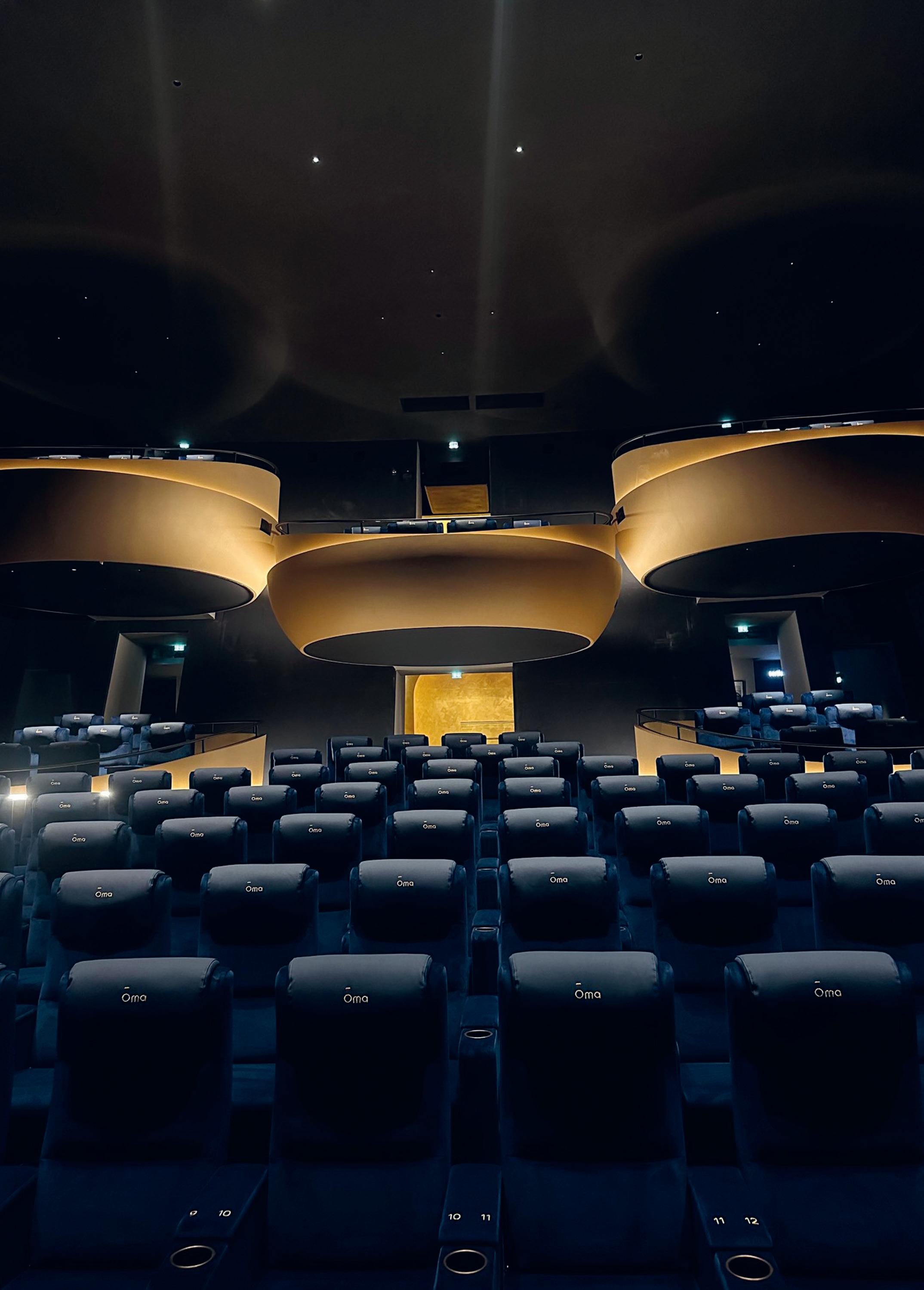
AUDIENCE REACTION & DATA
Audience response to the Oma Cinema in Mougins has been highly positive and demonstrable. Following an extensive pre-opening marketing campaign, the cinema experienced remarkable attendance at launch, with hundreds queuing to experience the new venue. Notably, occupancy data shows impressive results. Nicolas Chican noted specifically: “From opening until December 2024, the five pods, which contain 40 seats, recorded approximately a 50% occupancy rate, significantly higher than typical cinema averages.”
Furthermore, audience preferences became clear through a structured onsite survey of over 300 respondents conducted in late 2024. This research identified the central pod as particularly favoured, validating the design and reinforcing the demand for such premium, intimate seating. Pricing data supports this preference, with pods priced at €15 compared to €13 for regular stalls, yet regularly selling out first. What is also notable is that the seat comfort and experience in the stalls (non-pod) area are equal in specification to the pods themselves. The seats are identical reclining chairs with clean sightlines and excellent audio. This was intentional, ensuring that guests who choose the stalls still receive a high-quality experience. While the pod structure offers a premium configuration, the stalls reinforce the cinematic quality without feeling secondary.


Expansion to Dubai: Scaling the Concept
In April 2025, Oma Cinema expanded internationally, opening its second auditorium in Dubai, located within the VOX Cinemas flagship venue at the Mall of the Emirates. The location is one of the most prestigious and visited cinema sites in the UAE, and Oma was introduced as part of VOX’s overall premium rebranding initiative.
The Dubai installation, unlike the purpose-built Mougins venue, involved retrofitting an existing auditorium previously used for IMAX screenings. The space came with both opportunities and constraints—high ceilings and a vast footprint provided the volume needed to introduce Oma’s vertical pod configuration, but the retrofitting process had to account for existing infrastructure, projection angles, and seating expectations.
The result was an Oma auditorium featuring seven suspended pods—two more than the Mougins setup—positioned around a 23-metre-wide screen that retained the scale and grandeur of its IMAX predecessor. Each pod is luxuriously finished and tailored for the Dubai market, offering expanded legroom and integrated food service options. Each pod also includes a discreet dumbwaiter, enabling direct delivery of gourmet food and drinks from the on-site kitchen straight to the customer’s seating area. This refinement aligns with VOX Cinemas’ goal of positioning itself as a destination for bespoke cinema
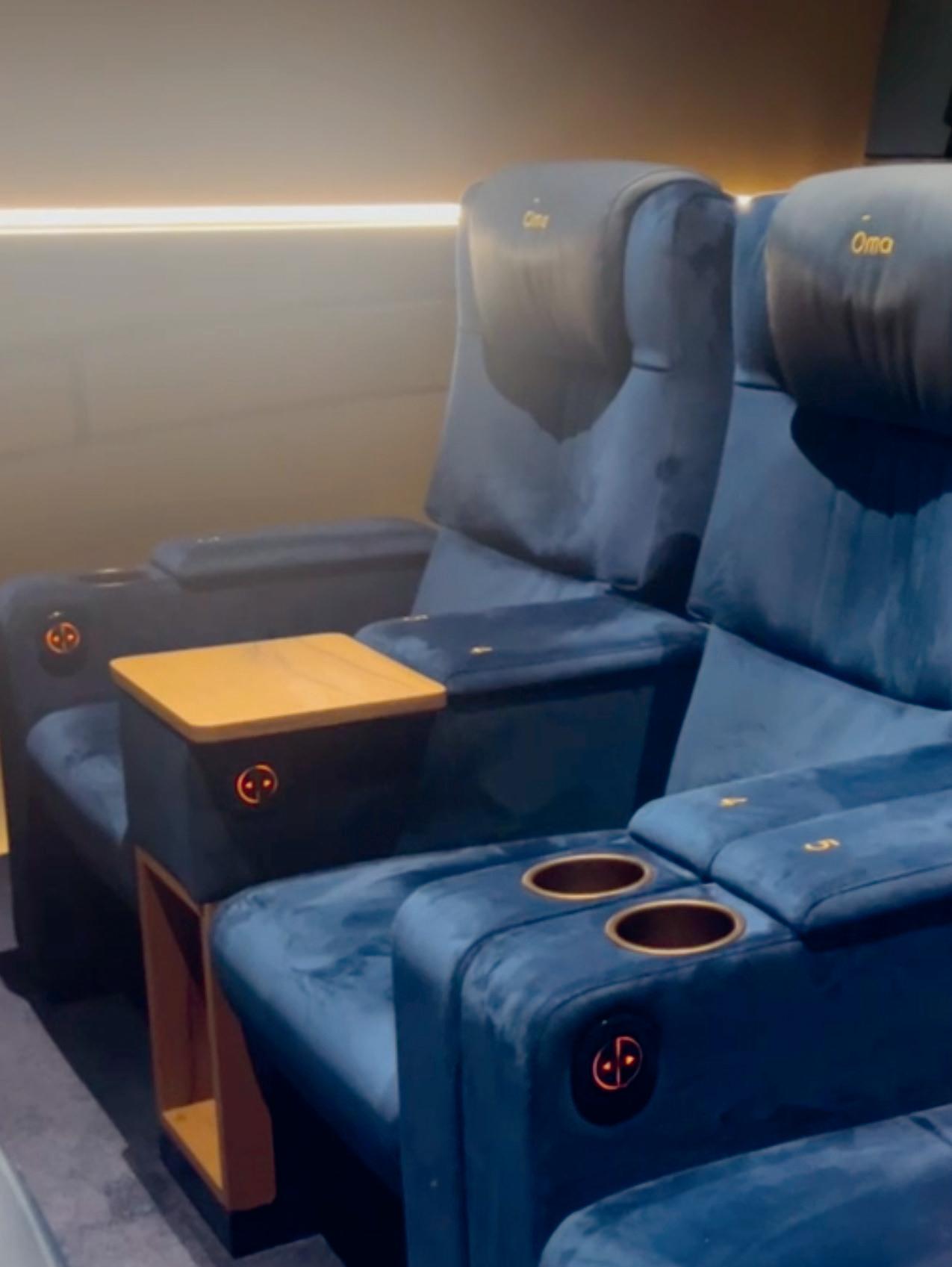
experiences. Nicolas Chican described the result as a true hybrid: “In Dubai, it was a renovation of a former IMAX theatre. We combined the IMAX technology with our pods structure. It was our first collaboration with IMAX, resulting in a 23-metre-wide screen and seven pods instead of five.”
The Dubai site pushes the boundaries of the Oma concept by integrating high-capacity screen formats with the pod model. This expansion also reveals the flexibility of the Oma framework—it is not limited to new builds or boutique auditoriums but can be adapted for larger, pre-existing venues without sacrificing the core architectural or experiential principles.
In keeping with VOX Cinemas’ high-end positioning in the UAE, the Dubai Oma experience also includes upgraded finishes—upholstered recliners with suede-effect detailing, gold-trimmed lighting accents and a more private entrance corridor into the auditorium. The environment is positioned less as a traditional cinema and more as a hybrid between a luxury box and private theatre experience. It reinforces that while Oma is a modular concept, it remains adaptable to the cultural and economic priorities of each market.
Oma’s success in Dubai also presents a significant milestone in its international strategy: this was the first instance of the concept being applied outside of Europe, and its seamless integration into a commercial multiplex setting bodes well for its

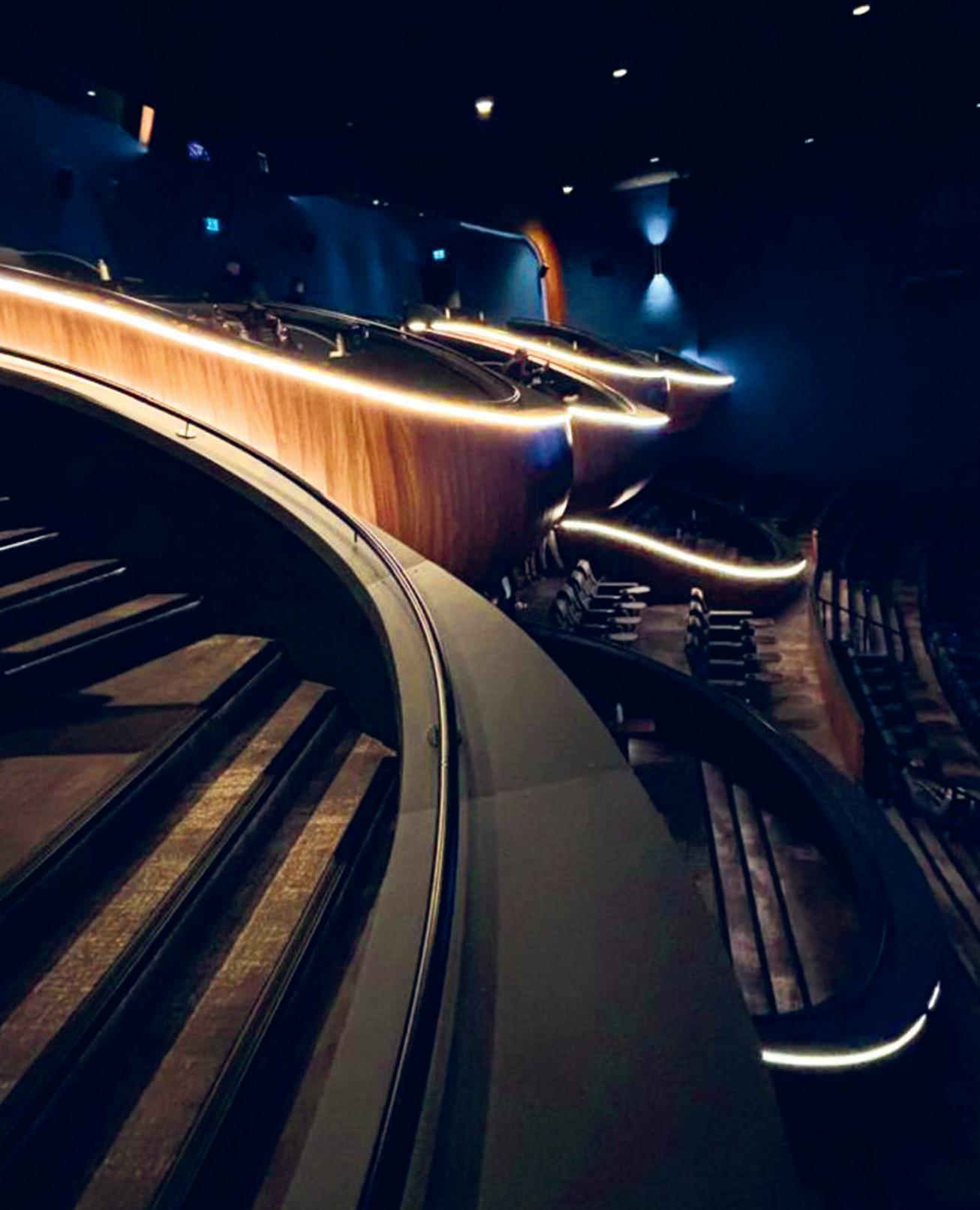
scalability. Audiences in Dubai, accustomed to highend hospitality and bespoke entertainment, have responded well according to early anecdotal reports and partner feedback from VOX. The flexibility to retain IMAX-grade screen sizes while offering smaller seating clusters in pods illustrates Oma’s potential as a multi-format solution.
Beyond technical innovation, the Dubai venue underscores Oma’s growing status as a design brand—a signal to audiences that they are not simply seeing a film but entering a new form of cinematic space, one that combines architectural spectacle, technical excellence, and elevated customer service.
Foyer and Entrance Experience
The Mougins site houses three screens, confirming its status as a boutique multiplex location. The foyer is designed to suit a boutique multi-screen setup. The entrance space is bright and airy, avoiding an industrial feel while still offering a modern and premium environment. The concessions stand, bar, and ticket office are all combined into a cleanly designed area to the right of the main doors. There are seating areas for patrons to relax before their screening. To reach the standard auditoriums, patrons proceed through a corridor located at the
rear of the foyer. The Oma Cinema auditorium, however, branches off to the right, clearly marked with its own gold signage and design motif that continues the aesthetic introduced in the original 2022 concept visuals. A separate seating area is positioned outside the entrance to the Oma auditorium, further emphasising the separation of this premium offering.
This deliberate physical and visual separation reinforces the idea that seeing a film in the Oma auditorium is a distinct experience. With only a few euros difference in ticket price between the stalls and the pods, the value proposition for such an upgrade feels compelling without tipping into luxury pricing that might dissuade typical cinemagoers.
The Movie-Goers Experience With Oma
What stood out most, though, was the feeling that Oma truly understands the emotional importance of the cinema visit. It reminds us that architecture and atmosphere can heighten the anticipation, focus the senses, and elevate a standard screening into something memorable. As cinemas continue to compete for attention and footfall, concepts like
Oma prove that investment in experience—real, physical experience—can pay off in loyalty and word-of-mouth just as much as the latest laser projector or immersive audio format.
Like all special auditoriums, whether Dolby Cinema, Ice Theatres, or ScreenX, Oma Cinema provides a specifically branded and uniquely designed entrance area, in this case, featuring an elegant gold aesthetic. This design deliberately evokes a sense of anticipation, exclusivity and VIP treatment as audiences prepare to enter. Approaching from behind the pods, visitors immediately notice that this is not an ordinary cinema space; there is something distinctly different and mysterious about it.
Ascending the steps into the pods creates a tangible moment of awe. From the middle pod, one can gaze upward at the pods on either side, each subtly illuminated, almost appearing as futuristic spacecraft emerging from the darkness. Access to the pods involves crossing a small bridge equipped with glass barriers, adding further to the unique experience. At the front of each pod, a handrail overlooks the pods below, enhancing the sense of height and exclusivity. The immediate impression upon entering was a strong sense of excitement
"Dolby designed a special sound system to ensure all areas, especially the pods, are covered with immersive audio."

and grandeur. Descending to the lower pods and standard seating area, the presence of a bar at the back of the auditorium further emphasises the venue’s premium nature. The atmosphere was reminiscent of a sci-fi environment, something akin to a scene from a futuristic movie. Despite constant step lighting within the pods for safety, the auditorium was otherwise pleasingly dark, minimising distractions and enhancing the viewing experience.
During the film screening, several distinct sensations were noted: The futuristic architecture and lighting created a genuine sense of being within a futuristic setting. Sitting in the pods was reminiscent of being at the back of a traditional multiplex auditorium but with increased privacy and exclusivity. The enclosed nature of the pods provided an intriguing mix of exclusivity and mild claustrophobia, a combination that added positively to the overall experience. The pod arrangement clearly lends itself ideally to group viewings, such as family outings or gatherings with friends, offering a feeling of both separation and communal participation simultaneously.
The Christie laser projector, discreetly positioned within its dedicated pod, delivered a flawless, vibrant, and consistently bright image, irrespective of seating position. Notably silent, the projector produced no audible distraction. The immersive audio system, designed with Dolby’s collaboration, was particularly impressive delivering an optimal sound quality. Initial concerns regarding potential acoustic interference from pod placement proved unfounded; dedicated pod speakers and strategically positioned additional surround and subwoofer speakers delivered exceptional sound quality. Dialogue was clear, surround effects immersive, and the overall audio experience exceeded expectations. Through intelligent design, the pod arrangement likely has minimal impact on the shared audience experience during busier screenings. Any communal
reactions—laughter, gasps, or applause— remain largely unaffected, echoing experiences in traditional cinema spaces. The design, reminiscent of theatre boxes or opera house seating, successfully combines exclusivity with the traditional cinema-going atmosphere.
Architectural Lineage and Legacy
Pierre Chican, the architect behind Oma, is no stranger to innovation in cinema spaces. With a career spanning over four decades, he has designed more than 300 cinema screens across France and abroad. Chican’s work includes layouts for Pathé, UGC, CGR, and Kinepolis, and his experience is woven into every element of Oma’s design—particularly in how the visual aesthetic supports the technical requirements of cinema projection, audio dispersion, and audience comfort. Oma is, in many ways, the culmination of that experience—a rethink that dares to question the long-standing horizontal design that has dominated for decades.
Future Outlook
As Oma expands further—installations are in development in Chartres, Casablanca, and multiple Asian territories—it’s clear the model offers flexibility. Whether through retrofits, like Dubai, or new builds as in Mougins, the core idea of offering a unique, technically excellent, and emotionally compelling cinema experience is proving scalable.
The pods may not replace traditional rows, but they offer something different—something memorable. And for a medium as emotional and immersive as cinema, that difference may be the key to unlocking new levels of audience engagement.
As Oma Cinema continues to expand globally—from its European roots to premium destinations like Dubai—it represents more than just a new seating format; it embodies a rethinking of the entire auditorium experience. Cinema Technology Magazine looks forward to following this evolution, which is as much about architectural storytelling as it is about technological excellence.
In an age where audiences seek more personal, premium, and purposeful experiences, and exhibitors are eager to differentiate and diversify, Oma offers a compelling and refreshing roadmap. It bridges art and engineering, nostalgia and futurism—redefining not just what cinema can look like, but how it can feel. If this is the future of auditorium design, it is one shaped as much by imagination as innovation.













LASER ILLUMINATION IN CINEMA’S
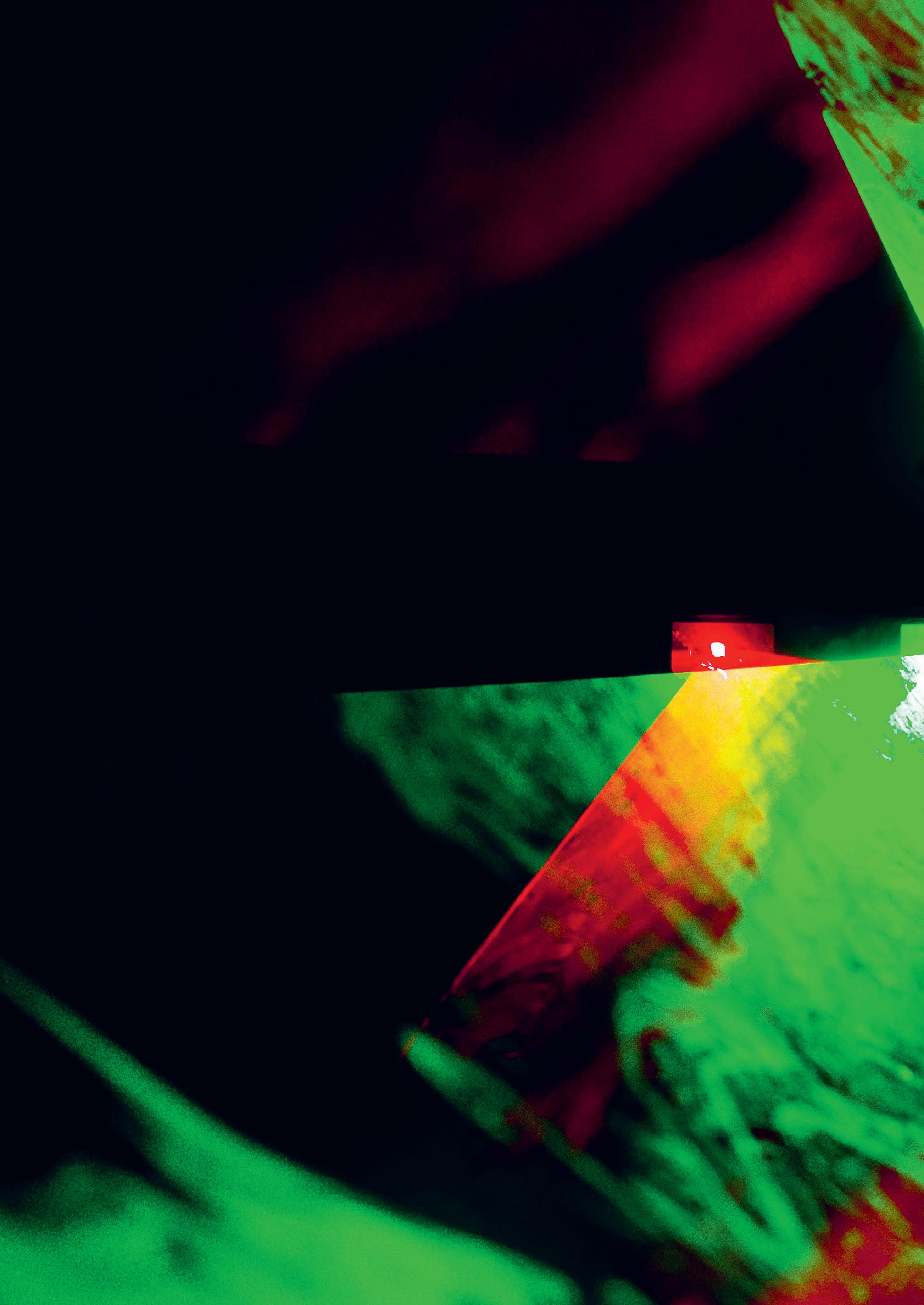
WORDS: PETER WILSON
Part 2 of Laser Illumination in Cinema’s highlighted several issues caused by using Direct Laser Narrow-band Illumination in the Cinema. We subsequently polled some representatives of Cinema Projection and Colour Grading area’s and report here feedback.

CINEMA EXHIBITION
We interviewed Mike Bradbury, Group Head of Sound and Projection at Odeon Cinemas Group a representative of one of the largest cinema chains in the UK and across Europe with a prepared questionnaire.
So when did you first realise there would be a problem with perceived colour in cinema with direct laser illumination?
Probably around 2014 /15. It was at IBC in Amsterdam, There was some discussion about it and there were various people doing presentations on laser projection. I initially latched on to Metamerism as well as Speckle. I was particularly interested in laser illumination because the panelists were talking about laser illumination as being super efficient. Efficiency was definitely the next thing we needed to do when it came to cinema projection. It can also offer more advantages when it comes to a wider colour gamut. For example, filmmakers can utilise that for brighter presentation for High Frame Rate (HFR) movies with a higher perceived resolution with less strobing, and for better brightness and 3D fusion in 3D movies. So films like those made by Pixar really lend themselves to it and they are probably one of the main studios that are pushing the technological boundaries into new areas. I think at that time it was Inside Out distributed in ITU 2020 Colour space. There was real excitement at the time to try and push the boundaries of colour space into a ITU-R Rec 2020 world, although it’s worth noting that not all Cinematographers like it.
Can you briefly outline what Issues you encountered?
This was the beginning. It was probably around 2014 when I first started to hear about Narrow Band Laser Illumination. This is when my ears picked up to say, well, this is all very nice, but we cannot ignore obvious artifacts. My concern, if I am honest, at the time was more around speckle - we cannot ignore that. We cannot bring speckle into the cinema because, digital cinema was supposed to be bringing in a new advent of superb images. What we didn’t want is for the world to start going off in lots of different directions. What was supposed to make cinema better, actually ends up making it worse in some ways. It just felt like there were things being pushed that were not quite ready yet. I was waving the flag for a discussion about speckle and
metamerism. At the time metamerism was not my main concern. That seemed to be more of a concern for colourists and people who were deeply involved in the science of it. Speckle was much more obvious.
What steps did you take to avoid the problems created by using Direct laser Illumination?
We started to test some laser projectors, particularly the RGB Direct laser projectors. That was when it really started to hit me how difficult it was to get the colours looking the same as that of Xenon illumination. It was a little alarming to me, which is when I started to ask more questions around how we would make this work? We installed a Xenon illuminated projector and an RGB laser projector side by side into one of our former sites in London in 2016/17. We compared a Xenon projector and a Direct Laser Projector and we made a split screen system. We could easily see that the colours were not right on the laser projector. We utilised a digital camera because it shows everything up including things that the human eye sometimes cannot see, especially when it comes to colour, contrast and shading. The split screen showed visibly different colour, particularly on whites. The whites were measurable using a colour meter but we had to use a more sophisticated meter with a narrower bandwidth to read the laser wavelengths, because a normal colour meter could not accurately detect the colours as the laser was using such a narrow bandwidth. We needed a meter that used smaller reading cells, I think it was two or three nanometers rather than five. We managed to obtain one of those and then took the reading of the Red, Green and Blue and inputted that into the projector, and then utilised the meter to help calibrate the colour ensuring we achieved the right colours for DCI Compliance. We ran tests and we just could not get the right colour. And what was making it particularly obvious was, that we did not need the side by side to see that it wasn’t the right colour, but when you did put it side by side, it really emphasised the differences.


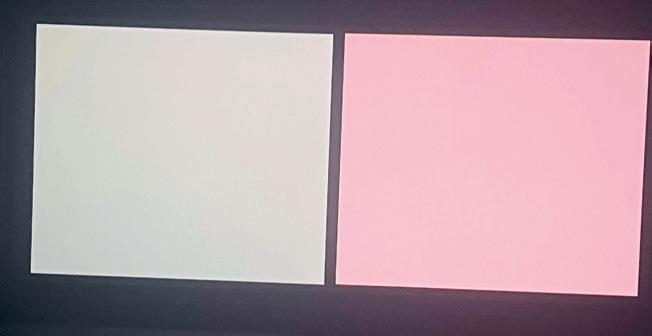
We invited a few industry people in to have a look and they were all a little alarmed. I think they all thought it was probably a teething problem and that it would get there, because why would you spend so much money on this when it clearly isn’t right? But it was mainly the whites, and it had a real red bias to everything because the white was so pinky. That’s when I really started to worry. In order to get it right, they had to adjust it slightly. They almost had to trick it so that it was right.
To my eyes, it looked okay with the exception of the speckle, which was a separate issue. But then we left it because it was a soak test. We left the projector in place for quite a few months and when we came back it had gone pink again. And what we couldn’t understand was why that had happened. Apparently one of the other lasers, either the red or the green, had diminished. From memory it was the green and therefore it created a bias because they were no longer equally calibrated. So there was no automatic adjustment to compensate. It required us to go back in and basically re-measure the colours and try to adjust for the change.
So that started to raise alarm bells for me because I was of the mindset that I needed a projector that I could effectively just install and forget about for most of the time. Of course you expect some basic maintenance, but we do not want to have to keep going in every two, three, four months to recalibrate the colour, it’s just not practical. That is when I started to ask more questions and put pressure on all the projector manufacturers to try and get the equipment better, get it more reliable and get it so that there are compensatory elements operating if anything fails.
I care about what goes on screen, how it looks and, that’s not just what it looks like just on Premiere screens in Central London, it’s also what it looks like in everybody’s local cinema. You do not want to end up with something that is a benefit but has a negative associated with it. To put things into perspective, it’s a little like the transition from 60s, 70s and 80s film stocks where films start to look different because the film stocks changed. Nobody was saying that we should not change the film stock ever because it does not look the way it used to. From a creative standpoint, when we project a film, we’re supposed to project it as the filmmaker intended, and if we are not projecting it as the filmmaker intended, that is a very slippery road to go down.
You said that your Company does not have any Direct Laser Projectors but you use two different types of Laser Phosphor projectors. Yes, the Laser Phosphor Projectors started off with less brightness but are improving. They are less efficient than Direct laser but the phosphors generate wide band colour so the effect of metamerism is much less and the phosphor breaks up any speckle. I keep an eye on direct laser performance but as the problems are problems of physics and human genetics I don’t see a quick solution.
COLOUR POST PRODUCTION
We interviewed Cinelab Film and Digital CEO, Adrian Bull. Cinelab is one of the last Laboratories in Europe able to process all motion picture film formats and offers extensive digital services.
When did you first realise there would be a problem with perceived colour in the Cinema with direct laser illumination?
I was in MPC’s theatre in Wardour Street (London) in April 2023 and they had their installed projector split screened with conventional DLP Xenon Illumination on the left side and a direct laser projector on the right hand side.
The background of the test was that they knew that when using photo spectrometers, even though they were lining them up to the tightest tolerance for that photo spectrometer, they weren’t matching a reference projector specification. You could see a difference. And the worst thing was that you could adjust it by eye from that.
But due to the narrow bandwidth of the Red, Green and Blue lasers, the photo spectrometer wasn’t able to sense colour precisely enough to identify the difference, so you couldn’t get a number for the difference.
Because you couldn’t rely on the photo spectrometer to be accurate and reproducible, it was considered that they were going to try and work out what the offsets could be to standardise it as much as possible. What they’d done was set up a BaseLight Colour Corrector in the theatre and invited people from the industry including Colourists to come in and sit on the BaseLight and adjust the grade with reference images to match the projectors.
Despite the fact that the projectors were lined up, they could dial in the offset and they basically recorded a table of all of these offsets. The idea was to create an average offset as a result of the input #from many observers.
After watching for about 10 minutes, I finally said to them, “what are you guys doing?” And they looked at me and they said, “what do you mean?” I said, ”look, in the last 10 minutes, I’ve seen that nothing’s matched.”
Harkness Screens
Launches IndustryFirst Engineered 2d/3d Screen For Laser Projection.
HARKNESS Screens, one of the world’s premium cinema technology companies, unveiled its brand new fifth generation 2D/3D screen technology, Hugo SR at CinemaCon 2024.
They could not have been further apart - I’d not seen anything on the screen that matched it looked pink!. Just, by chance, I took my iPhone out and the pictures on this were consistent with what I was seeing. Another person captured the screen with a Samsung Phone and they were similar to the iPhone. I took a photograph of the screen with my iPhone. Figures 1,2 and 3 (opposite) are the photographs from my iPhone. The next step was for me to grade the laser so it matched the DLP Xenon for my eyes.
with laser projectors in mind. With in-built characteristics that reduce visible speckle and improve contrast, Hugo SR provides exhibitors with a means to fully utilise laser projection technology creating even more compelling and captivating movie presentations,” explains Laurent Espitalier, CTO at Harkness Screens.
shifted by about 15nm towards red which is why a narrow band display will tend to look pink/ magenta. It is not a form of colour blindness, it’s more accurately described as colour difference.
Arts Alliance Media Appoint Alan Bowen as Chief Executive Officer
The result of more than five years of research and development alongside projector manufacturers, educational institutes, global exhibition and the Hollywood community, Hugo SR has been designed to support and leverage the benefits of all types of laser projection including RGB. “Over the past few years we have seen the laser projection install base grow significantly across the globe. Whilst laser projection has so many tangible benefits, our customers, wider exhibitors and partners have turned to us to provide a dedicated screen solution that can enable them to leverage the benefits of this new technology to its fullest including, higher contrast, HDR (high dynamic range) and WCG (wide colour gamut). Hugo SR, is the first engineered screen designed specifically
The third image is the photograph that was taken when I thought both images matched. If you look closely at that third image, there is still a slight difference in what the iPhone captures, although the live projected images did look closer on screen to me. The effect of me grading to compensate for what was right for me, meant everybody else in the room saw the laser projector as green.
The phenomenon is called Deuteranomaly and it affects about 4% of men and less than 1% of women. My medium wavelength cones are
ARTS ALLIANCE MEDIA (AAM), THE GLOBAL leader in digital cinema software and support services, recently announced the appointment of Alan Bowen as its new Chief Executive Officer (CEO) with immediate effect. Since joining AAM in 2019, Bowen has played a pivotal role in the company’s evolution, holding key positions including Chief Financial Officer (CFO) and Chief Operating Officer (COO). With over 30 years of executive management experience in the finance, entertainment, and technology sectors, operating in both B2C and B2B markets, Bowen has a demonstrated history of enhancing operational efficiency, fostering economic growth, and driving strategic business initiatives for leading organisations across Europe and the U.S.
“I am honoured to take on the role of CEO as
SPECKLE REDUCTION TECHNOLOGY
What steps did you take to mitigate issues caused by Direct Laser Illumination?
Light Sources such as Direct Laser. It may be necessary in the future to create an eye test for existing and new Colour Grading staff, and anyone who could be contributing to the creative grading finishing process.

I have been aware of the effect for some years when reviewing certain flat screen displays and they often didn’t match for me.
Once aware that this issue affects the use of
we usher in a new era at Arts Alliance Media,” said Alan Bowen. “AAM’s esteemed legacy, unwavering commitment to innovation, and exceptional team make it one of the most dynamic, forward-thinking companies in the industry, and I am delighted to lead the next phase of our journey.
Direct Laser Projectors in the Grading room and some of the available LED Displays, particularly QD OLEDs, which have similar issues, it allowed us to educate staff and at least mitigate for the risk of this becoming an issue.
I look forward to empowering the exhibition community with unrivalled solutions that enhance theatre operations and elevate the moviegoing experience.”
Laser speckle, most visible with RGB projectors (but also present, although less visible with other projection technologies) has been a concern for exhibitors looking to leverage laser projection. Hugo SR has been engineered to significantly reduce visible speckle by up to 30% compared to traditional high gain silver and white screen surfaces. The unique properties of Hugo SR allow exhibitors to deploy higher gain surfaces alongside RGB projectors without the requirement for expensive transducers whilst creating a level of assurance that laser speckle will not interfere with the viewing experience for the majority of moviegoers in the auditorium.
help to improve contrast by up to 15% compared to traditional silver and white screens creating more vivid colours with blacker blacks and whiter whites. Although a polarised 3D screen, the underlying technologies create a truly whiter surface which looks more similar to Harkness’ industry leading white gain (Perlux HiWhite) screens on axis. This optically whiter surface helps to diffuse visible hot-spotting and create the appearance of a more uniform finish from centre to edge.
commitment to serving their global customer base, AAM will continue to provide powerful and progressive cinema solutions under Bowen’s leadership, including theatre and hardware management software, APIs and cloud services, and hardware devices such as HeyLED, underlining its position as the go-to technology provider for exhibitors worldwide.
NEXT TIME
As CEO, Bowen will remain steadfast in his mission to accelerate business growth, enhance customer satisfaction, and strengthen the company’s ability to further shape the industry’s future.
SUPERIOR OPTICAL ENGINEERING
Over the course of the last three editions of this publication, we have sought to highlight the challenges faced by the industry as it seeks to adopt direct laser projectors and we have now heard about the challenges facing those assessing the technology during its infancy.
In the final part of this series (in the next edition) Kommer Kleijn will answer a number of interesting questions posed by CT Magazine’s readers related to this series.
Abiding by their core company values; empowerment, passion, innovation, and
The unique surface coating properties of Hugo SR
As 4% of men are affected by Deuteranomaly the chances are that we will find established Colour Graders who are Deuteranomalous. Up until now this has not been critical with wideband projection light sources such as Xenon or CRTs that have a wider SPD of the green phosphor. This problem becomes apparent with Narrow Band
“We’re excited to begin the roll-out of Hugo SR technology around the world,” explains Mark Ashcroft, CEO at Harkness Screens. “Hugo SR creates a new technology platform for Harkness and a new industry standard for laser screens. At Harkness, we continue to invest in research and development teams and are already working with our suppliers and partners developing further 2D and 3D screen technologies that already show signs of being able to virtually eliminate visible speckle whilst retaining the gain profiles exhibitors require in order to financially manage their shift from xenon-based projectors to laser. We feel we’re on the cusp of something transformational for the entire industry” he concludes.

IMPROVING VISUAL PERFORMANCE, WITH A SOFTWARE UPGRADE?
Showcased privately at CinemaCon and CineEurope last year, Christie went a step further at CinemaCon this year publicly displaying their forthcoming Variable Dynamic Range (VDR) solution. CT Magazine caught up with Ben Wagner (Senior Director, Cinema Program Management at Christie) to learn more about VDR.
WORDS: CT EDITORIAL TEAM.
How exactly does VDR work from a technology standpoint? What is happening to the content?
There are two modes with VDR: Standard Mode and Performance Mode. In Standard Mode, each video frame is analysed to identify the brightest pixel, and the laser power adjusts to match the brightness of the brightest pixel. For example, if the brightest pixel requires 80% laser power, the laser power is set to 80%. To maintain the correct brightness, the video level of all pixels is scaled up. Furthermore, the sequential contrast ratio can be increased by lowering the laser power. Dropping the laser power to 30% from 100% can theoretically triple the contrast ratio. Due to the DCI HDR addendum, the contrast ratio is limited to approximately 5000:1 for standard dynamic range (SDR) content. Similar adjustments and scaling occur in Performance Mode, but to greater extents, to enhance performance and allow up to a 60,000:1 sequential contrast ratio. This process ensures the video maintains high dynamic range and accurate brightness levels across all frames.
Does VDR require a separate DCP?
VDR in Standard Mode does not require a different DCP. It works with the existing 48-nit, 14ft lambert standard DCPs, constituting 99% of current distributions. In Performance Mode, an HDR-graded DCP is required. Some studios, such as Pixar, are already creating these DCPs to support direct-view LED screens that meet the DCI HDR addendum, referred to as HDR1. VDR is a flexible technology that can accommodate any future HDR grades specifically for HDR projectors. Standard grades shouldn’t be

used with VDR performance mode at high brightness levels (for example, 300 nits) as they are not colour graded or intended for such high brightness.
At what brightness level does a VDR system ideally run at and is there a minimum by which it ceases to improve image quality?
In standard mode, VDR ideally runs at 14ft lamberts (48 nits), and can double the sequential contrast ratio. This additional contrast should improve image quality to the same extent as using an Ultra High Contrast projection lens, without suffering from the resultant brightness reduction. In Performance Mode (designed for HDR), it requires higher brightness at the top end and allows lower active black levels at the bottom end. This should provide drastic improvements from around double standard brightness (96 nits) and upwards, achieving a full dynamic range of 60,000:1 sequential contrast.
Assuming VDR utilises a standard DCP, how does the solution ensure compliance with DCI
standards given that the presentation of the content, it could be argued, is changed from how it was intended?
The content in Standard Mode is not changed from what was intended. The DCI standard specifies 2000:1 nominal sequential contrast ratio, with a minimum of 1500:1 in review rooms and 1200:1 in exhibition. The upper limit on sequential contrast is set by the minimum active black level specified in the HDR addendum for “SDR mode of an HDR capable display” defined as no less than 0.01 nits, which combined with peak luminance of 48 nits or 14 ft lamberts, represents a sequential contrast ratio of 4,800:1. There’s a tolerance of +/- 3 ft lamberts on this peak luminance, so at the high end it ends up limited to 5,800:1. Thus, standard mode contrast ratio between 5,000:1 and 6,000:1 represents the best possible image quality within the bounds of creative intent when grading for most cinema exhibition. With Performance Mode, HDR content grading is done on systems like direct-view LED or a Dolby Vision projector, at much higher brightness and contrast
ratios. VDR in Performance Mode has been designed to comply with the latest DCI standards, including the compliance test plan version 1.4, which specifies HDR capability testing for HDR projectors and direct-view LED systems.
What does it entail from a hardware perspective? Is it simply a software upgrade? Is it suitable only for RGB projection?
VDR can be enabled on any current Christie Real|Laser™ projector with CineLife+ electronics and LOSv2, the latest generation laser optical system (LOS). For specific models, VDR will be a simple software upgrade. Hardware upgrade kits will be available for others, especially those released before LOSv2. Unfortunately, older Series-2 and -3 electronics can’t be upgraded to Series-4 CineLife+.
In addition, specific models may require minor hardware updates, such as a control board or harness change. This is still being evaluated across all CineLife+ RGB models. Enabling VDR within Christie RGB and RGBH projectors will require a software upgrade and a license payment.
Does VDR make any material changes to presentation quality, for example, does it produce any more or less speckle?
VDR does not affect laser speckle. Laser speckle is an interference pattern that occurs when laser-based light from narrow wavelength sources is projected onto a surface, creating bright spots perceived as speckling in the image. This speckle effect can be mitigated using lower-gain screens or vibrating screens. It’s significantly worse with silver screens used for polarization maintenance, which become more perceptible with increased brightness. In brighter systems, such as those using light steering or performance mode VDR-enabled Christie projectors, speckle can be mitigated with appropriate screen material choices or screen vibration. At CinemaCon 2025, a 2-gain silver screen was used with vibration, resulting in no negative comments about speckle, even at 300 nits peak brightness.
Power savings have been mentioned as a benefit of VDR. How quantifiable are these?
VDR offers significant power savings, with over 40% laser power savings observed in some content we’ve tested to date. However, exact numbers are still being quantified and are very content-dependent. For SDR-graded content, savings can exceed 16%,

while HDR content can see savings over 40% due to the lower achievable laser powers in darker scenes. These savings are influenced by the range of laser power operation, with lower power usage in performance mode leading to greater savings. The savings are highly content-dependent. For example, if a movie consistently uses 100% peak brightness, there would be no savings. We expect most features to fall within the 16% to 40% savings range. We’ve been testing various content using input power monitors on actual projectors. In standard mode, energy savings will benefit exhibitors by reducing electrical costs and extending laser life. A 16% decrease in power usage could potentially increase laser lifetime by 50%.
Given that there are power savings, what is the impact on extending the life of the laser?
With Christie’s LOSv2 laser devices and drivers, operating at lower average power extends the life of the laser in a non-linear relationship. A 30% reduction in power usage can extend laser life by 70%, while a 16% reduction can extend it by 50%. Further scenarios can be explored with the laser device manufacturer based on the tested content.
VDR was shown at CinemaCon and CineEurope last year with what felt like an official launch at CinemaCon this year. What have been the learnings over the past 12 months?
Over the past 12 months, VDR has been demonstrated in one-on-one meetings with studios and exhibitors at CinemaCon and CineEurope. This year, 2025, we showed VDR to the public as a technology preview demonstration. We’ve heard exhibitors express a lot
of interest in the energy savings, laser life extension and improved image quality. So we’re prioritising and working towards launching Standard Mode by the end of the 2025 calendar year.
What has been the reception from studios and filmmakers?
Performance Mode requires more time to extensively review content, perform algorithm refinement to meet DCI compliance, and get acceptance from filmmakers. Studios are taking more of a “wait-and-see” approach. The Performance Mode technology shows off the benefits of HDR in cinema, but perfecting this mode and creating a pipeline of content may take longer, extending beyond the end of this year. Studios have been really excited and cooperative, but there’s only limited HDR content for testing, making the process slow.
Is there any type of content that lends itself more to VDR or is it a general improvement?
VDR offers a general improvement in image quality and economics, especially in Standard Mode, which benefits all types of content without requiring significant additional investment. However, VDR Performance Mode enhances dynamic HDR content with a mix of bright and dark scenes, such as dramatic, action and horror movies. This mode showcases the high dynamic range capabilities, making it ideal for content with significant interplay between very dark and very bright scenes.
When will it be commercially available?
We are targeting the end of this calendar year for Standard Mode and we don’t have an established timeline yet for Performance Mode.

IN SEARCH OF THE ALL-DIGITAL B-CHAIN
WORDS:
BY MARK MAYFIELD, MEYER
SOUND.

It’s been over 25 years since cinema technology entered the digital age, and nearly a decade since most of the world’s screens converted to digital projection. Digital technologies have fundamentally changed the way movies are made and played.
For live action films, it’s quite common that an image is only converted from analog to digital once (by a digital camera) before it is converted back to analog as light in the theatre.
For animated films, the image never needs to be analog until it is projected as light. But for sound, it’s a different story. Endto-end digital signal transmission for cinema sound is only just now becoming a reality. In traditional B-chain systems, there are sometimes up to three stages of analog-todigital (A-to-D, or A2D) and digital-to-analog (D-to-A, or D2A) conversions. Each stage is a potential source of data error, signal loss, and noise - and thus distortion - of the original signal.
An analog audio signal is continuous over time, like a smooth sine wave. Converting a continuous analog signal to digital requires it to be sampled very frequently over time so that it can be converted into a numerical representation of that smooth signal. This is the process of digitization.
Factors Affecting Conversion Quality
There are three main parameters to consider when assessing the effect of A-to-D and D-to-A conversion: sampling rate, quantization, and compression.
Sampling rate is the number of times per second that the analog signal is measured. In the digitized sine wave shown in figure 2, each horizontal “tread” on the steps represents one sample. In the early days of digital audio, a sampling rate of 44,100 times per second was quite common and considered adequate; in fact, this is often called “CD (compact disc) quality”. More recently, engineers have found that much higher rates (96 kHz or 192 kHz) can result in even less distortion and better sound quality. The higher the sampling rate, the better the resolution of the audio signal. Theoretically, an infinite number of samples would essentially be a continuous signal, like the original analog signal produced by a natural sound source (human voice, musical instrument, a roaring lion, etc.).


Quantization is the process of taking all those samples and reducing the number of them to more manageable quantity. This is accomplished by process similar to rounding or truncating the values of the sampled quantities. Quantization can introduce distortion know as “quantization error”, similar to the way that rounding of numbers can introduce a degree of error in a mathematical calculation. Different methods of managing error determine the effect on ultimate sound quality. This quantization of the samples results in compression, which is the encoding of information using fewer digital “bits” than the original sampling. Compression is often necessary because of the vast quanity of data required to represent a complex signal such as audio. But compression can also introduce trade-offs of its own: in order to reduce file size, data regarded as non-essential for human auditory perception is discarded (also called “lossy compression”). Lossless compression, on the other hand, allows the original signal to be perfectly reconstructed; however the trade-offs include much larger file
sizes requiring increased storage capacity, required bandwidth for file transfer, and loading time between devices (known as “latency”).
An analog-to-digital converter is usually implemented on a custom integrated circuit (IC). Depending on the manufacturing process of the chip, other nonlinearity errors can occur which ultimately affect the signal-to-noise ratio of the device.
For all of these reasons, in order to optimize ultimate sound quality, system designers prefer to minimize the number of A-to-D and D-to-A conversions in a signal path.
The Traditional B-Chain Approach
The DCP (digital cinema package) contains both digital image and digital sound files. Image files go directly from the IMB embedded in the projector chassis to the projection engine, while the digital sound files leave the confines of the projector on its way to the final analog destinations: the loudspeaker, the room, and ultimately, the ear.
The first stop is the cinema processor. Most, if
not all, cinema processors now accept AES3 (or AES/EBU) digital inputs on RJ45 connectors and cabling from the IMB. Coming out of the cinema processor the signal is subject to its first digital-to-analog conversion on its way to the power amplifier (assuming the power amplifier does not allow digital inputs).
While there are many types of power amplifier designs, an increasingly popular topology is called Class D. These designs operate in the digital domain, so any analog signal coming in must be subject to a stage of A-to-D conversion.
As the amplified signal leaves the power amplifier, it is once again converted from digital to analog so that it can be sent down the (sometimes very long runs of) copper loudspeaker cabling, on its way to the loudspeaker.
Each of these stages of conversion risks signal loss, increased noise due to improper gain staging, and other unwanted digital artifacts. All of these conditions are types of distortion that affect the sound quality.
4 ALL-DIGITAL SIGNAL PATH
A better system design would be one that minimizes - or eliminates - A-to-D and D-to-A conversions, thereby preserving to the greatest extent possible the integrity of the audio signal throughout the chain, from the IMB to the loudspeaker. Borrowing from the IT world, this networked approach uses standard audio-over-IP (AoIP) layer 3 protocols to maintain the digital signal path. In this case, the loudspeaker itself is essentially a network endpoint,
like your laptop on an office network. The power amplifier has a digital input and is integrated with the loudspeaker, which eliminates long loudspeaker cable runs and enables power matching to the loudspeaker and optimized digital signal processing. The result is a truly end-to-end digital signal path which removes the need for D2A converters, simplifying the complete B-Chain and reducing variables and room for error.
DCI THEATRICAL CLASSIC DCI THEATRICAL NEXT GENERATION
5 TELEMETRY IS TRANSMITTED VIA NETWORK TO MONITOR MANY PARAMETERS OF OPERATIONAL STATUS FOR EACH LOUDSPEAKER COMPONENT

Since it’s a network, data can be bi-directional, allowing telemetry to be sent back upstream through the network to a PC (figure 5).
This allows you to monitor operational status, such as the condition of each individual driver, electronics, and overall system health.
SPOTLIGHT ON NOVIE HOUSE CINEMAS
The Independent Movie House Cinemas Circuit in Northern Ireland was formed more than 35 years ago by Michael McAdam. Over many years Michael has developed and refined his cinemas, and today there are four sites across Northern Ireland; Maghera comprising three screens, Glengormley comprising six screens, Cityside in Belfast, the chains largest site in terms of screens with fourteen and the Jet Centre Coleraine with eight screens.
WORDS: SANDIE CAFFELLE, GOVERNOR, CTC.
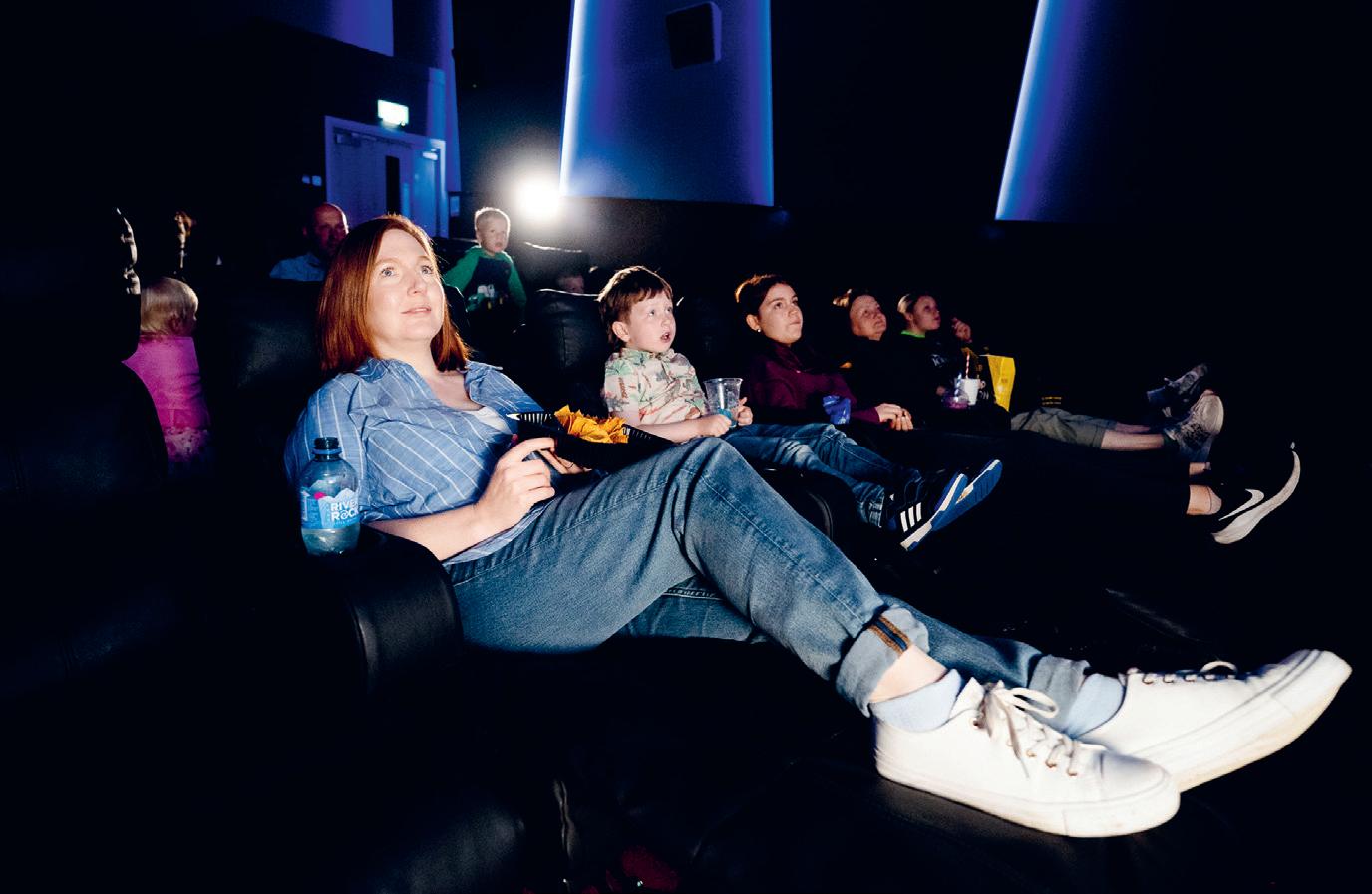
Michael can definitely be regarded as a trailblazer and was an early adopter of the “multi-site” venue - a model we are all too well aware of now. It is also worth noting that from the very start, Michael championed equality and diversity in the cinema industry. He has always made a conscious effort to create inclusive and positive working environments by hiring a number of female cinema managers, many of whom are now long-standing employees and fiercely loyal to the business. That this may not have been the norm for the industry until a few years ago, for Michael this has always been at the heart of creating good cinemas.
Mixed Entertainment
The Jet Centre in Coleraine is Michael’s ‘Jewel in the Crown’ and features an 8-screen cinema, ten pin bowling, an 18-hole miniature golf course, a kids’ soft play arena, an outdoor mini fun park, a gem mining attraction and a large amusement arcade.
Again, showcasing Michael’s trailblazing nature, the site was acquired in 2006 and many of these additional entertainment options were defined in the refurbishment plan at the time.
The Jet Centre stand out as different from your Movie Houses other “traditional” cinema sites. But as Michael explains, it was a natural thought process and it’s paid huge dividends. “I loved the idea of a multi-use site with cinema helping market the other leisure facilities. This has been a great success particularly at times when cinema product has been limited. It’s enabled us to keep a broad base of customers visiting the site and driving revenue.”
The offerings are split into indoor and outdoor attractions. The indoor attractions alongside the eight screen cinema are:
Superstrikes is a 14-lane full size bowling alley and also features 4 mini bowling lanes for the younger children and families. Hot food, soft drinks and alcohol is available.


Alleycats is a large indoor children’s playground and is popular with children up to 11 years of age. Tea, coffee, soft drinks and a hot food snack menu is available daily.
Outdoors, the 18-hole mini golf, mini amusement park and gem mining generate great interest and business for the site particularly in the summer months and school holidays.
Michael however points to one major surprise success in his armory which he hadn’t expected.
“The indoor amusement arcade featuring redemption ticket games and prize shop is the greatest surprise of all the attractions. Its popularity is unreal and attracts players of all ages. We really didn’t see that being as huge a success as it’s turned out to be.”
And whilst there have clearly been a number of enormous successes, Michael is the first to admit there have also been a few elements that haven’t been as successful as he’d hope. “The biggest disappointment is the outdoor amusement
park. I really got that one wrong. Equipment is expensive, requires strenuous safety checks and is labour intensive to operate. It also requires an everrefreshing customer base in order to break even which is a challenge.”
Operating a number of entertainment offerings may sound daunting, not least from the perspective of software systems but Michael and the team have been able to keep this streamlined. “For the most part, Admit One software is used in the cinema, shop and restaurant areas within the centre with a separate software for the bowling scoring and booking,” explains Michael.
The Cinema Offering
Movie House offers the usual range of food and drinks at its kiosks and was among the first to offer salted popcorn and nachos to its menu in Northern Ireland. Due to a recent change in the law in Northern Ireland, cinema customers can now enjoy an alcoholic drink with their movie. Currently three of the Movie House sites are licensed to sell alcohol, offering a selection of wine, bottled beer and cider.
Whilst the cinemas showcase Hollywood content, there is also a large focus on Event Cinema allowing the Movie Houses to appeal to a wide demographic of movie-goers. On top of wanting to create inclusive workplaces, Michael’s vision was always to create spaces suitable for everyone to watch movies. At the beginning of each month, Movie Houses cinemas in Cityside (Belfast) and Coleraine hold “Relaxed Screenings”. These screenings offer a relaxed atmosphere that is sensory friendly. The screenings are open to everyone and are clearly marked on the cinema’s web site. These screenings are held at a quiet time of day - usually around 11am on Saturday and Sunday - so that there is reduced noise in the foyer.


As well as ensuring the cinema is quieter small adaptations are made to make the presentation of the film sensory friendly including the removal of ads and trailers, the house lights turned up a little, the sound turned down and the freedom for audiences to move around. Private bookings are also catered for, and the weekend private birthday parties have proven to be particularly popular.
Efficient Waste Management
Michael and the team continue to look at methods for reducing energy usage. In 2024, the circuit converted all cinema and foyer lighting over to LED and installed more energy efficient HVAC systems resulting in a 30% reduction in energy usage. And whilst Movie Houses is in the process of transitioning from xenon-based projection to laser to further lower energy usage, one key component of the strategy to reduce their carbon footprint has already been completed.
Michael explains that “in 2024 we installed a large rubbish compactor to help reduce the carbon emissions associated with our waste management. This has greatly reduced the number of bins and skips we use to collect waste with only one collection now required every six weeks or so compared to three visits each week which was the previous norm. That’s quite a significant reduction in the amount of emissions associated to waste alone. Of course, holding waste on site for a number of weeks has its challenges, but the compactor is a sealed unit
"...if you're not investing, you can be sure your competitor is!"
which keeps all the refuge contained safely away from the extremes of the weather and rodents.”
Always Think Ahead
Michael recognises that the market, and indeed consumer behaviour, has changed dramatically in recent years and that the viability of a standard cinema, at least in his local market wouldn’t make a lot of sense going forward. “Whilst I have always loved cinema, I would not open another standalone site and would strongly recommend the multi-use leisure location to anyone looking to open a cinema to help reduce the reliance on movies,” he explains.
And whilst Michael continues to trailblaze, he has wise words for aspiring independent cinema operators that seek his advice. “It is so important to reinvest every year whether that be projectors, seating, carpets - if you’re not investing you can be sure your competitor is,” he adds. Wise words from a cinema operator that has recently finished converting all of its 31 screens to comfy electric reclining armchairs supplied by VIP Luxury Seating and Ferco Seating Ltd.

CT EVENTS
REPORTS AND REVIEWS OF GLOBAL INDUSTRY EXPOS
CinemaCon 2025 – A Bright Future for Big-Screen Innovation

CinemaCon 2025, held in Las Vegas from 1st to 4th April, brought together over 6,000 global delegates from the cinema industry, offering a packed week of studio showcases, keynote addresses, and crucially – for our readers – a bustling trade floor brimming with technology. In a year defined by resilience and evolution, this year’s convention painted a confident picture of a sector embracing innovation – from premium projection and sound to operational AI and sustainable design. The message was clear: cinema is not just back, it’s reimagining itself for the decade ahead.
Projection, HDR, and the Continued Rise of Laser
Projection technology remained a key focal point at CinemaCon, with manufacturers keen to demonstrate
that visual excellence can be a defining part of the theatrical experience. Barco used the show to highlight the maturing of its HDR Lightsteering system, HDR by Barco. While first unveiled in 2023, Lightsteering was showcased more extensively this year with updated demos and use cases. The technology allows light to be dynamically directed within the image frame to increase contrast and brightness selectively – giving what Barco describes as a true HDR image experience suited for premium large-format (PLF) applications.
Barco also emphasised its comprehensive laser projection strategy. The company’s portfolio now supports venues of all sizes, from boutique screens to major multiplexes. Importantly, Barco noted it has surpassed 45,000 laser projector installations worldwide, underscoring the widespread industry adoption of laser-based systems. For exhibitors yet to make the leap, Barco’s Laser Light Upgrade kits offer a
way to retrofit older xenon-based projectors – with the added benefits of lower maintenance, longer life, and reduced energy consumption.
Elsewhere, Christie introduced its new Variable Dynamic Range (VDR) system – a software-based HDR solution compatible with its existing CineLife+ Series RGB laser projectors. Capable of delivering up to 300 nits brightness – significantly above standard cinema luminance – VDR enhances contrast by dynamically adjusting light output on a scene-by-scene basis. Crucially, it supports standard DCP content and requires no new mastering pipeline or hardware swap, making it a practical route to HDR for many operators. Christie stated that VDR will roll out later this year as a firmware upgrade, giving exhibitors an immediate route to enhanced picture performance. Dolby Laboratories, together with Christie, also used the event to debut a next-generation Dolby Vision projector. The new RGB laser model offers extended dynamic range, improved brightness, and a reduced physical footprint – addressing the installation challenges faced by earlier Dolby Cinema systems. This development paves the way for more flexible deployments of Dolby’s premium format. Supporting this, AMC Theatres announced plans to add 40 new Dolby Cinema sites by 2027, raising its count to over 200 – a sign that PLF formats with true HDR are firmly part of the cinema recovery roadmap. Meanwhile Harkness showcased a conceptual prototype for its replacement to the popular Digital Screen Checker. More than 5,000 of the small hand-held blue units shipped around the world between 2011 and 2019.
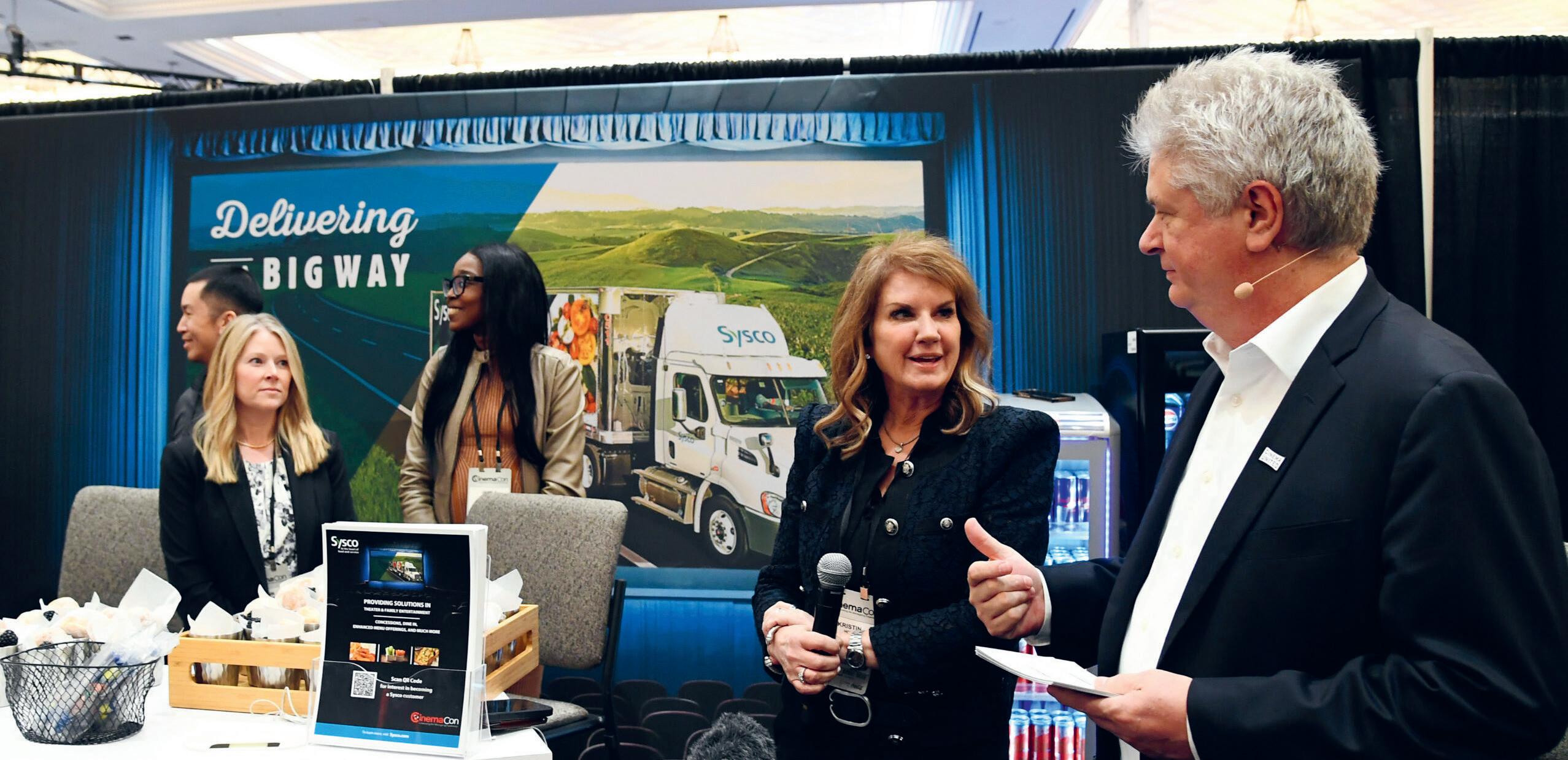
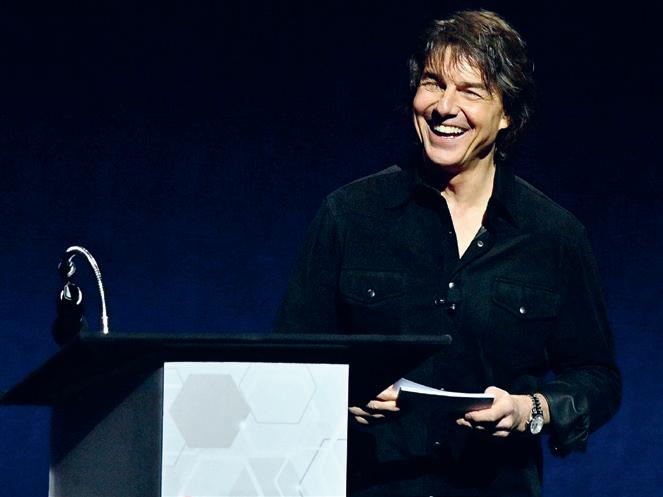
The new unit which is scheduled for official launch at CineEurope is sleek and features audio functions as well as brightness measurement capability.
LED Displays and the Battle for Premium Visuals
Direct-view LED cinema displays continue to push into the mainstream, with Samsung unveiling the latest iteration of its Onyx Cinema LED solution. Featuring 300 nits peak brightness, modular screen sizes up to 20 metres, and true black capability, the new version offers visual performance that rivals high-end projection – with the added benefits of uniformity, low maintenance, and a 10-year warranty.
Audio integration – a historic challenge for solid LED panels – is also improving. Samsung’s current designs allow compatibility with all major immersive sound formats and proprietary solutions enable synchronised speaker placement even without perforated screens. Meanwhile, GDC Technology showcased a prototype acoustically transparent LED display, hinting at future screens that may allow direct
sound-through designs akin to traditional cinema setups. These developments suggest LED will increasingly be an option for premium screens –particularly in new builds or major refits – and may soon be a central part of the premium experience offer.
Immersive Formats Continue to Expand
It was also a strong year for CJ 4DPLEX, which announced a significant new rollout with AMC Theatres and Odeon Cinemas Group. The deal will see 40 new 4DX motion-enhanced auditoriums and 25 ScreenX panoramic screens added across North America and Europe – marking the first domestic expansion of ScreenX within AMC.
These experiential formats, offering 270-degree visuals or synchronised seat movement and environmental effects, have shown enduring appeal as exhibitors look for fresh ways to differentiate the big-screen offer. In parallel, IMAX and Dolby Cinema continued to grow their footprints, cementing PLF as a central pillar of post-pandemic exhibition strategy.
Sustainability in Focus
While not always front-and-centre in press materials, sustainability was a recurring theme in many sessions and manufacturer discussions. Laser projection is inherently more energy-efficient than xenon and products such laser light upgrades reflect a broader shift toward greener tech. Samsung’s LED panels boast long lifespans, with minimal recalibration and fewer component replacements over time.
Exhibitors also shared examples of sustainable practice at the operational level – from solar panels and motion-activated lighting to compostable concession packaging. While there’s no silver bullet, there is an encouraging trend: environmental efficiency is now being baked into both technology roadmaps and business strategies.
Theatrical Windows, Unity, and the Path Forward
In the opening keynote, Michael O’Leary, CEO of Cinema United (formerly NATO), strongly defended the importance of a consistent 45-day theatrical window. He argued that such a baseline protects box office value and curbs piracy while allowing time for a film’s word-of-mouth to develop. While acknowledging that some flexibility may be needed for smaller releases, the prevailing sentiment across panels was one of unity: exhibitors and studios alike see cinema as the creative and commercial foundation of the film business.
CinemaCon 2025 showed an industry not only recovering, but reinventing itself. From HDR-enabled laser projectors and immersive formats to data-driven marketing and sustainability solutions, the tools now exist to deliver a big-screen experience that is compelling, efficient, and future-ready.
Technology remains a driving force behind that evolution – and as demonstrated on the floors and in the suites of Caesars Palace, the cinema of tomorrow is being engineered today.
Innovation Lights the Way at UKCA Conference 2025
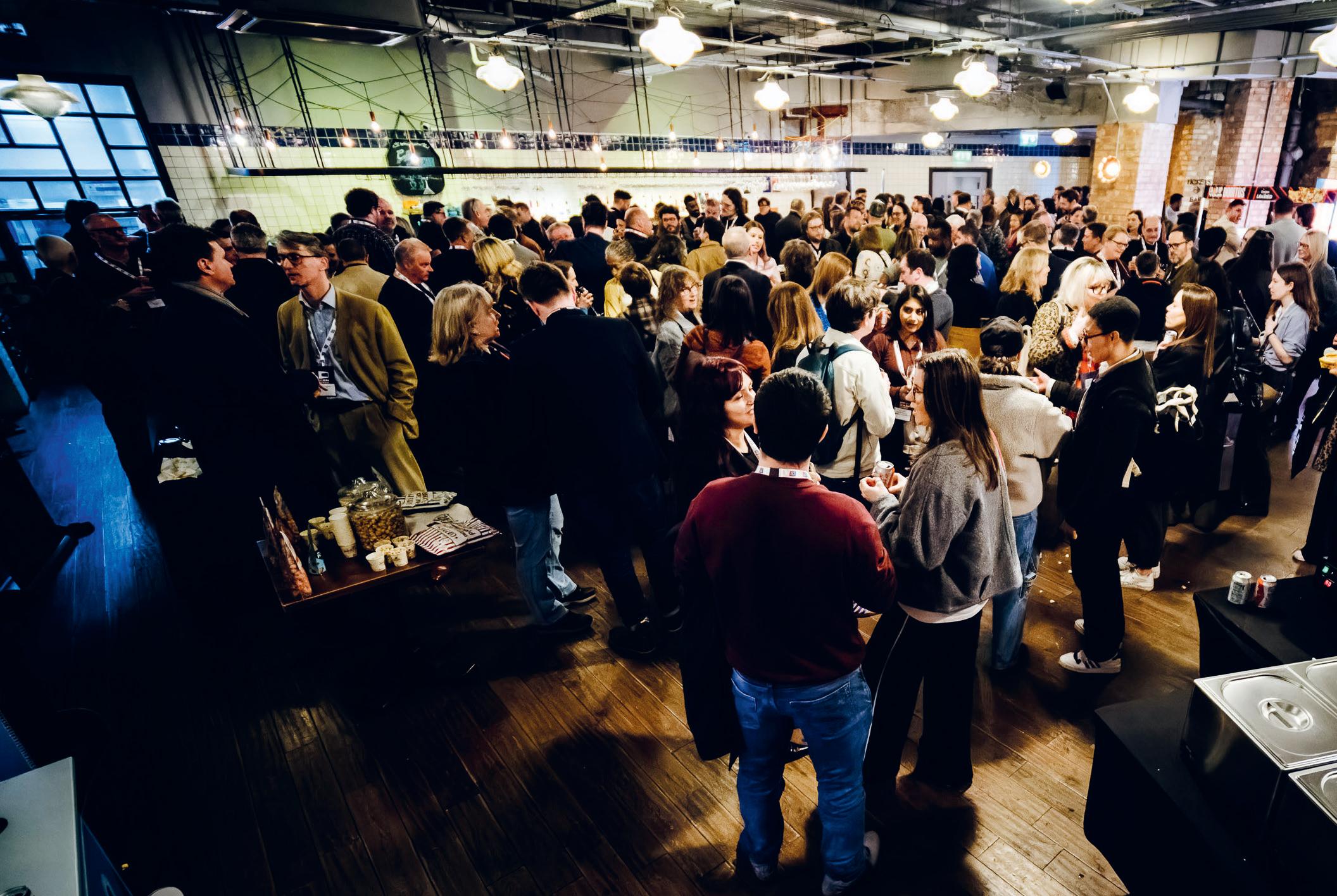

The UK Cinema Association (UKCA) Conference 2025 – held on 18–19 March at Picturehouse Central in London –brought together cinema operators, distributors, marketers and technologists to explore the theme “Innovation and the Big Screen Experience.” Across two packed days of presentations and panel discussions, industry leaders examined how fresh thinking is driving a post-pandemic recovery. From box office trends and marketing to new audiences, sustainability initiatives, cutting-edge technology, youth engagement and operational best practices, a unifying message emerged: embracing innovation at all levels is key to cinema’s future success.
BO Performance & Industry Outlook
A candid executive roundtable of industry figures set the stage with a state-of-the-sector overview.
Participants acknowledged that the road to recovery, whilst promising, remains uneven. 2024’s box office had notable highs and lows – over 1,100 new titles were released (the most in years) as studios worked through backlogs, yet the year also saw slow periods (notably in May and October) due in part to production disruptions and strike-related delays. One major studio’s representative reported a strong yearend finish in 2024, helping lift overall admissions, while an independent cinema executive argued that smarter scheduling of releases (avoiding too many big films clustering together) could further improve grosses. Looking ahead, the content pipeline for 2025 appears robust – with forecasts for around 15 releases to exceed the £20m box office mark – but much of this strength is concentrated in the latter half of the year. Alongside optimism, the roundtable injected a dose of realism. Several speakers noted that UK

cinemas are still rebuilding audiences to pre-pandemic levels amid rising operational costs. “Recalibrating expectations” was advised – even with a strong slate on the horizon, admissions may take time to fully rebound. Audience behaviour has also shifted: viewers are now highly selective and quick to respond to word-of-mouth. As one exhibitor observed, robust social media and review culture means customers often cancel their tickets if early reviews disappoint. This puts pressure on both studios and cinemas to deliver quality content and excellent customer experience every time. The panel also questioned an overreliance on predictive models –citing one much-hyped sequel that underperformed –underscoring that data forecasts can mislead if not tempered with on-the-ground insight.
Despite these challenges, the prevailing mood was hopeful. There was broad consensus of optimism for 2025, with cinema operators and distributors alike expecting at least as good a year as the last, if not better. Representatives from major chains noted that the coming year’s film slate (including contributions from major studios) is particularly strong. Crucially, panelists agreed that converting this promise into reality will require action: implementing feedback from audiences, collaborating more closely across the industry, and staying flexible in strategy. Suggestions included more open data sharing between distributors and exhibitors to help each other succeed, and greater programming flexibility – for example, relaxing
restrictions that prevent smaller or single-screen cinemas from showing new releases immediately. Likewise, a more adaptable approach to theatrical release windows was discussed: panelists pointed to instances where films thrived with longer runs or nontraditional scheduling, and urged the industry to tailor run lengths and release strategies to a film’s size and audience, rather than one-size-fits-all rules.
Marketing Innovation and Engaging New Audiences
If one theme resonated strongly throughout the conference, it was the need to reinvent cinema marketing to connect with today’s audiences –especially younger generations. Multiple sessions addressed this challenge from different angles. A panel on reaching Generation Z and Generation Alpha emphasised meeting young people on their own terms. Speakers stressed authenticity, cultural relevance and creative use of digital platforms as keys to engaging the under-25 demographic. Augmented reality features, short-form mobile content, and creator-led storytelling were all discussed as powerful tools in capturing the attention of digital-native audiences.
Conference sessions also provided first-hand insights from young cinema-goers themselves, via a special youth panel. These candid contributions reinforced some home truths: price and value matter greatly to teens and students, and many are deterred
by high ticket costs. Likewise, basic cinema etiquette and venue upkeep – everything from picture and sound quality to cleanliness – can strongly influence a young person’s decision to visit (or avoid) the cinema. The young panelists expressed enthusiasm for the big screen when the experience feels special, citing genres like sci-fi and Marvel-style spectacles as draws, and suggesting ideas like fan event screenings, filmmaker Q&As, and film club nights to make cinemas more of a social hub. They also pointed out pain points: a poor atmosphere (say, disruptive behaviour in the auditorium, or unclean facilities) can spoil the outing. These reminders grounded the discussion: even as marketing goes digital, cinemas must continue to deliver on-site excellence to earn young audiences’ return visits.
Another major strand of marketing innovation focused on big-picture campaign strategy and industry-wide challenges in audience outreach. A case study of Wicked: Part One – which topped the UK box office in 2024 – illustrated how event-style marketing can re-energise interest in cinema. The film’s marketing lead described efforts to create a “cultural moment” around the release – from aligning promotional beats with major UK events to striking high-profile brand partnerships. Over 18 months, the Wicked campaign secured collaborations ranging from a viral tie-in with Robinson’s to a takeover of London’s St Pancras station with a spectacular themed Christmas tree. Department store Liberty even dedicated window displays to Wicked, featuring an elaborate hand-painted Wizard’s mask prop. The results were striking: tens of millions reached on social media and a total PR reach in the billions. Yet for all this buzz, the Wicked team acknowledged a core challenge: turning broad awareness into actual cinema attendance, particularly for a musical – a genre that doesn’t always convert younger viewers despite high familiarity of the IP.
Indeed, one sobering statistic shared was that only a small fraction of cinema customers are consistently aware of upcoming releases. Modern audiences, especially younger ones, are inundated with content choices and spend hours scrolling feeds, often on a second screen while doing something else. Research has shown a decline in unaided recall of movie titles in recent years. To combat this, studios and exhibitors are increasingly turning to data-driven, targeted outreach.
A forward-thinking panel titled “Fresh Perspectives: Applying Innovation from Other Sectors” reinforced that cinema marketing can learn a great deal from retail, hospitality and beyond. Marketing leaders who had joined the cinema industry from other fields spoke about injecting new ideas: one described how community partnerships and localised content can humanise a cinema brand, while another suggested membership-style engagement for cinemas. The consensus was that cinemas must combine nationalscale messaging with local community connection. As one marketing director noted, a cinema chain might run 50+ national campaigns a year, but ensuring those campaigns truly connect means translating them to each venue’s context –partnering with local businesses, tapping local influencers, and recognising the unique tastes of a given city or town.
Amid all the new tactics, speakers also urged a return to fundamentals: start outreach earlier and sustain it longer. Launching teaser campaigns well in advance – then retargeting interested consumers over time – can pay dividends in both cost efficiency and audience buildup. Membership schemes (like cinema subscriptions or loyalty programs) were also highlighted as valuable tools, not only for their immediate revenue, but for the first-party data and direct channel they give cinemas to inform members about upcoming films.
Sustainability and Cinema’s Green Initiatives
Building on momentum from last year’s conference (which was devoted entirely to sustainability), the 2025 event shone a spotlight on environmental innovation in cinema operations. A highlight was a “green practices” case study presented by Omniplex Cinemas, showcasing their pioneering reusable cups programme. This initiative, implemented across the Irish circuit’s locations, addresses the mounting pressure to eliminate single-use plastics in concessions. In response to new regulations in Ireland (and anticipated legislation UK-wide) targeting disposable packaging, Omniplex took proactive steps to replace throwaway soda cups with durable,
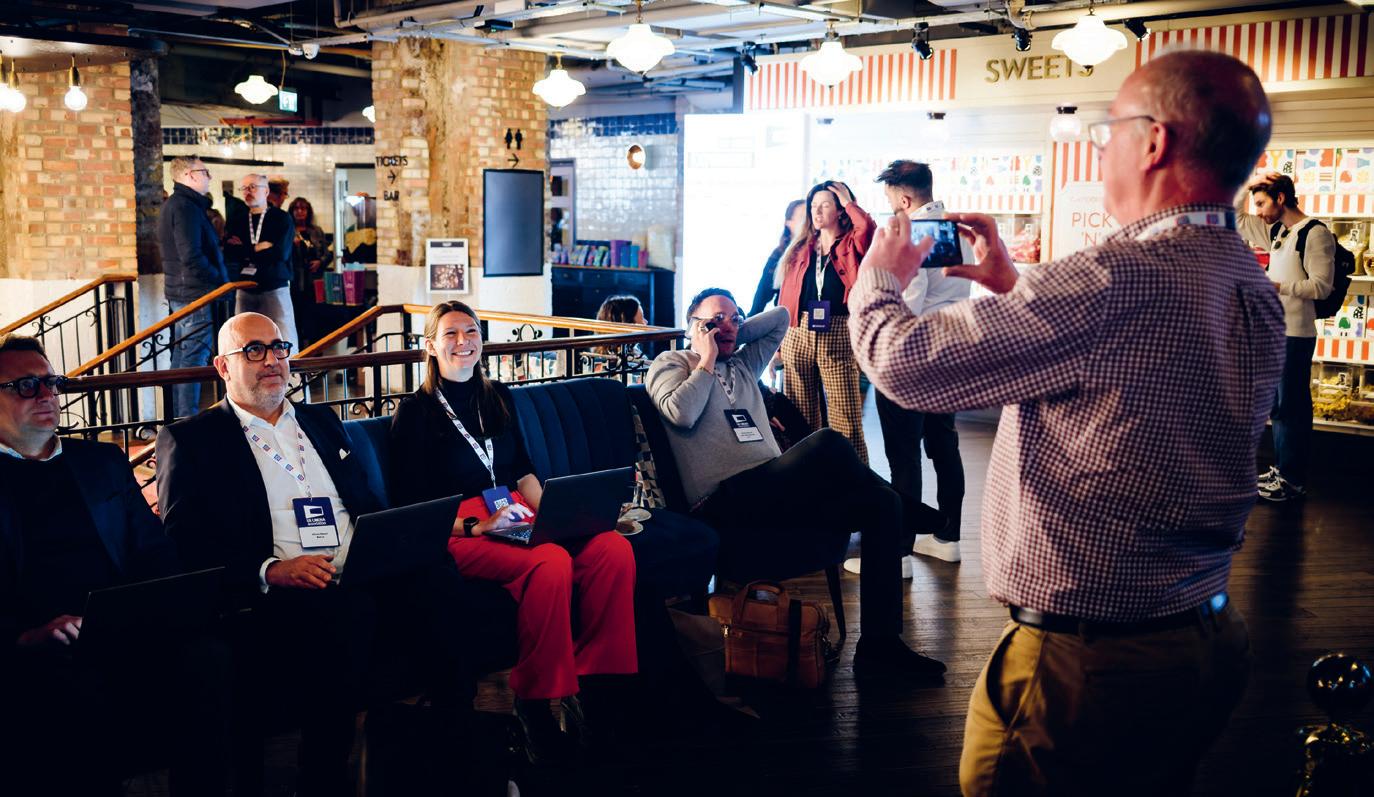
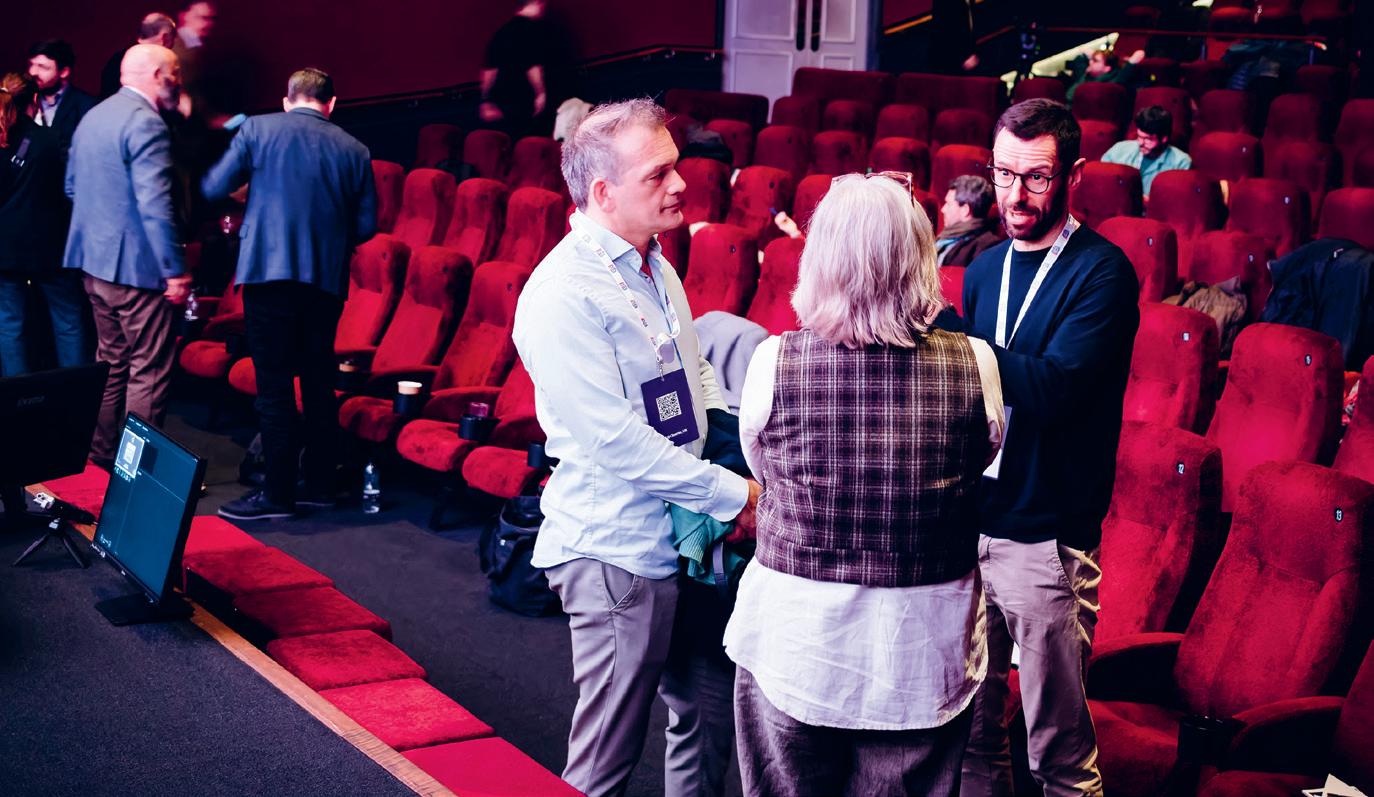
washable ones. The programme’s champion, Paul John Anderson, shared the journey – from early trials to full rollout – and its impressive results. By integrating reusable cup systems (and even redesigning concession counters to accommodate washing and return), the chain has dramatically cut waste: internal data showed an almost 90% reduction in disposable cup usage once the scheme was in place. Importantly, Omniplex designed the programme to be cost-neutral or cost-saving, with savings on single-use stock offsetting the upfront investment in industrial dishwashers and cup inventory. Conference delegates were particularly interested in the practical lessons from this venture. One challenge Omniplex encountered was customer behaviour – for example, some patrons initially treated the reusable cups as throwaways or even souvenirs to take home. In response, the team improved signage and staff training to encourage returns, and even turned to social media with lighthearted messaging. The cups themselves became a talking point, boosting the cinema’s image as a sustainability leader. As UK cinemas face forthcoming bans on single-use plastics, this case
study provided a valuable template for how to adapt operations in a way that is both eco-conscious and commercially sensible.
Technology Developments: Enhancing the Cinema Experience
A dedicated panel on the “Future of cinema technology” examined emerging formats such as LED cinema screens, High Contrast Ratio (HCR), and Variable Dynamic Range (VDR) projection. Representatives from leading manufacturers including Barco, Christie, and Samsung presented innovations aimed at improving visual performance, reducing power consumption, and enhancing overall picture quality. Christie’s VDR technology – Variable Dynamic Range – featured prominently. VDR is a softwareenabled enhancement available on many of Christie’s existing projectors, delivering improved contrast and brightness modulation with significant energy savings. Unlike full HDR systems, which often require hardware upgrades, Christie’s VDR can be activated through firmware updates, making it a cost-effective upgrade path for operators looking to improve visual quality without replacing their entire fleet.The panel discussed
the challenge of justifying investment in premium formats when fundamentals such as brightness and picture stability still vary widely across venues. One speaker noted that consistent delivery of a high-quality base experience matters just as much as occasional “wow factor” screens – especially when trying to win back audiences accustomed to high-end home entertainment systems.
Conclusion: Innovation Through Every Lens
By the time UKCA’s Chief Executive Phil Clapp gave his closing remarks, the message was clear: the UK cinema sector is firmly focused on innovation as the path forward. Yet, as the conference content showed, innovation in this context was defined broadly. It’s not just flashy tech upgrades or experimental marketing stunts, but a holistic willingness to try new approaches in every facet of the business – whether that be programming, customer outreach, environmental responsibility or
leveraging technology to be more efficient. Crucially, many speakers noted that innovation must serve a purpose: enhancing the audience experience and reinforcing cinema’s unique appeal. The 2025 UKCA Conference highlighted an industry in creative motion. Four years on from the worst of the pandemic, UK cinema is rebuilding with fresh ideas –finding opportunity in adversity by adopting lessons from other sectors and boldly reimagining its own practices. The event served both as a reinforcement for those present – validating the innovative projects many have already launched – and an inspiration for those not in the room, who will benefit from the collective knowledge disseminated.
If the ideas shared at UKCA 2025 are any indication, the big screen experience will continue to evolve – with a blend of creativity, technology and community spirit – to meet the demands of a new era of cinemagoers. And as it does so, it will keep the magic of cinema alive and well for the next generation.


CineEurope 2025 – Preview of a Big-Screen Summit in Barcelona


Europe’s premier cinema exhibition convention, CineEurope, returns to Barcelona on 16–19 June 2025. Now in its 34th edition, the event will gather thousands of industry professionals at the CCIB to celebrate all things big-screen – from exclusive studio previews to the latest cinema technology. Delegates will network with peers from across the globe and explore Europe’s largest cinema trade show, where manufacturers unveil innovations in projection, sound, seating, and theatre management. Alongside the trade fair, a program of seminars and panels will examine the key trends shaping the future of movie theatres.
Studio Showcases & Industry Insight
CineEurope 2025’s lineup features presentations from all the major Hollywood studios alongside
leading European distributors. Disney, Warner Bros., Universal, Paramount and Sony are slated to showcase their upcoming slates, joined by regional players like StudioCanal. These sessions – with exclusive footage and early screenings –give cinema operators an early look at the blockbuster and local content headed to theatres in the coming months.
The convention also offers plenty of insight from industry leaders. UNIC (the International Union of Cinemas) will kick off proceedings with a keynote by President Phil Clapp and CEO Laura Houlgatte, setting the stage for wider discussions. One opening address will contend that cinema’s biggest challenge today isn’t streaming or AI, but retaining audience attention in an age of endless entertainment choices. Other seminars will cover practical topics – from using social media to boost movie attendance to making the cinema experience more “frictionless” with self-service tech innovations. There’s even a session exploring how AI tools could streamline operations and how exhibitors can attract new talent to the sector. The recurring theme is that combining great content with great customer experience will keep cinemas thriving.
Technology and Trends on Show
For technology enthusiasts, the CineEurope trade fair is a highlight. The CCIB’s main auditorium will transform into a state-of-the-art theatre for the week – featuring a 21-metre Harkness Hugo SR screen, six Barco 4K RGB laser projectors (including dual units for 3D), and an immersive Dolby Atmos audio system. This top-tier setup, ensures every studio showcase looks and sounds its best on the big screen.
On the exhibition floor, leading vendors will display their newest products. Laser projection is front and centre as the new industry standard. Christie, for example, will highlight its latest RGB laser projectors including VDR, a software-based technology that boosts on-screen contrast while lowering power usage. Dolby and Christie’s nextgeneration Dolby Vision projector – promising dramatically higher brightness and contrast for HDR cinema – is another expected talking point. Notably, many of these projection advances focus on
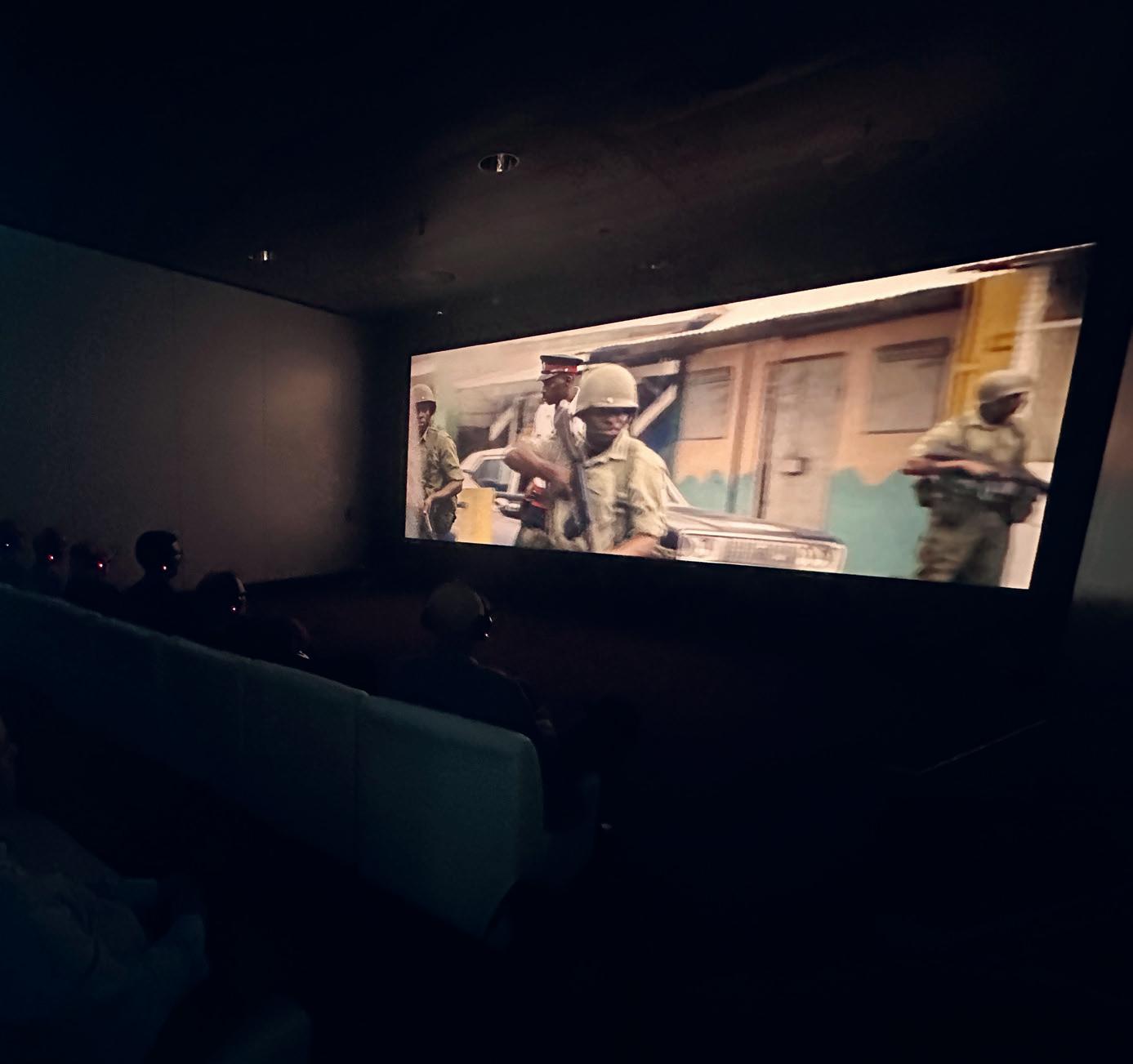
efficiency as well as quality, reflecting exhibitors’ interest in technology that is both high-performance and sustainable. Indeed, making cinema tech more eco-friendly is a clear trend: lasers eliminate the waste and high energy costs of xenon lamps, a point underscored by Barco’s ongoing laser conversions for European circuits to shrink their carbon footprint.
The show will also spotlight advancements in immersive sound, automation, and experiential seating. Vendors will demonstrate the latest in surround audio and theatre management systems that can automate projection and operations. Attendees can sample luxury recliners and motion seating like 4DX and D-Box, with suppliers promoting how these multi-sensory experiences give audiences something home viewing cannot. Across the board, the focus is on innovations that make cinemas more engaging, efficient, and accessible – from brighter 3D images and booming sound, to energy savings and new accessibility tools.
Honouring Excellence in Exhibition
CineEurope is also an occasion to celebrate leaders in the cinema business. During the opening ceremony, France’s Pathé Cinémas will receive the 2025 International Exhibitor of the Year Award for its
commitment to modernising cinemas and delivering premium experiences. UNIC’s Achievement Award will go to Tomasz Jagiełło, CEO of Poland’s Helios circuit, recognising his contributions to cinema expansion in Central Europe.
Later in the week, a special Milestone Award will honour Germany’s Kinopolis for 120 years of cinema history and continual innovation. CineEurope’s Gold Awards will also salute top film distributors and other industry achievers at a gala ceremony. Meanwhile, the International Cinema Technology Association (ICTA) will host its own seminar and awards on the eve of the convention, highlighting excellence in cinema technology and design – including naming Emotion Kino (Monheim, Germany) as 2025’s best new-build cinema.
With product launches, expert panels and awards, CineEurope 2025 will provide a comprehensive snapshot of the exhibition industry’s health and innovation. As cinemas continue to evolve, this gathering in Barcelona offers a vital opportunity for exhibitors and suppliers to exchange ideas on enhancing the big-screen experience. Cinema Technology Magazine will be on the scene to report on the highlights – from keynotes to tech demos – as Europe’s cinema community comes together in June.
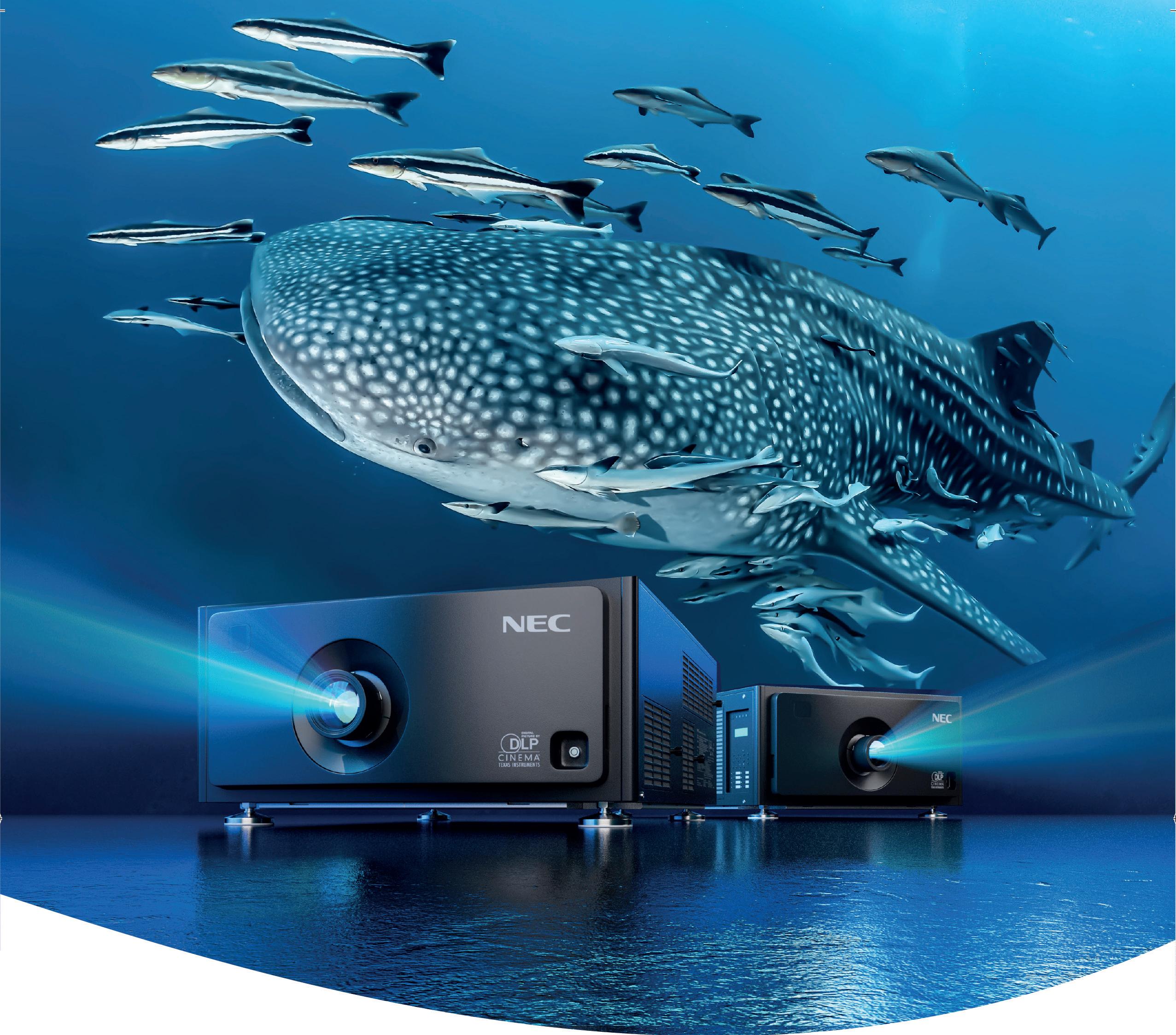
Visit us at

June 16th-19th, 2025
Be Seen, but not heard
NC603L Digital Cinema Projector Silent, Sealed, Sustainable
With an unrivalled noise level of less than 39dB, at 6,000 Lumens the new super-silent NC603L Laser Projector is delivering captivating movie experiences, ideal for boothless cinemas.
Incorporating the latest highly efficient Laser technology achieving a low power consumption of just 0.89kW, with a sealed engine for advanced dust protection, impressive 50,000 hours Laser lifetime and legacy interchangeable lenses, the NC603L safeguards low cost operation and long life sustainability.
sharpnecdisplays.eu
